High Adventure Expeditions
- Mount Everest Expedition 2022
- Mount Everest Base Camp Trek 2022
- Everest Gear List – 2021
- Island Peak
- Destinations
- Testimonials
- Mount Everest 2016
- Himalayan Expedition 2013
- Mount Everest 2012
- Mount Everest
- Meet Your Team!
- In The Media

How Much Does It Cost To Climb Mount Everest?
- Why Does It Cost So Much To Climb Everest?
- Can Anyone Do The Everest Base Camp Trek?
- What’s It Like To Climb Everest?
- How Many People Have Climbed Mount Everest?
- What Is The Weather Like On Everest?
- The Sherpa People
- Trip Resources
- Mount Everest Statistics
- Full List of Mount Everest Climbers
- List Of Women Who Have Climbed Mount Everest
- List Of Indian Mountaineers Who Climbed Mount Everest
- Winter Ascents of Mount Everest
- Mount Everest Expedition Application
- Join Us On A Climb Or Trek!

As of 2021, the average cost for a place on a commercial Everest team, from either Tibet or Nepal, is US$44,500. A minimalist attempt to climb Everest could be organised for about US$20,000. At the very upper level, the private climb option on Futenbach’s “signature expedition” comes with the hefty price tag of US$200,000.
The minimalist option would suit high-altitude mountaineers who possess extensive experience above 8,000m, and are used to solo-climbing, expedition planning, and operating in the area known as the death-zone.
At the more expensive price point, the Furtenbach team which climbs from Tibet charges US$60,900. A place on the US Alpenglow team costs US$85,000. IMG’s “private climb option,” which includes a personal western guide for each climber, has an all-in-cost of US$118,000. The private climb option with the RMI team tops out at US$135,000. Furtenbach’s “signature expedition” with private guide, extremely experienced Sherpas, pre-acclimatisation, unlimited oxygen tanks, nutrition and training plans, and other services takes the most expensive slot at $200,000.
As a general rule, the higher the cost the more services that are provided; however, such a fact should not be relied upon blindly. These additional services would include such items as:
- higher ratio of experienced, western guides
- additional Sherpa support
- extra oxygen bottles which can be used at a greater flow rate
- specific dietary requests
- larger Base Camp tents
- more communication equipment
- provision of pre-acclimatisation tents to be used in the 6 weeks before travel.
So that you can better understand where the headline dollar figure comes from, the table below gives a breakdown of typical costs for an Everest expedition.
Cost to Climb Mount Everest in 2021 – Full Breakdown:
You can check out the latest details for our Mount Everest Expedition here .
You’ll find the application form for our Everest Expedition here .
In this section
© 2024 High Adventure Expeditions. All rights reserved.
Delicately crafted using Franz Josef theme and WordPress.

- Best Hikes In The World
- Appalachian Trail
- European Hikes
- Nepal Hikes
- Patagonia Hikes
- See All Hikes
- Mount Kenya
- Mount Kilimanjaro
- Mount Toubkal
- See All Mountains
- South Africa
- New Zealand
- Switzerland
- United Kingdom
- Packing Lists
How Much Does It Cost To Climb Mount Everest? The Price To Summit
In the 21st century, reaching the highest peak in the world is no-longer reserved for hardcore climbers. In the last few decades, modern equipment and a booming mountaineering industry has opened up the Himalayan peaks for mountaineers from around the globe. Before you start packing, you might be wondering how much does It cost to climb Mount Everest ?
Although popular, climbing Everest is no easy feat and this is reflected in the price. Depending on which guide company you use, a Mount Everest expedition will cost you anywhere from $30,000 to $100,000. In the sections below, I’ll break down the cost to climb Mount Everest by component. This will give you a rough idea of the cost to plan your own expedition and also help you understand why guide companies hit you with such a hefty price tag.
Average Cost To Climb Everest
When planning your Mt Everest Climb, there are a few options for expedition style. Most people use a mountaineering agency (either Nepali or International) to arrange all the logistics. You could also take the 'purist' approach and organize your own expedition.
Below I outline the different climbing options and approximate prices.
Sherpa Supported Tours With Local Operators
This type of expedition option does not include a guide. It does however include logistics, group gear, transport, food, and (usually) permits. On a Sherpa-supported climb, the lead Sherpa will go with you to the summit but you will be ultimately responsible for decisions and safety along the way.
This option is only suitable for experienced mountaineers or groups who are bringing their own experienced guide. There is also no guarantee that the Sherpas speak good English. Sherpa Supported climbs cost from $30,000 per person .
Full Board Everest Climbs (with local operators)
These types of expeditions are usually with a registered guide or lead Sherpa. Sherpas from Nepali companies often have equal, if not more experience than Western guides. Guided expedition prices usually cover all logistics including food, sherpas, oxygen, group gear, admin fees and permits.
You will be led by an experienced Sherpa/guide who speaks good English. The guide will take responsibility for the climb and act as a leader to the group. They will handle summit decisions and safety aspects.
Expect to pay between $45,000- $50,000 per person Note: Cheaper tours take bigger groups and split them into smaller parties for summiting. This may mean you have less chance of a successful summit as you will need to rely on good weather on your group’s allocated day.
Guided Everest Expeditions With International Agencies
International companies used to dominate the market of Nepal summit treks. Today, international companies have stiff competition from Nepali agencies. There are still some very well-established agencies operating from New Zealand, Germany, America, Argentina and the UK (amongst other countries).
The International agencies generally set themselves apart by limiting expeditions to smaller groups of around 10 people (sometimes a little bigger). Keeping the numbers low means the entire group can summit at the same time. This gives a few opportunities for summit days and optimal weather.
Some perks of higher-end companies include more comfortable accommodation and better meals. Some agencies provide WIFI in camps and an assigned medical doctor. Expect to pay at least $50,000 pp for international outfitters that employ the services of local guides. If you are wanting to go with a western/non-Nepali mountaineering guide, you will need to shell out about $20,000 extra in guide fees.
Can You Climb Everest Without A Trekking Company?
Technically, you can climb Everest without joining a commercial expedition but it’s not recommended unless you are a professional mountaineer with significant 8000er experience. For the average Everest client, climbing without the support of a reputable company is extremely risky. Moreover, sorting out your own logistics can be a nightmare. You will have to consider things like hiring Sherpas, buying supplies, oxygen, gear etc. More on this below.
Cost To Climb Mt Everest?
Here's a breakdown of the main expenses.
Everest Climb Permit Cost + Overheads
A Nepal permit to climb Mount Everest currently costs around $11,000 pp . Permits are issued at a price of $70,000 for groups of 7-10 people. If you did for some reason want to purchase an individual permit, this will cost you $25,000.
A permit grants climbers legal permission to be on the mountain and provides assurance for rescue in emergency situations. Also, should you reach the summit, you will receive an official certificate from the Government of Nepal.
But hold on, there are some other admin fees to consider…
Nepal government requires that a local operator organize your permit. This comes with a $2,500 fee plus a $4000 waste fee (which is refundable). You will also be paying a Liaison officer around $3000 per team. These officers are there to assist with climber communication, provide weather info and to enforce the strict rules about climbing Everest.
The above fees are usually included in the price when you book through a Nepali company. If not, you will need to have around $20,000 available before you even look at hiring a team and buying supplies.
Note: From the Tibet/Chinese side, Mt Everest permits are slightly more expensive between $15,000-$18,000 per person. This includes transport to base camp, yaks in and out, and all the associated admin fees.
Sherpas, Cooks And Supplies
Good climbing agencies keep the Sherpa-to-client ratio 1:1. Often extra Sherpas are needed as a backup at the high camps or to carry extra equipment.
Sherpa wages are in the realm of $5000 per Sherpa, per trip . If you want to privately hire a certified lead Sherpa, you will need to budget about $10,000. Cooks and helpers will cost an additional $5000 (a shared cost for the group). If you are budgeting for your own food and fuel supplies, it will cost around $700-$1000 per person for a 6-week expedition.
Gear Costs For Climbing Everest
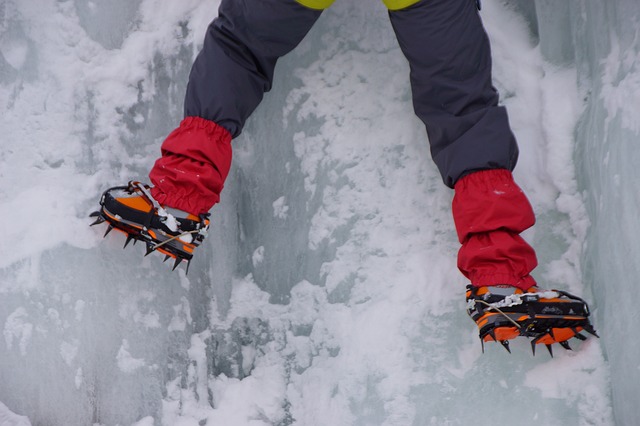
Even if you are climbing with a company, you will need your own alpine gear. This needs to be quality stuff especially designed for climbing in high-altitude environments. Some essential pieces include;
- Alpine climbing boots
- Thermal layers
- Sleeping bag suitable for temperatures below -20℃
- Full down suit
- Climbing gear (harness etc.)
Buying this gear new will cost upwards of $5000 . You can bring down the cost slightly by buying or borrowing secondhand equipment. Outdoor gear shops in Kathmandu sell used but good-quality Everest gear. You should however bring the basics, particularly your own boots.
Oxygen bottles cost around $300 and climbers are required to carry 4-6 bottles per person, that's another $1800 . On top of this, you will need an oxygen mask and regulator ( about $800 )
Climbing outfitter will generally provide tents, oxygen, masks, and regulators as well as all the staff’s equipment.
Insurance Costs For Climbing Everest
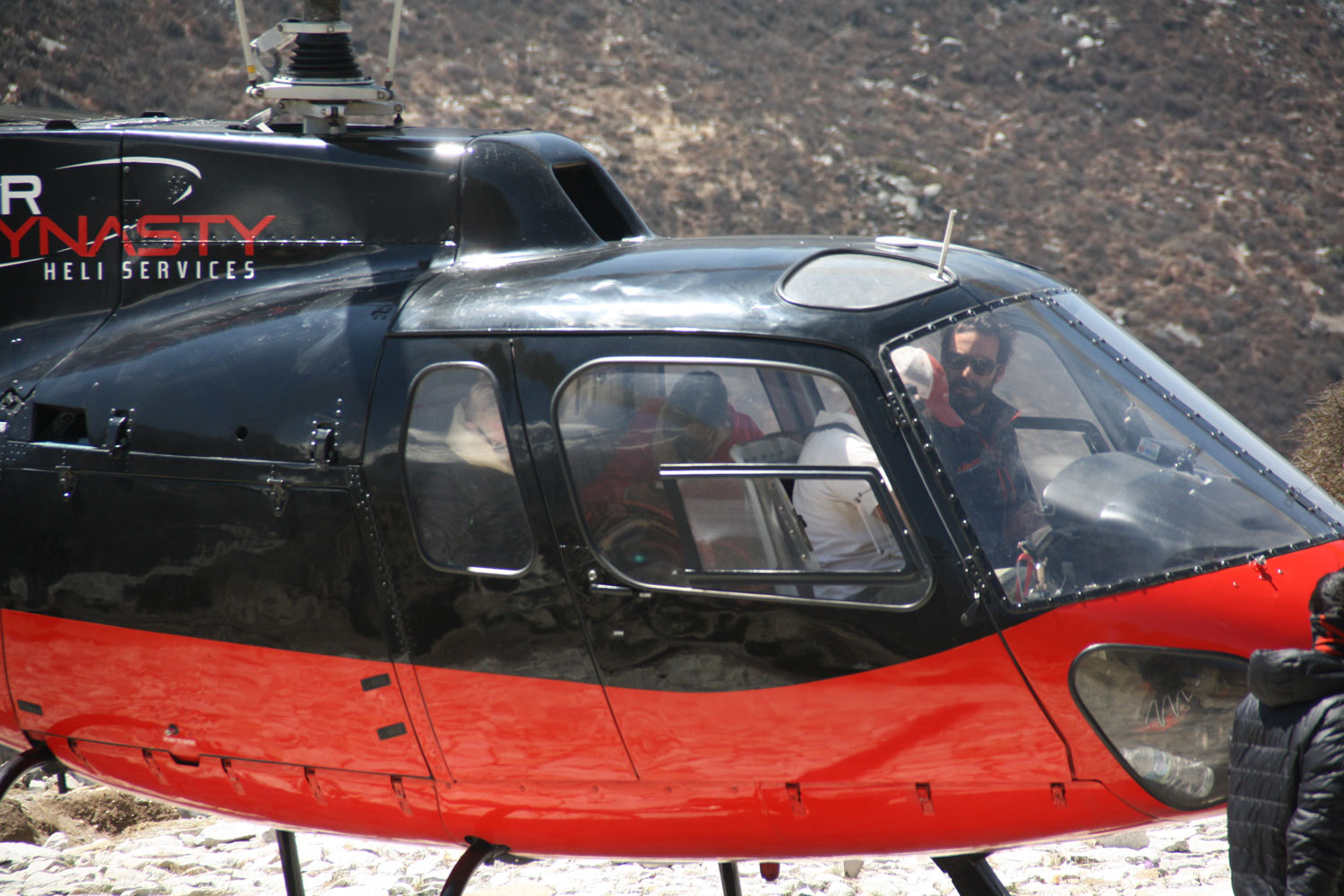
There are three important aspects of cover for climbing Everest; rescue evacuation, medical costs, and repatriation. At a minimum, companies will require that you have evacuation insurance. This can cost as little as $200pp - but will come with limitations. Adding medical cover will be a few more hundred dollars. Be sure you read the fine print and stick very strictly to the T&Cs or the cover will not pay out.
It’s pricey but, if you can afford it, it’s well worth adding trip cancellation cover. Full cover for all the aforementioned (rescue, medical, repatriation, and cancellation) will cost in the region of $3,000 - $10,000.
Other Considerations
Travel costs.
Flights into Nepal vary depending on where you are flying from. From Kathmandu, you will need to take an internal flight to Lukla, (approximately $200 with Tara Air ) From here you can make your way to base camp. You could save money by taking a bus to Jiri and hiking to Lukla.
Trek To Base Camp (Food And Accommodation)
From Lukla, It’s an 11-12 days trek from Lukla to Everest base camp . You must factor in accommodation at Nepal tea houses and meals along the way. Rooms cost between $5-$15 dollars depending on whether or not meals are included. If you are not paying full-board, tea house meals cost about $5 -$10. This means it actually works out cheaper to include meals.
You can save some money by camping and cooking your own meals. If you want to camp and still buy meals from tea houses, you will be charged more than double the rate of staying guests.
As you will be carrying equipment for a summit attempt, you will likely need to employ the services of yaks ($40 per day) and Porters ($20 per day) for your journey to and from base camp. Plus, you will pay a park fee of $100 per group.
Generally, it will cost you between $600- $1000 (excluding flights) to get to EBC independently. Read more about the costs of trekking to Everest Base camp
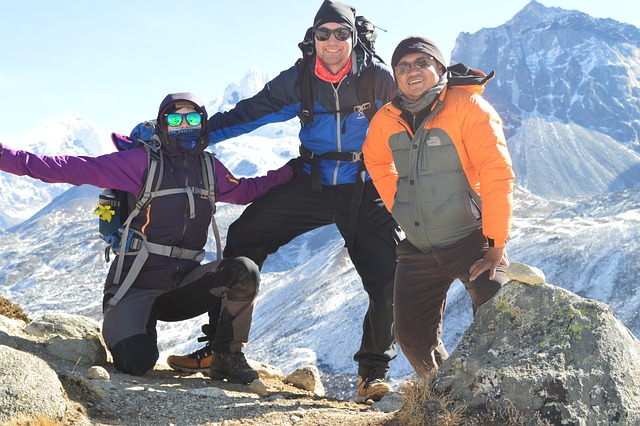
As a rule of thumb, tips should be anything from 5%- 20% on top of wages. You should budget between $400-$3000 + per individual . Guides usually receive the lion’s share but don’t neglect the hard-working Sherpas, cooks, and assistants.
Of course, tipping is optional but it’s very much a part of Nepali tourism culture. Remember, your team is going to play a big role in keeping you safe and making your Everest summit dream a reality. They deserve some recognition above and beyond what’s basically a minimal wage.
Climb Mount Everest In Luxury
On the higher end of things, it’s possible to give your Everest climbing expedition a serious upgrade. Some companies offer add-ons including luxury hotel stays, private bathroom and dining quarters, helicopter flights to and from Everest base camp, personal doctor and extra oxygen. Oh yes, and a personal photographer for some above-average summit shots!
If this sounds like your style, prepare to pay upwards of $130,000.
Why Does It Cost So Much To Climb Mount Everest?
As you can see from above, there are ton of overheads that you need to factor into the price of climbing Mount Everest. If you made the summit years ago and are wondering how it’s possible that prices skyrocketed, there is a pretty reasonable explanation; it boils down to supply and demand.
Better Pay For Sherpas
Sherpas are getting paid better than in the old days. Recent years have seen a huge rise in the demand for Everest summit climbs. This has created jobs for hundreds of more sherpas. To combat the mistreatment of these Sherpas, there was a big push for a standardized and fair wage structure.
Nepal companies are offering packages that are competitive with international agencies. Today, an experienced lead Sherpa can earn just as much as a foreign guide (and usually have more summit experience). Of course, some cheap outfitters are still guilty of underpaying their staff.
Increasing Everest Permit Fees
As for the permit fees, these have continued to rise with the number of climbers on the mountain. The money from permit sales is supposed to be used by the Nepali and Tibetan governments to keep the mountain in pristine condition.
By all accounts, this has not gone very well and Everest is famous for its high level of pollution. Even so, there have been a few expeditions in previous years where groups of Sherpas were sent up to the ‘death zone’ with the goal of clearing trash. With so much public scrutiny on the issue, we can only hope the Nepali government will enforce stricter waste policies.
The Cheapest Way To Climb Everest
Honestly, there is no cheap way to climb Mount Everest and prices are only escalating by the year. If summiting the world’s highest mountain is your dream, best get going as soon as feasibly possible.
You can save a little money through careful planning. For instance, as you near base camp, things like batteries and toiletries get a whole lot more expensive. Make sure you stock up with essentials at home or in Kathmandu.
Finally, it’s worth noting that Nepali companies are always willing to wheel and deal. You can usually negotiate their prices down a bit. Just be wary, if you are paying less, chances are they are cutting costs somewhere.
You may also like our article on Mount Everest facts .
About the author
Alison Macallister
With a degree in Nature Conservation and experience working with wildlife including the Big 5, Alison used to work as a guide for a 5-star safari reserve in South Africa. Today she is a full time traveller and editor for Mountain IQ. She has travelled and hiked extensively in South America, including many solo hikes in Patagonia, the Cusco region of Peru, Ecuador and Chile.
Leave a Reply
Your email address will not be published. Required fields are marked
Are the other 8,000ers similarly expensive? If not, which is the cheapest to ascent?
Hi Joseph, climbing any of the 8000ers requires a serious expedition and comes with a steep cost. Everest is the most famous which means there are more options between trekking agencies. Even the ‘easier’ mountains like Cho Oyu cost upwards of $30,000.
Hope that’s helpful!
We work with local guides to offer great value adventures at unbeatable prices.
- How to Tie a Tie
- Best Coffee Beans
- How to Shape a Beard
- Best Sweaters for Men
- Most Expensive Cognac
- Monos vs Away Luggage
- Best Luxury Hotel Chains
- Fastest Cars in the World
- Ernest Hemingway Books
- What Does CBD Feel Like?
- Canada Goose Alternatives
- Fastest Motorcycles in the World
This is how much it actually costs to climb Mount Everest
Towering approximately 29,032 feet over the Himalayas (and growing every year ), Mount Everest is the tallest mountain in the world. To date, over 6,000 climbers have reached its pinnacle. It takes years of physical conditioning and technical know-how to reach the top, even with the assistance of a team of sherpas to help you. And then there’s the financial outlay.
- What’s the total cost of climbing Mount Everest?
Cost of support
- Cost of food and transportation
Cost of permits
Cost of gear and equipment, cost of bottled oxygen, the cost of insurance, preparing for everest, frequently asked questions.
Permits, air transportation, gear, oxygen, ground transport, food, time off from work — it all racks up pretty quickly. Whether you’re thinking of heading there yourself or you’re just curious as to how much these daredevil athletes shell out for their trip, here’s our answer to the question, “How much does it cost to climb Mount Everest?”
What’s the total cost of climbing Mount Everest?
In 2019, The Manual interviewed mountaineer Alan Arnette and mountaineer/guide Garrett Madison of Madison Mountaineering to find out just how expensive it is to climb the world’s highest peak.
“The average price paid in 2017 [was] around $45,000,” Arnette said. “The price range for a standard supported climb ranges from $28,000 to $85,000. A fully custom climb will run over $115,000 and those extreme risk-takers can skimp by for well under $20,000.”
- Delta is the latest airline to increase baggage fees — here’s how much every major airline charges now
- How being stinky when hiking in the deep woods might actually save your life
- Cost to climb Mount Everest is skyrocketing because people keep dying
Keep in mind the final cost varies widely because every climber’s needs are different. “Typically, this includes transportation from Kathmandu or Lhasa, food, base camp tents, Sherpa support, and supplemental oxygen. But with such a wide range, there are many caveats, such as a personal Sherpa, Western guides, tips, food, and tents on the upper mountain,” Arnette continued.
The cost to climb Mount Everest has continued to skyrocket since we last checked in with Madison 2017. Taking a trip up Everest in 2024 will cost you anywhere from $30,000 to $160,000, with the average falling somewhere around $50,000.
The cost of support (i.e., Sherpas) for climbing Everest depends on how comprehensive you want that support to be. If you are looking to go the “full service” route, you can expect to pay at least $45,000 and up to $160,000.
When it comes to climbing assistance, Sherpas are a key part of almost every Everest expedition. Sherpas are extremely hard-working Tibetan people who live on the slopes of the Himalayas and assist Everest climbers with various tasks, including cooking, carrying gear, and making crucial decisions. While hiring a Sherpa is not required for climbing Mount Everest, it can help increase the odds of reaching the summit — and it’s a service that many decide is well worth the investment.
A personal climbing Sherpa will cost anywhere upwards of $5,000, while a Sherpa for loading and unloading starts at $3,000, and a Sherpa that provides cooking starts at $2,000. Keep in mind climbers are expected to cover bonuses and tip Sherpas generously, too. Obviously, this is one area you don’t want to cheap out.
Cost of food and transportation
The cost of travel to Mount Everest can vary greatly, depending on the climber. The cost of your flight, which airline you choose—not to mention the week-long trek to base camp—will all contribute to total transportation cost of climbing Mount Everest. The trek alone costs about $4,000. When it comes to food on Mount Everest, you can expect to spend $20 to $30 per day.
Permits are one of the biggest expenses of climbing Mount Everest, and it’s a cost you simply can’t avoid. There are, however, two different ways to approach Everest, with two different prices: the Northside in Tibet and the Southside in Nepal. The permit in Nepal costs $11,000 (plus $2,500 to hire a local company to organize the permit), plus a $4,000 (refundable) trash permit, $2,500 for a local Nepalese team to organize your permit, and a final $3,000 per team for a Group Liason Officier. So just getting the proper paperwork in order costs close to $20,000, and that’s before all of your other costs.
From the Tibetan side, China recently eliminated the relatively more affordable solo climber option. Everest hopefuls must now travel in groups of four or more. Permitting costs now run between $15,800 and $18,000 per person in a group. That fee does include some things, however, like ground transport, yak support, trash fees, hotels, and liaison officer fees.
While the permit prices for Everest are not cheap and might make you think twice about a climb, they’re in place for good reason. Every year, the number of Everest hopefuls continues to rise, often at the expense of the experience, quality of life for locals, and the environment. Pricey permits help to mitigate these downfalls by putting much-needed monetary resources toward protecting the environment, cultural heritage, and livelihood of locals.
If you want to reach the summit of the world’s tallest mountain, you can expect to spend between $6,000 and $8,000 on gear.
You’ll need climbing gear, of course, like crampons, an ice ax, and a belay; technical clothing, including a down coat, a good mix of base layers, and hiking/trekking pants ; and camp equipment, including a sleeping bag, an extreme-weather tent , and a thermos.
While the gear list is both extensive and expensive, the good news is, that you can start with what you already have before investing in new items. If you’re already an amateur outdoorsman, chances are you already have the basics, like base layers, good hiking socks , moisture-wicking T-shirts, and a windbreaker. Starting with these items is a big help considering the entire list is pretty extensive. You can find a thorough Everest packing list here , provided by Madison Mountaineering.
The need for bottled oxygen is just another reminder that Everest is not your everyday hike . An essential item on any Mount Everest packing list, supplemental oxygen is also one of the most expensive. While summiting Everest without oxygen is possible, it includes severe risks like extreme hyperventilation and respiratory alkalosis. It’s not for the faint-hearted.
The average Everest climber will use five to six oxygen bottles, each costing nearly $600. Climbers also need an oxygen mask and regulator, which cost another $600. Keep in mind, climbers are also required to supply oxygen for their Sherpa, if they’re hiring one.
Since the climb to the summit of Mount Everest is so dangerous, it should really come as no surprise that you’re going to need insurance to cover you against any issues that may arise. Most climbing companies will require you to purchase special insurance before you set out. According to Climbing IQ , the basic insurance, known as evacuation insurance, will cover an emergency rescue and evacuation from the mountain if you get injured or ill during the climb. The cost for this insurance can be as low as $200 per climber, which is cheap, considering a helicopter evacuation from Everest can cost tens of thousands of dollars if you’re not insured.
There are also options to cover more than just evacuations, a full coverage package, which covers rescue, medical care, and trip cancellation. These packages can cost anywhere from $3,000 to $10,000.
The financial cost of climbing Mount Everest is just the tip of the iceberg. If you’re seriously considering checking out the view from 29,032 feet, you should also prepare for the immense physical and mental costs. Your regimen leading up to your Everest trek will include rigorous workouts, breathing exercises, visualization practices, and lessons on overcoming negative self-talk.
Sky-high costs aside, climbing Mount Everest will undoubtedly challenge you and leave you feeling on top of the world ( literally ). Many climbers who have achieved this incredible feat assert the feeling as indescribable, but one word seems to sum up the experience best: Priceless.
Why is it so expensive to climb Mount Everest?
The explanation for why it’s so expensive to climb Mount Everest—anywhere from $30,000 to $160,000—has to do with the sky high prices for transportation (flights and the trek to basecamp), support (Sherpas), climbing permits, gear and equipment, bottled oxygen, and insurance.
Permits tend to be among the biggest expenses associated with climbing Everest: A permit in Nepal costs $11,000, plus $2,500 to hire a local company to organize the permit; a $4,000 (refundable) trash permit; and a final $3,000 per team for a Group Liason Officer. These costs alone can total close to $20,000.
How much do Sherpas get paid on Everest?
A personal climbing Sherpa for Everest will cost upwards of $5,000, while a Sherpa that handles loading and unloading starts at $3,000. A Sherpa for cooking costs about $2,000. That’s just the baseline cost for their services, however; climbers are expected to pay out bonuses and tips to Sherpas as well.
Is it free to climb Mount Everest?
Climbing Mount Everest itself is far from free. Apart from the high transportation costs (flights, trek to base camp), gear, support in the way of Sherpas, bottled oxygen, and food, there’s also pricy permit cost from the Nepalese government, which as of 2024 costs $11,000. What’s more, these permits are set to increase $15,000 in 2025, a 36% increase.
Editors' Recommendations
- Here’s how much it will cost you to charter a Four Seasons private jet
- This is the gross new thing anyone climbing Mount Everest will have to do
- There are actually 8 continents, and scientists have finally mapped the one that’s (mostly) hidden underwater
- How to tie the double fisherman’s knot (it’s not just for rock climbing)
- How well does your home state rank for adventure? Study reveals the best and worst states
- Destinations

Deep in the heart of Southern Florida runs US 41, also known as the Tamiami Trail. This engineering marvel runs through the swamp, creating the northern border of Everglades National Park, home to many natural areas that feature a variety of outdoor sports including hiking, canoeing, boating, fishing, backpacking, and trail running. The Everglades is an emerald-green natural wonder filled with beauty and wildlife that makes it one of the most iconic places to visit in Florida.
Located right in the middle, 40 miles west of Miami (ending at the appropriately named Fortymile Bend), is Loop Road, a 20-mile scenic trail that is sure to whet the appetite of any outdoorsman who travels it. Most of the road is unpaved and undeveloped, surrounded on both sides by a sea of green that is home to diverse wildlife. It is a great way to get a taste of the Florida Everglades or start a serious trek into the swamp.
When wildlife photographer Aaron Teasdale set up his camera to capture the release of a grizzly bear back into the wild, he wasn't counting on the bear having other ideas. It's not every day that we witness a grizzly bear attack firsthand. We understandably try to avoid an encounter becoming an attack, and people encountering a grizzly in the wild are too preoccupied to think about their Instagram followers. While we might have seen these majestic creatures moving across the plains and even chasing down prey, this new video shows what it would be like to experience a grizzly bear attack. I'll give you a hint: it would be pretty darn terrifying.
The prospect of standing on top of the world has lured thousands of mountain climbers to Mount Everest since the first successful attempt by Edmund Hillary and Tenzing Norgay 70 years ago. Commercial expeditions began in the 1990s, and since then — not counting the 2015 season disrupted by the catastrophic earthquake or the recent Covid-affected seasons — the number of climbers has increased dramatically.
Climbing Mount Everest may be popular, but the difficulty of reaching the highest point on earth should not be underplayed. Ignoring the hefty price tag associated with an Everest expedition, there's the sheer physical exertion of climbing to that altitude. Unless you plan to recreate Killian Jornet's feat of summitting twice in one week without supplementary oxygen — don't try this — then you'll need to set aside serious time for your ascent to the top of the world. So exactly how long does it take to climb Mount Everest?
2-FOR-1 GA TICKETS WITH OUTSIDE+
Don’t miss Thundercat, Fleet Foxes, and more at the Outside Festival.
GET TICKETS
BEST WEEK EVER
Try out unlimited access with 7 days of Outside+ for free.
Start Your Free Trial
Powered by Outside
How Much Does It Cost to Climb Everest? 2021 Edition
Longtime everest chronicler alan arnette looks at how much it actually costs to climb mount everest, whether you do it on a "shoestring" budget or book the swankiest expedition out there. from the costs of travel to food to supplies to guides, it's all broken down here.
This will be my 19th season of all-things Everest: 12 times providing coverage, another four seasons of actually climbing on Everest and two years attempting Lhotse. I did similar coverage for the 2004 , 2005 , 2006 , 2007 , 2009 , 2010 , 2012 , 2013 , 2014 , 2015 , 2016 , 2017 , 2018 and 2019 seasons. In 2020, I did a fictitious Virtual Everest series that’s available as an e-Book . I summited Everest on May 21, 2011, and have attempted Everest three other times— 2002 , 2003 , 2008 , and Lhotse in 2015 and 2016 .
2021 is my ninth year writing, “How much does it cost to climb Mount Everest?” With the Covid-19 pandemic devastating tourism across the globe, I expect this year to be somewhat quiet. In fact China has closed Tibet to all foreigners. There may be some Chinese nationals climbing on Everest, but I don’t expect a lot.
So, how much does it cost to climb Mount Everest? As I’ve said for years, the short answer is a car or at least $30,000, but most people pay about $45,000, and some will pay as much as $160,000! But the prices are going up, and I don’t know where it will stop. So if you are on a tight climbing budget, go as soon as your skills, experience, and checkbook can support a safe attempt.
Big Picture — Higher Prices from Everyone!
The headline for 2021 is a significant price increase from the traditional operators and for the first time from the Nepali companies. The reason behind these increases is murky at best. In 2019, China enacted many new rules and raised the permit price—operators just passed this price hike along to their clients. But the Nepal side is a bit of a mystery, especially with the price increase by local operators. My best guess is that they realized they could charge more and not hurt business. However, Nepali operators have always been willing to deal and haggle, so take their list prices as an opening bid.
This is the breakdown of current median prices by style and route. I’ll go into more detail later in this article, however you can easily see how much the prices have increased on both sides, for all styles:
As for safety, people die on both sides of the mountain. Most of the deaths these days are due to inexperience and not who you selected as your guide. However, choosing a competent guide could save your life. The 11 deaths in 2019 tragically demonstrated what happens when inexperienced people go with unqualified guides.
Bottom line for 2021: Look for a mixed bag on Everest, with a quiet Tibet side and uncertainty on the Nepal side. Kathmandu will be confusing, potentially deadly, as will Everest Base Camp with the pandemic still ongoing.
Everest 2020 Review
The Covid-19 pandemic shut down mountaineering worldwide. Almost all of the Seven Summits saw zero visitors with the exception of Kilimanjaro and the Chinese side of Everest. There may have been a few other climbs here and there, but nothing like in 2019.
Nepal and China “cooperated” to remeasure Everest and reported a revised height of 8,848.86 meters/29,031.69291 feet, or a 0.86-meter/33.85827-inch increase! China sent a survey team to their side of the mountain in 2020 along with a small national team. There were 28 summits.
Everest 2021 Outlook
I’m not 100% sure what to expect for Everest 2021. Several major guide companies have cancelled their entire season due to Covid. They include: Adventure Consultants, Adventures Global, Alpenglow, and Mountain Madness. But I’m not aware of any Nepali companies refusing business, and many of the longtime guiding outfits like International Mountain Guides, Alpine Ascents, and Austria’s Furtenbach Adventures are still going. However, China has said that Tibet is still closed to foreigners, thus all Everest climbing this spring will be on the Nepal side—and that could create crowds.
A disturbing pattern we have seen over the past several years are inexperienced clients with unqualified guides. This combination was one of the primary reasons for the nightmare line of people between the South Summit and the Summit in 2019. A client had no idea how to handle the altitude and went too slow, and that climber’s guide had no idea how to manage the client; the result was the whole system came to a standstill. Absolutely nothing has changed since then and it won’t surprise me if we see something similar this year.
As always with mountaineering, weather is the biggest wildcard. In 2018 there were 11 straight days of winds under 30 miles-per-hour, which allowed the crowds to spread out. There were no major issues high on the mountain that year. However, the next year, 2019, there were only three suitable summit days and that forced over 600 people to try for the top in just 72 hours.
In keeping with the trends from the past few years, look for more climbers than ever hailing from China and India . As I’ve detailed in the past, China requires all Chinese Nationals to have a summit of an 8,000-meter peak before climbing Everest from the Chinese side, so many simply go to Nepal where there are no such requirements. As for the Indian climbers, it has become folklore that if you summit Everest you can leverage that into fame and fortune—a huge miscalculation by so many—but many Nepal- and India-based guide companies have emerged to meet this market demand. These companies have also created profitable businesses running training programs for the under-20 crowd, and then taking them to Everest—a deadly gamble that may backfire one day.
In terms of danger and risks , 2019 was a deadly year on the 8,000-meter peaks. There were 11 deaths just on Everest plus, another 10 on other 8000-meter peaks. Sixteen of the 21 deaths were climbers on trips run by the low-price budget operators. We can expect similar results in 2021 as these low prices are attracting a new demographic of climbers who simply don’t know what they don’t know. The operators are glad to take their money.
Between the pandemic and turmoil in the Nepal Government, no new rules were announced for climbing Everest in 2021—a pleasant change from their recent history of ginning up the climbing community with promises of a cleaner, safer environment with rules that are never implemented. Bottom line for climbers this year: Triple-check with your evacuation company that you are covered for Covid-19 with the guide service you use. Also, be prepared for some type of quarantine upon arrival in Kathmandu. But don’t expect it to be serious: As usual, Nepal likes to talk big but not enforce their own rules.
Everest 2019 Review — The Year Everest Broke
In 2019, the last full year for summits, there were approximately 871 summits on Everest in the spring plus 11 deaths. The all-time number of people who have ever summitted Everest is now 10,155 (this includes multiple summits in one season by one person). The death total stands at 306. Still, Everest is one of the safest 8000ers.
2019 was all about the weather. The notorious jet stream was “wobbly” in the words of Chris Tomer of Tomer Weather Solutions . It colluded with Cyclone Fani to delay the ropes reaching the summit, complicated by some bureaucratic delays on using a helicopter to transport gear to Camp 2 on the Nepal side. Everyone hoped it would be like in 2018 with 11 straight days of low winds that allowed for a record number of summits.
On the Nepal side, the ropes finally made the top due to some incredible efforts by a team of Sherpas. One-hundred-fifty clients with their Sherpas quickly followed over the next few days before the jet stream returned. When the next window appeared, close to 800 people made their summit bids, but still the weather forecast felt like a dice throw praying for cat’s eyes. Beginning on May 22, hundreds summited early each morning for several days—and once again death was in the air. On May 23, Nirmal “Nims” Purja secured his place in history (he has since done so numerous times over) with a shocking photo of a line of climbers on the Hillary Step. The root cause of the lines were slow climbers with guides who failed to properly manage their clients.
How 2019 unfolded was predictable. In 2018, Everest hosted a record 802 people on her summit from both sides. The death toll was five, about the same as it had each year for the prior 10 or so. They died from what people usually die from on 8000-meter mountains: altitude sickness, exhaustion, health issues, and the occasional fall. All tragic, but all not unexpected. But in 2019 with 11 deaths, over half were what I term “avoidable.”
I’ve been writing about two major trends that have been rising and reached a crescendo in 2019: inexperienced climbers and unqualified guides. These two factors along with a “wobbly” jet stream and record 381 foreigner permits issued by Nepal conspired to create a deadly combination of independent factors during the peak of a truncated weather window in late May.
Six months after the spring season, the biggest question is: What, if anything, will Nepal do about the crowds, the experience of the climbers and the qualifications of the guides? While there are solutions, I’m not optimistic anything will change in the near term. For more details, please see my complete 2019 Spring Wrap-Up .
Everest 2019 Results
These data are from the Himalayan Database.
Where Does My Money Go?
There are four major components to any Everest climb regardless of whether you’re climbing from Nepal or Tibet: travel, permits/insurance, supplies/gear, and guides. For 2021, there are no major changes. Even though the Tibet side is closed, I’ll still cover it here.
The following discussion breaks down the expenses as if an individual wanted to climb without joining a team but almost no one does this as the numbers will show—it is just too expensive or risky. While I know there are individuals who have climbed on the cheap in years past, few if any have in the last five years.
1. Travel: $500 – $10,125
The travel costs are entirely dependent on where you live and how you like to travel. It can range from a few hundred dollars to over $7,000 to fly to Nepal. Most people use Thai, Turkish, Qatar, Air India, or China Eastern to reach Nepal.
Once in Kathmandu, you need to fly to Lukla, Namche or Lhasa to start the journey to base camp, so add in a few hundred dollars for this internal flight. Of course, you can take a bus to Jiri and trek 5 days to Luka and then on to Everest Base Camp (EBC) to save a little money.
From Lukla, it takes a little over a week to trek to base camp. Add in food and lodging along the way for you and your support team. This can be between $400 to $1,000 per person in total, again depending on your style and how many beers you have. Teahouses have dramatically increased their prices in the Khumbu. You can still find the $5 per night teahouse but expect to pay $15 for each meal. To save money, climbers can always camp in their tents and cook their own food. Many operators are planning to camp in 2021—avoiding the teahouses altogether—due to Covid.
Not only do you have to get yourself to base camp but also all of your gear: tents, food, oxygen, etc. Most people use porters and yaks costing at least $20 per day per load, so this usually totals over a $1,000. Large operators will hire helicopters and the expense is bundled into the overall price.
On the Tibet side, all transportation is included in your climbing permit and monitored by the government. The China Mountaineering Association (CMA) will meet you where you arrive in China and never leave you unchaperoned throughout the entire expedition.
Travel: $2,450 – $8,350
- Airfare: $1500 to $7000 depending on class and routing and excess baggage
- Transportation Kathmandu to Lukla :$350 round trip per person
- Hotel and food in Kathmandu: $300 to $700 depending on delays
- Nepal Visa: $100
- Immunizations: $200
Getting to EBC: $1,240 – $1,800
- Yaks to and from Base Camp: $40 per yak per day carrying 120 lbs (4 yaks for 4 days, minimum or $640)
- Extra Yak in China: $300/Yak
- Porters to and from Base Camp: $20 per porter per day carrying 60 lbs (3 porters for 6 days, minimum of $360)
- Tea Houses and food on trek to EBC: $20 – $100 per person per day (7 days, $140 – $700)
- Park Fee: $100 per team
2. Permits and Insurance: $9,950 – $29,500
The permit cost is fixed at $11,000 per climber from Nepal and simply gives permission to climb, whereas in Argentina for Aconcagua, or in Alaska for Denali, the $800 or $365 permit fee, respectively, contributes to the costs of maintaining high-altitude ranger camps, hiring seasonal staff, providing mountaineering information, and keeping the mountain environment clean. On Denali, the permit includes helicopter evacuation.
Nepal requires you to use a local company to organize your permit at a cost of $2,500 for the team, plus get a refundable trash deposit of $4,000 per permit, plus a Liaison Officer costing $3,000 per team. These fees total $9,500 BEFORE the $11,000 per person climbing permit. So before you hire guides, yaks, food or gear you must come up with almost $20,000 in Nepal.
Nepal implemented in 2013 a new rule that requires every foreign climber in Nepal to hire a local Sherpa guide. It is still there for the 2021 season. I saw climbers in October 2018 climbing peaks with zero porters or Sherpa support so this policy is enforced unevenly if at all. While very unclear how or if this rule is enforced for every operator, it would add a minimum of $4,000 to the absolute lowest cost. In 2017, one person who climbed without a permit was caught, deported and banned from climbing in Nepal for five years by the Nepal authorities. Both sides are cracking down on unauthorized climbing, so beware.
Most guide companies on the Nepal side will require at least evacuation insurance and most require medical coverage. One of the best investments you can make is to add trip cancellation to the policy. In both 2014 and 2015 when the Everest season ended early, those with trip cancellation/interruption coverage had 100% of their trip expenses reimbursed.
Travelex is a popular choice but expensive. To save money, joining the American Alpine Club will provide $7,500 evacuation coverage through Global Rescue, but only back to the trailhead where you must organize your own way to a hospital or home. Most people upgrade that basic coverage for a few hundred dollars. RipCord is another popular evacuation company.
With all these policies you must follow their rules exactly or you will not be covere—and I mean exactly , one misstep and you are not covered. Also, most do not cover search and rescue operations, and those that do have low limits. Finally, Nepal was requiring Covid-19 insurance but may drop that requirement before the season starts. However, many of the traditional evacuation companies will not cover you for anything involving or related to Covid-19, so once again, double check the policy and get everything in writing.
The Chinese have recently increased climbing permits for Everest which effectively eliminates the possibility of a low-cost single-person climb from Tibet for under $20,000 forcing climbers to team up with at least three other members. This is not a big deal for independent climbers since many guides are glad to have you on their permit for a small fee and not provide any support.
As I previously reported on, an Everest climbing permit from the Chinese (North) side is now between $15,800 to $18,000 per person for a team permit of four people or more. This price includes transportation from the entry point in China (usually Lhasa or Zhangmu–Kodari) to base camp, hotels, liaison officer, trash fee, and five yaks in and four yaks out per member. There is an extra charge of $200 per day per person for time spent in Lhasa.
If you want to bring a Nepali Sherpa to climb with you in Tibet, budget an additional $4,500 for each Sherpa’s “work permit” as required by the CTMA, plus their salary of $5,000.
The Tibet side is more complicated for evacuation insurance since a centralized team does the rescues. A person being rescued is on the hook for an unspecified and unlimited amount of money. Helicopters are not allowed but are rumored to be offered in the next few years, maybe by 2022. It would be wise to double check everything with your provider to understand the details when climbing in China.
Climbing Fees: $20,600 – $25,650 (Nepal)
- Nepal Agency fee: $2,500 per team (usually included in the total price from a guide)
- Nepalese Liaison Officer: $3,000 per team (usually included in the total price from a guide)
- South Base Camp Medical support from EverestER :$100 per person
- Nepal permit: $11,000 for each climber regardless of team size
- Chinese permit: Between $15,800 to 18,000 per person for teams of 4 or more. $4,500 for each Nepali Sherpa
- Nepal garbage and human waste deposit: $4,000 per team permit (refundable but not always)
- Tibet garbage and human waste deposit: $4,000 per team permit (refundable but not always)
- Icefall Doctors to fix route: $2,500 per team or $600 per climber
- Contribution to fixed ropes above Icefall: $200 per climber, higher on Tibet side
- Weather forecast: $0 to $1,000
Insurance: $70 – $3,000
- Evacuation Insurance: $70 (American Alpine Club); ~$500 (Global Rescue/TravelEx)
- Medical only: $500
- Rescue Insurance for any reason with medical insurance and trip cancellation coverage: $3,000 – $5,000 (TravelEx)
- Private pay helicopter evacuation from Everest South: $5,000 – $20,000 depending on start and end locations (not available on north, but planned)
- All insurance figures are representative and will vary widely with age, length of trip and total cost.
3. Supplies/Gear: $800 – $29,450
You will need to eat, stay warm and breath on your trip (97% of all Everest summiteers used supplemental oxygen).
You can cook your own food but most people use a Nepali cook and helpers at $5,000 for base camp and budget about $800 per person for food and fuel while climbing Everest over a six-week period.
Supplemental oxygen runs about $550 per bottle with a minimum of 5 bottles totaling $2,750. But you will also need a mask at $450 and a regulator at $450. You can carry your own extra oxygen to the high camps, but most people use the Sherpas to cache them at the high camps. When hiring a personal Sherpa, the standard is for him to climb on oxygen, albeit at a lower flow rate, so this will run an additional $2,000.
Finally, you will need climbing gear including boots, down suit, clothing layers, gloves, sleeping bags, packs and more. This will cost at least $7,000 if you buy everything new. High-altitude boots from La Sportiva or Millet run $1,000, a full down suit from Feathered Friends or Mountain Hardwear is over $1,000, and a sleeping bag rated to -20 degrees Fahrenheit is at least $600. You can often find lightly used climbing gear on eBay.
Miscellaneous: $7,750 – $17,000
- Full Medical kit: $500 to $1,000 (add $2,000 for Gamow Bag_
- Sherpas, cooks tips and bonus: $250 to $2,000++ per individual depending on performance and summit
- Personal Gear (down suit, high altitude boots, sleeping bags, etc): $7,000
- Satellite phone (own): $1,000 to $3,000 depending on usage
- Gear allowance for Sherpas: $2,000
EBC and High Camps: $3,800 – $8,800
- Tents: $3,000 new (sleeping, cooking, toilet, storage at 4 camps for 3 people)
- Cooks: $5,000 per cook and assistant for 6 weeks
- Food and fuel: $800 per person for 6 weeks
Climbing Support: $3,650 – $8,650
- Oxygen: $550 per bottle (5 bottles), $2,750 (doesn’t include costs to take to high camps)
- Oxygen Mask (Summit Oxygen): $450
- Oxygen Regulator: $450
- Climbing Sherpa: $5,000 per Personal Sherpa (with oxygen at $2,000)
See my current gear list.
4. Logistics (Guide Services): $30,000 – $85,000
With all the previous costs broken out, it can be overwhelming. Don’t despair: you can join a fully-supported or guided team that takes care of everything.
For decades, Western operators like Adventure Consultants, Alpine Ascents (AAI), Jagged Globe, Himalayan Experience (Himex), International Mountain Guides (IMG) and others have guided hundreds to the top of Everest for prices ranging from $40,000 to $65,000, all-inclusive.
But that is changing. In the last few years, there has been intense competition from Nepali-owned and operated companies. With many Sherpas having 10 or more summits of Everest, they are advertising themselves as Everest Guides and eliminating the traditional Western Guide who would be paid between $10,000 and $25,000. These cost savings are passed on to the expedition members. However, in 2021, we are seeing Sherpas receiving pay similar to Westerners so the price gap is much narrower today.
Still, some Nepali operators are well-known for underpaying their staff, thereby enabling them to offer climbs that are half to a third of the price of traditional Western operators. In 2019, Seven Summits Treks reportedly offered their Everest expedition for as low as $28,000 per climber. One common trend is that almost all the Nepali guides will privately negotiate and discount their trip prices, while most foreign operators will not.
Many of the lead Sherpas now have a subset of the UIAGM mountain certification (no ski qualification for example) and most have more summits than the Western guides. This certification is allowing the Sherpas to earn up to $10,000 for the Everest season compared to $4,000 to $5,000 previously. This trend will drive the cost of the Nepali companies up over time as more and more Sherpas become certified.
With all this as background, I used public websites and my own research to compile the 2021 Everest fees from the major Everest guide companies. I looked back at their 2019 summit rates and historical numbers where available using my own research, their websites and the Himalayan Database. Remember, there were virtually no climbers on Everest in 2020.
This is not a complete list of all guides and I did not look at small one-person operations or those that do not run climbs each year for more than one or two members. No commentary is implied by exclusion or inclusion on this list and is to be used for reference only. Check with the operator for details and questions.
Almost all guides increased their prices, but those operating on the Tibet side increased their fee an average of 18%, primarily driven by cost increases from the Chinese and new rules. The Nepal side operators increased by around 4%. A few operators had a massive increase of 25%! Without a doubt, climbing with a Nepali-owned company is half the price of a foreign operator with multiple western guides. Some foreign companies do offer Sherpa-led trips.
Prices usually include full logistics support, gear, food, Personal Sherpa guide, oxygen, oxygen-mask, and regulator. You can see my thoughts on Everest guides on my main site at Selecting a Guide .
2021 Expedition Price Chart
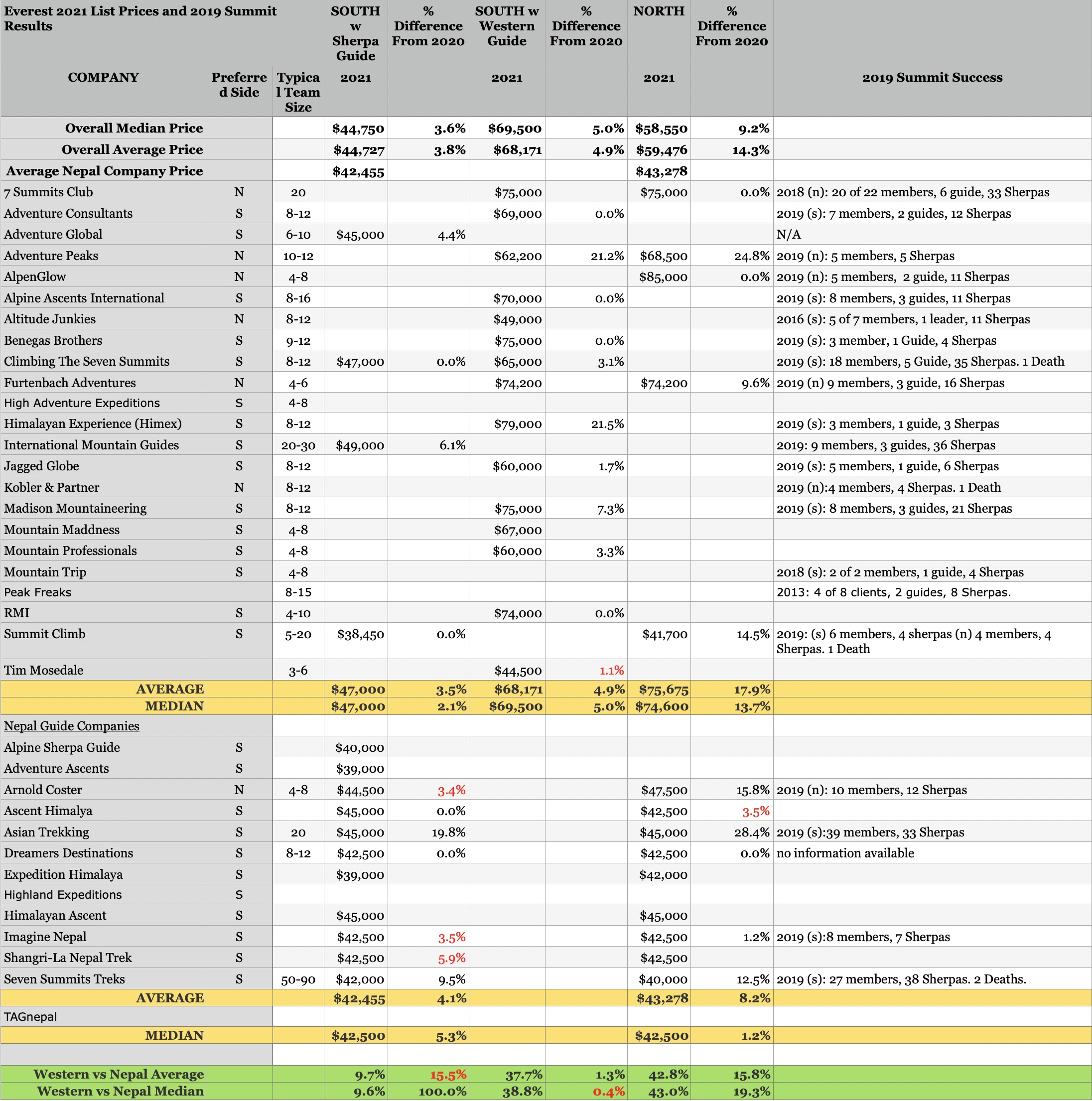
Who Guides on Everest?
Anyone can call themselves a guide in Nepal, however there are three options for supported climbs: Sherpa-supported, Sherpa-guided and a Western (foreign) guided commercial expedition. All leverage group costs such as deposits, cooks, and tents across multiple climbers. Let’s look at them in detail:
Sherpa-Supported Expedition
Please note this is Sherpa-supported— not guided—and what most Nepali-owned companies offer.
For about $42,000, you can climb on a Sherpa-supported expedition. This is about 4% higher than last year. The company organizes all the logistics—food, group gear, transportation—plus Sherpa support, but does not provide Western guides or, in some cases, even a lead Sherpa guide. The Sherpas may or may not speak English very well and will most likely follow your lead as to pushing forward or turning back once you’re on Everest.
You must be extremely careful when selecting among these options as some are excellent and others are lacking. A Sherpa will climb with you on summit night but you might be on your own with random teammates throughout the rest of the acclimatization climbing process, including preparing meals at the high camps. It is quite common to find yourself climbing only with a Sherpa or even by yourself. The Sherpas may have attended a climbing school, but will usually lack basic medical training and may not be of significant help in a health crisis other than getting you lower, which is substantial and often life-saving.
Asian Trekking specializes in this style of climb and is outstanding. Seven Summits Treks is another option at a lower cost and many small one-man Nepali companies offer even lower prices. Look to pay between $35,000 and $45,000 for this option. This is a good option for the climber with significant high-altitude experience, including previous Everest experience. It is not for the novice or first-timer on an 8,000-meter peak.
Sherpa-Guided Expedition
Please note this is Sherpa-guided , not supported.
International Mountain Guides’s (IMG) Classic Everest climb is a Sherpa-guided expedition that has an experienced Sherpa lead climber throughout the route. IMG ask $49,000 for this model. Climbing The Seven Summits offers a similar program for $47,000. Both companies have increased their prices $2,000 from their 2019 rates. Usually, they depend on a Sirdar (a highly experienced senior Sherpa) to make big decisions such as when to go for the summit or when to turn-around. Also, there is usually a Westerner overseeing the expedition in Base Camp, but not climbing.
A variation on this approach is to hire a Personal Sherpa for an additional $5,000 or even $10,000 (plus another 5% to 20% in tips and bonuses). These Sherpas have gained significant experience and training in dealing in one-to-one ratios with Western clients. Their English skills are usually very good., but—similar to a Sherpa-supported climb—they may lack medical training. Still, you will never climb alone.
While they will not carry all your gear, they may offload some items from time to time. They will be with you exclusively on your summit night even if you turn around before the summit. This style is appropriate for climbers with previous 8,000-meter experience and those who are unusually strong, but again not for the novice.
What do I get when I hire a Western Guide?
The Western-guided expeditions are “full service” trips and are most appropriate for first time Everest climbers or anyone looking for a bit more support. The cost varies widely ranging from $65,000 to $160,000. This includes all the services of a Sherpa-guided climb, plus sharing one or more western guides with other teammates. If you want your own personal Western guide, expect to pay $120,000 or more, plus tips and bonuses, which can bring the total up close to $175,000.
The major draw of this approach is you are climbing in close proximity to a Western guide who most likely has summited Everest several times. There is no language barrier and the guide will make all the decisions as to turn-around times, weather and emergency management.
On these higher-end expeditions, you will likely have a high quality of food ranging from better prepared to exotic. One service likes to promote their sushi, another their five-star chef. Then there are espresso machines, open bars—in other words, the sky’s the limit, all at a cost.
The most expensive guide companies (Adventure Consultants, AAI, Alpenglow, Furtenbach, CTSS etc) almost always come with several Western guides and you never climb alone.
Silly and Over the Top
Seven Summits Treks, which caters to the China market, has once again raised the luxury (and absurdity) level with their new “Platinum Everest Expedition 2021” for the sky-high price of $160,000. It includes:
- Private Camp facilitating: luxurious dining, communication and medical dome tent, work space, sleeping tent with king size bed, kitchen, hot shower and toilet at basecamp. Also, private camp at each high camp.
- AS350B3E airbus helicopter (Heli Everest ) will be on standby for supporting our team with supplying fresh – fruits, vegetables, meats , Mineral water for drinking and other food items all most every day, and it’s also always ready for your safety at your needs (medical evacuation ).
- One UIAGM certified Guide.
- 2-hour Helicopter Mountain view flight around the Mount Everest for filming and panoramic views of himalayan range
- Everest Summiteer Sherpa with at least 3 Everest summits (or equivalent).
- Unlimited supplementary Oxygen cylinders.
- 24-hour Personal mountain medical doctor for any injuries during the expedition.
- 24-hour satellite phone and internet facilities.
- Additional Lobuche Peak Climbing Package inclusive.
- A documentary movie of the entire trip with additional photographer from airport to the summit of Everest.
Let’s look deeper at a few questions.
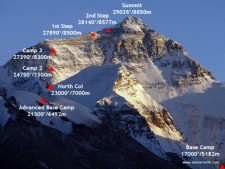
No. You can get a permit to climb any of the 30 named routes on Everest or make up your own. If you want to traverse from Nepal to Tibet or the other way, you will need to get permits from both countries however China has refused to issue permission from their side for many years now. In 2017 a climber illegally made the traverse and was deported and banned for 5 years. He claimed it was a medical emergency.
Can I climb Everest alone?
Officially, No. The Nepal Ministry of Tourism requires every climber to hire a Sherpa guide. The CMA has a similar requirement. But like everything around Everest, there are exceptions and most rules are never enforced.
What is the minimum I can spend to climb Everest?
As previously addressed, it is almost impossible to climb Everest completely alone on the standard route. However, you can climb independently with no oxygen, Sherpa or cook support but using ladders and ropes on the south side. For one person this would cost at least $25,000 from Nepal or China. Even splitting group expenses, the base costs add up to $26,000 each for a seven-person team. When you add in oxygen and base-camp support, a one-person climb with Sherpa support approaches $45,000 but a seven-person team leveraging the group costs comes in at $37,000.
Old-timers will brag about climbing Everest in the early 2000s or before for $5,000. Even then this price assumed no support, no oxygen, not contributing to the cost of the fixed ropes or ladders, no weather forecasting, etc. This post assumes most people want to climb in a relatively comfortable style and not eat rice every meal for six weeks.
What is the difference between a $30K and $65K Everest climb?
There is a real difference in offerings by some companies and very little with others, so it’s up to the climber to shop wisely.
The general rule is that the lower the price, the larger the team. At the high end, it is often profit, overhead, and the number of western guides. Also how many services are bundled into one single price versus offered as options. The lowest price outfits promote a low price and then offer “options” such as oxygen, Sherpa support or even food above base camp. One UK based outfitter offers a low price for the north side but does not include oxygen, summit bonuses or other options that almost every one includes in their base price.
Another common practice to keep expedition costs low is to pay support staff the absolute minimum whereas the guide companies pay a livable wage for their entire team. But often it is the availability of resources: extra Sherpas, back up supplies (ropes, tents, oxygen bottles, etc), medical facilities, communications and profit and overhead for the operator. One well known low-cost operator had their tents destroyed one year, had no backup and had to beg other operators for spares … they also ran out of food.
An example of price confusion is Sherpa’s bonuses. A low price service may not include a bonus whereas another may. For example, one Nepali company asks the climber to pay $1,500 to their Sherpa if they reach the South Col and another $500 if they leave for the summit. This is not shown as part of the base price. But a different company includes these bonuses in their overall package. In both cases, it is customary to tip your Sherpa, and western guide, an additional amount.
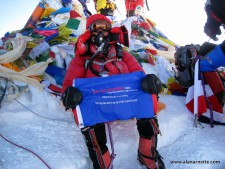
The Himalayan Database reports that through August 2020 there have been 10,271 summits (5,164 members and 5,107 hired workers) on Everest by all routes, by 5,790 different people. 1,352 people, including 941 Sherpa, have summited multiple times. There have been 772 summits by women members.
The Nepal side is more popular with 6,554 summits compared to 3631 summits from the Tibet side. 216 climbers summited without supplemental oxygen, about 2.1%. 35 climbers have traversed from one side to the other. About 62% of all expeditions put at least one member on the summit. 621 climbers have summited from both Nepal and Tibet. 119 climbers have summited more than once in a single season.
304 people (185 westerners and 119 Sherpas) have died on Everest from 1924 to August 2020, about 3.5%. 109 died on the descending from summit bid or 35% of the total deaths. 13 women have died. The Nepal side has 194 deaths or 2.9%, a rate of 1.23. The Tibet side has 109 deaths or 3%, a rate of 1.08. Most bodies are still on the mountain but China has removed many bodies from sight on their side. The top causes of death are from avalanche (77), fall (71), altitude sickness (36) and exposure (26).
In 2019 there were 878 summits, 216 from Tibet and 662 from Nepal and 3 didn’t use supplemental oxygen. There were 11 deaths.
How safe is Everest?
Everest is actually getting safer even though more people are now climbing. From 1923 to 1999: 170 people died on Everest with 1,169 summits or 14.5%. But the deaths drastically declined from 2000 to 2019 with 8,988 summits and 134 deaths or 1.5%. However, three years skewed the deaths rates with 17 in 2014, 14 in 2015 and 11 in 2019. The reduction in deaths is primarily due to better gear, weather forecasting and more people climbing with commercial operations.
Of the 8000 meter peaks, Everest has the highest absolute number of deaths at 304 but ranks near the bottom with a death rate of 1.17. Annapurna is the most deadly 8000er with one death for about every four summits (72:298) or a 3.84 death rate. Cho Oyu is the safest with 3,845 summits and 52 deaths or a death rate of 0.55.
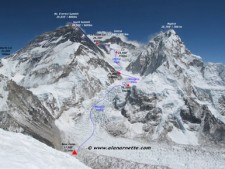
Both sides have a lot to offer: Tibet with the mystery of Mallory and Irvine in 1924 and Nepal with the first summit by Hillary and Norgay in 1953.
The comparison between sides is pretty simple. The north is colder, windier and some feel technically harder since you climb on exposed rock. The south has the Khumbu Icefall which some now fear. The Nepal side is more popular with 6,554 summits compared to 3,631 summits from the Tibet side
When choosing sides, keep in mind that as of 2021, China does not allow helicopter rescues on their side. That might change by 2022 as they are building a massive Mountaineering Center at base camp to cater to tourists and have said they will start helicopter rescues as part of the center.
One can cherry-pick the numbers to prove almost any point on which side is safe, but the bottom line is death happens on both sides of Everest and it often comes down to being in the wrong place at the wrong time.
Should I use supplemental oxygen?
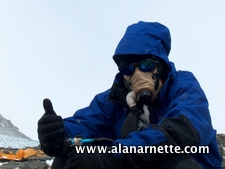
Supplemental oxygen gives the body a 3,000 foot advantage. In other words, when the climber is at 28,000 feet, the body feels like it is at 25,000 feet. The main benefit of supplemental oxygen is that you feel warmer thus allowing the heart to pump blood, and oxygen to fingers and toes thus reducing the risk of frostbite.
While climbing without Os is a serious accomplishment, it is not for everyone. Many try and few succeed.
How do I pay for an Everest climb?
Getting the money is almost always harder than climbing Everest. Climbers become very creative when finding the money. Some take out loans, refinance their home mortgage, others have the infamous “rich uncle”. Then there are those who set up a website to sell t-shirts or ask for “donations” from strangers. Believe it or not, this actually works to raise some money but rarely enough to cover all the expenses.
But the most common way to fund an Everest climb is to make it a priority in your budget by setting money aside each month for as long as it takes. This is how I funded 26 of my big climbs since starting at age 38.
The question of obtaining a sponsor often comes up. It is extremely difficult to get on a sponsored team for example by one of the large outdoor gear companies. There are ways to obtain a sponsor but it takes years of work, a solid plan, proven experience and often comes down to who you know and a lot of luck.
Climbing for a charity or a cause is popular but be careful not to use your cause as a way to fund a climb. This is a poor practice to ask for donations to pay for a climb in my opinion.
You can read more about my own experiences with The 7 Summits Climb for Alzheimer’s: Memories are Everything and thoughts for sponsorship at this link .
What are my chances?
Historically about 68% of all expeditions have put at least one member on the summit. The Himalayan Database shows that 45% of members who go higher than base camp go on to summit.
In recent years, long-time western operators like Jagged Globe, Adventure Consultants, Furtenbach, Madison Mountaineering, and others regularly put almost every member on the summit.
Today operators use the standard routes so there are fewer unknowns. That along with improved weather forecasting, and extra supplemental oxygen and generous Sherpa support have made Everest one of the safest 8000 meter mountains and the most summited 8000er by a huge margin.
Why Everest?
Let’s wrap up with why even climb Everest at all? It is very popular to criticize anyone who has or is planning a climb. Jon Krakauer’s book Into Thin Air set a negative tone and profiled climbers as rich, inexperienced and selfish after his one climb in 1996. In my experience with six climbs on Everest or Lhotse, the opposite is today’s reality.
To be fair, in recent years, the marketing of low-cost expeditions is attracting inexperienced climbers. This is all about supply and demand. All the puffery from the Nepal government about making Everest safer will have zero impact on this because of all involved benefit from the profit.
If you want to attempt the world’s highest peak, do the work: get the proper experience , train your body to be in “ Everest Shape ” and prepare your mind to push yourself harder than you ever thought possible. Select a team that matches your experience, be smart, be humble and savor every moment.
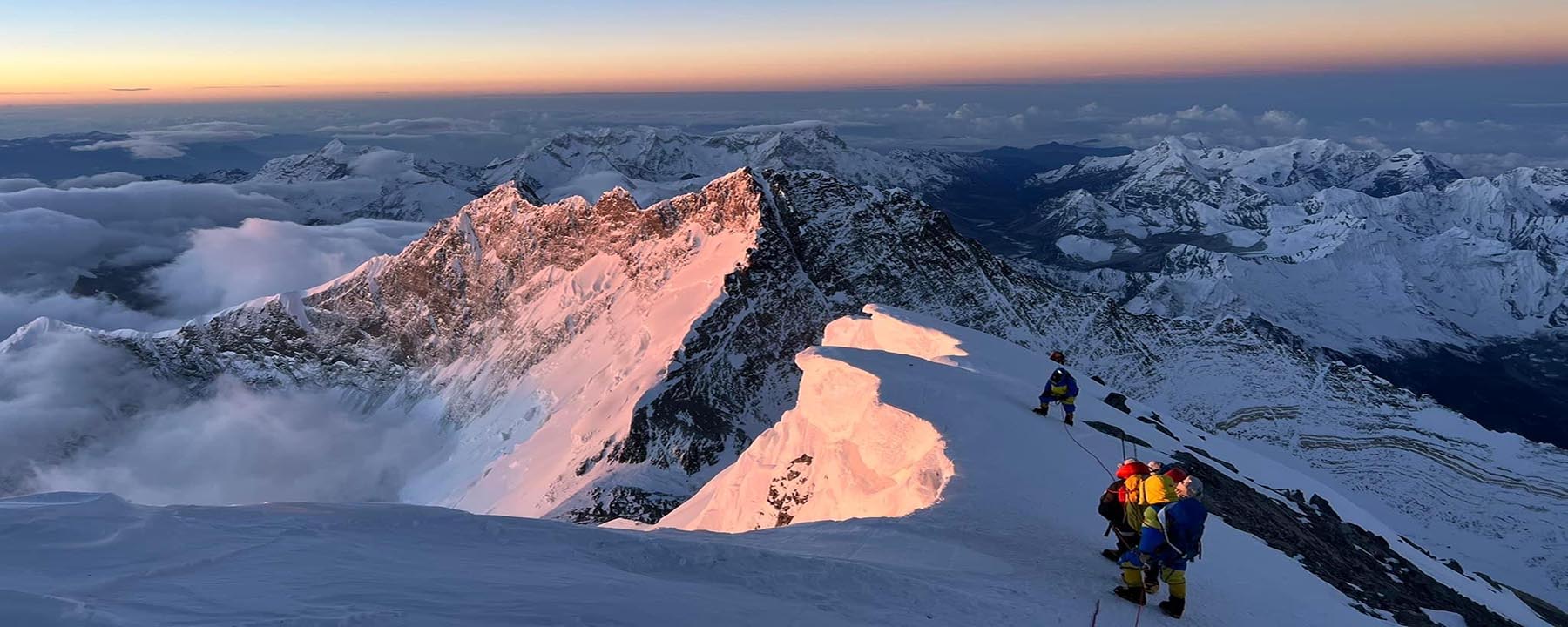
Everest Expedition 2024
Fully guided expedition to the world’s highest mountain
- Group Size: Min 2 Max 8
- Duration: 55 Days
- Max Altitude: 8,848m/29,029ft
- Accommodation: Climbing
- Activity: High Altitude Expeditions
- Meal: Meals included
- Trip Grade: Strenuous +
- Start Point: Kathmandu
- End Point: Kathmandu

Trip Itinerary
Dates & price, media gallery.
Welcome to Highland Everest Expedition 2024. Over 30 years of experience in high-altitude expeditions
Trip Overview
- Climb the highest mountain in the world
- Fully guided expedition with Sherpa support and max O2
- 1:1 Sherpa guide to client ratio and UIAGM/IFMGA expedition leader
- Climb Lobuche East for acclimatization
Everest Expedition 2024 Overview
Mount Everest [8,848m/29,029ft] being the highest mountain in the world is the ultimate dream of every climber. Climbing to Everest is undoubtedly the ultimate mountaineering adventure and every adventure seeker wants to be a part of the rich history of Everest Climbing but the journey to the summit of Everest is not without challenges. With decades of experience in guiding groups to the summit of Mt. Everest, we have successfully made many people’s dreams come true.
Why Join us on our Everest Expedition 2024?
- Guided by some of the best guides and experienced Sherpa team.
- 1:1 Sherpa guide to client ratio
- Expedition Manager/Sirdar
- Nepalese UIAGM/IFMGA Expedition Leader for a group of 4 climbers and above
- Ascent of Lobuche Peak for acclimatization
- Maximum oxygen flow 11 bottles (8 for you and 3 for your Sherpa)
- Premier climbing experience on Mount Everest
- A cohesive team of climbers (Maximum 8 climbers in one group)
- A long history of high altitude expeditions
Climb Overview
Our Everest expedition itinerary is designed with experience, planned and careful attention allowing maximum days for the approach, the highest level of service and a strong team of guides. We offer expeditions with safety priority and service paramount. We offer more oxygen support and provide comfortable logistics at base camp and Camp 2.
We follow the standard trekking route to Everest base camp following Namche Bazar, Tengboche, Dingboche, Lobuche, Gorekshep and finally Everest base camp. Upon arrival at Base Camp, settle and get organized as we prepare for the actual climb.
A pre-training session /climbing course will be held at the base camp, ice seracs of the lower Khumbu Glacier to check climbers’ equipment and review climbing and rescue techniques. You will also climb Lobuche East as part of your acclimatization climbs instead of frequent rotations in the Khumbu icefall.
Lobuche East is one of the most exciting 6000m trekking peaks in the Everest Region. Lobuche east climb serves as a perfect training base for Everest Expeditions and this is what we would be doing at Highland Expeditions too. You will climb Lobuche East wearing your high-altitude boots and equipment to make you feel comfortable. This peak provides not only an attractive diversion but an excellent part of the acclimatization process while allowing members to refresh and update mountain skills before moving up to Everest.
Climbing Lobuche East Peak prior to the actual Everest climb has not only helped in acclimatization but the climbers will not have to pass through the Khumbu Icefall multiple times for rotation of higher camps. After the climb, we head to base camp and in between looking at an auspicious date as per the Tibetan calendar we will organize a Puja ceremony in a traditional Sherpa manner asking for blessings for a successful Everest Climb.
Our second acclimatization phase begins with the rotation of higher camps passing by the notorious Khumbu icefall. Four camps will be set up above the base camp. We will prepare Camp1 (5,900m/19,500ft) at the pinnacle of the icefall, Camp2 (6,400m/21,000ft) in Western Cwm, which will be our Advanced Base Camp. We will set up Camp 3 (7,300m/23,700ft) at the top of the cirque on Lhotse Face. Camp 4 (7,900m/25,912ft) will be the final camp before climbing the summit. Camp 4 will be placed in the South Col.
Your expedition leader will suggest you the best as per your conditions. In general, our acclimatization program includes overnight at Camp 2 and tagging the Lhotse Face/Camp 3. When this is done, we rest and recover at the base camp while waiting for the weather window for the summit attempt. Oxygen cylinders will be used after Camp 3 for an easy ascent. We provide 8 bottles of oxygen to each climber for maximum flow. From Camp 4, following the southeast ridge, we will make it to the South summit from where we will advance towards Hillary step before climbing to the summit.
Tentative Acclimatization Schedule
First Rotation/Acclimatization (April 21-23): – Climb Lobuche East Peak (6,119m/20,075ft)
Second Rotation/Acclimatization (April 27- May 03): – Climb to Camp 1 (5,900m/19,500ft) – Climb to Camp 2 (6,400m/21,000ft) – Rest at Camp 2 (6,400m/21,000ft) – Touch Camp 3 (7,300m/23,700ft) and sleep at Camp 2 (6,400m/21,000ft) – Descent to base camp (5,364m/17,559ft)
Please note that these acclimatization programs may differ during the expedition period as each climber adapts differently to an altitude.
Summit Push (Weather permitting, most likely May 08-20): – Climb to Camp 2 (6,400m/21,000ft) – Climb to Camp 3 with the use of oxygen (7,300m/23,700ft) – Climb to Camp 4 South Col with the use of oxygen (7,900m/25,912ft) – Summit push (8,848.86m/29,029ft) and descent to Camp 4 with the use of oxygen – Descent to Camp 2 (6,400m/21,000ft) – Descent to Base Camp (5,364m/17,559ft)
Why climb Everest with us?
Over the last 30yrs, the people who helm this venture have been successfully organizing high-altitude Expeditions ensuring safety first and service paramount. The success of any expedition depends largely on a carefully planned itinerary and the best logistics and, these are what we offer. We are committed to maintaining the expedition safe and successful with the quality of service.
Our emphasis is always on maintaining the small group so that it will be easy to coordinate and cooperate with each other. You will be guided by highly professional mountain guides who are one of the best in this field and has experience successfully climbing Everest multiple times. Our guides, Sherpas, and support staff bring decades of successful summits to the table, and our climbing strategy reflects this.
Each year, we provide fully guided expeditions with the support of the legendary Sherpas. Our 1 to 1 Sherpa to client ratio with an expedition leader to lead the team on summit days show our commitment to providing safe climbing strategies.
Compared to the facilities we provide; you will find our Everest Expedition cost to be very reasonable. We have no hidden fee. What you pay in the beginning is the final payment. We are dedicated to providing the highest professionalism throughout the expedition by taking utmost care of all the logistics needed for our Everest Expedition.

Expedition Manager/Guide
Our Everest Expedition 2024 will be managed by Kunga Sherpa, an Everest summiteer and avid climber himself. With over 35 years of experience in the climbing industry, he has managed over forty above 8000m expeditions to date with a 90% success ratio.
For 2024, our Everest Expedition leader will be a Nepalese UIAGM/IFMGA Guide.
1:1 Sherpa to client ratio on summit day
Most of our Sherpa guides come from Rolwaling and Thame. All our Sherpa guides are previous Everest summiteers with detailed experience on high-altitude expeditions. We provide a 1:1 sherpa guide-to-client ratio on the summit day. Each of our Sherpa guides has tons of experience in climbing high-altitude peaks.
Our Sherpa crews are critical to the success of the climbs that you do with us. We, us professionally trained Sherpa guides & sirdars are just not hikers & climbers on the mountains but have been trained to perform this task with a lot of common sense & guile. Kunga Sherpa, Everest summiteer and founder of Highland Expeditions has successfully guided and organized over 40 expeditions to 8000m as an expedition sirdar oversees our experienced Sherpa crew that will be with you on the climb.
We ensure that they are confident & experienced. Most of our guides were born in these parts & have relatives living in other parts of the regions where they were born in. We know that locally born staffs are a vital cog in that wheel of sometimes dangerous adventure where anything can happen. At Highland Expeditions, we always make sure that our mountain crews are highly motivated & never compromise.
Local company with decades of high altitude experience
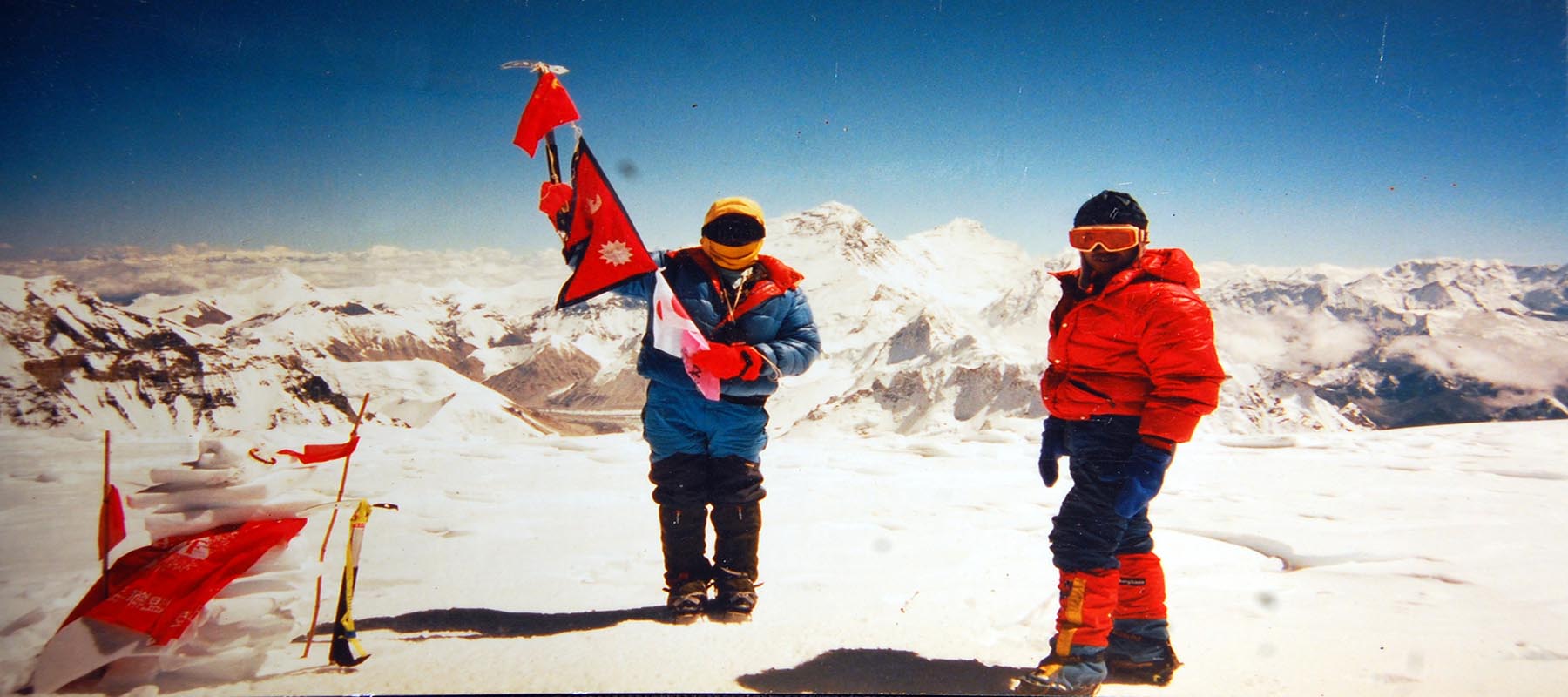
Highland Expeditions is a fully licensed and registered company operating high-altitude trips in the Himalayas. The people who helm this venture have been guiding high-altitude expeditions since 1992 and we take great pride in being able to offer personalized expeditions to Mt. Everest with safety priority and service paramount.
We operate a small team of cohesive climbers with the support of our experienced sherpa guides who have all summited Everest previously. We only take 8 climbers in a team and provide the Nepali UIAGM/IFMGA Expedition leader with a 1:1 sherpa guide-to-client ratio with maximum oxygen support and comfortable logistics arrangements.
Join us and be a part of the ‘Highland Expeditions family. It’s a never-ending feeling that will live with the generations to come.
Important Note: Your safety is of imperative concern while travelling with Highland Expeditions . Please take care to note that your leader/guide has the authority to amend or cancel any part of the itinerary if it is deemed necessary due to your safety concerns. Every effort will be made to keep to the above itinerary; however, since this adventure entails travelling in remote mountainous regions, we cannot guarantee that we will not deviate from it. Weather or health condition of a group member, unexpected natural disasters, etc., can all contribute to changes in the itinerary. The Trek & Climb leader/guide will try to ensure that the trip runs according to plan, but please be prepared to be flexible if required.
Arrival at Tribhuvan International Airport, Nepal. Upon completing the visa formalities and collecting your luggages in the airport, kindly proceed to the exit of the arrival hall. Your trip leader will await you just outside the arrival hall and will escort you to your hotel in Kathmandu. Please look out for a placard of Highland Expeditions at the exit of arrival hall. Welcome drinks will be served and after you’ve refreshed, your leader will brief you about your trip in the lobby of your hotel in the evening. Get familiar with your surroundings by taking a walk down the street
- Accommodation: Hotel
- Trekking Hours: 0
These two days have been kept in Kathmandu for final preparation of Climb. Meet other team members, complete official and government formalities, final gear check and load. Upon your interest, an optional Kathmandu sightseeing can be arranged on these days. We will have a trip orientation and your trip leader will give you a brief about your climb before we head to our journey.
After an early morning b/fast, we take the mountain flight from Kathmandu to Lukla on STOL aircraft. Flight time is about 30 minutes to the airstrip built by Sir Edmund Hillary and the Sherpas in the mid-1960s. We begin the trek by descending towards the Dudh Kosi River, where we join the main trail to Namche Bazaar, just above Chaurikharka at 2713m. The walking is easy and after passing through the small village of Ghat at 2550m, it’s a short walk to Phakding where we’ll stay overnight.
- Meal: (B, L, D)
- Accommodation: Teahouse/Lodge
- Trekking Hours: 3-4 hrs
We will continue our journey along Dudhkoshi River which will take us through pine forest. After crossing suspension bridges at several points and passing through small settlements of Zapute, Toktok, Benkar and Chumoa, we will reach Monjo. This is known as the gateway to the Sagarmatha National Park. After completing all the necessary national park formalities, we will enter Sagarmatha National Park. Lowering down from the park, we will arrive at river. Crossing another suspension bridge, we will proceed towards high Hillary Bridge located at the foot of the hill. Crossing this bridge, we will climb uphill to the Namche Bazaar. We can get view of Thamserku Mountain. If weather is clear, we can also have first view of Mt. Everest, Lhotse, Nuptse and Kusum Khangru mountains.
- Trekking Hours: 6-7 hrs
Namche Bazaar is regarded as gateway to the high Himalayas. It is also the main trading center and a capital of Sherpa land. Rest is recommended in Namche for acclimatization purpose. Short hike will be arranged to the ancient Sherpa village of Thame to observe the rich Sherpa culture or we can also visit nearby Khumjung, Khunde or Khongde villages. Shopping in marketplace of Namche is another fine idea. National Park Head office, Museum and monasteries are other places of interest. The area is clustered with cafes, shops, bakeries and restaurants. The place supports facilities of post office, hospital, government health post. Internet access is also available at Namche so that you can contact your near ones.
We will walk along the glacial water of Dudh Koshi River. The route offers views of Mt. Everest, Nuptse, Lhotse and, Thamserku and Ama Dablam Mountains. Our journey continues through the colorful forest of blooming rhododendron to Sanasa. The region is rich in wildlife including musk deer and colorful pheasants. In Sanasa lies the junction point. One of the paths leads us to the Gokyo valley while the other branches off to Everest Base Camp. We will take sharp climb to Tengboche monastery which is the largest in the Khumbu region. The journey rewards us with close-up views of many surrounding mountains. We will visit the monastery and walk through forest of birch and rhododendron to Deboche where we will stay overnight.
- Trekking Hours: 5-6
We will descend to Imja River. The trail takes us uphill to Pangboche (3860m) through the lush forest. We will visit Pangboche Monastery. The village is also decorated with Chorten and Mani walls. The trail allows us an access to Imja Valley. We will take steep climb to Pheriche and continue further to Lobuche River. The final steepest climb of the day will take us to Dingboche. Agriculture is the chief occupation of locals in Dingboche. We can see fields enclosed by stonewall in Dingboche. Buckwheat, potatoes and barley are the major crops. We will stay overnight in Dingboche.
- Trekking Hours: 5-6 hrs
This is a day to haul up and rest without being idle. We can stroll around the village and get pally with the local folks with some interesting conversations. This will give us deep insights into the lifestyles and cultures of the local folks in this region. At the same time, we can also relish the landscapes that surround us and we can also catch up on some reading. Our acclimatizing gets a further boost with our hike to Nagartsang peak (5067m). As we top it with gasping breath we soon realize the gritty climb was worth the go; the rewards are as lovely as it comes with the natural beauty that greets us for our efforts.
We will begin a moderate walk to Dugla. Walking through the steep moraine of Khumbu glacier, we will head towards Chupki Lhara which is festooned with prayer flags. It is also known as the memorial site for the deceased Everest climbers. The trail stretches through the Khumbu glacier moraine to Lobuche. On the way, we can rejoice in the close-up views of Pumori, Khumbutse and other peaks and mountains. Stay overnight in Lobuche.
The day starts with a trek past a fine crevasse between the lateral moraine of a glacier and a mountain. Then a gradual climb will take to Changri Nup Glacier. The undulating terrain takes you on a whirlwind of a walk. Descending slightly in the final stretch, you land in a barren setting with a sandy moraine and a cluster of lodges amidst the jagged rocky terrain surrounded by mammoth mountains. This is Gorakshep where you’ll spend the night.
- Meal: (B,L,D)
Start on the climb along the Khumbu glacier to Everest Base Camp. Finally, arrive at the foot of the highest peak in the world. The views of numerous mountains, the Khumbu Icefall, and the Glacier make it even more glorious. Overnight with some of the highest peaks in the world at Everest Base Camp.
- Accommodation: Camp
Get organized and comfortable with your home for the next 4 weeks.
Looking at an auspicious date as per the Tibetan calendar, a puja ceremony will be held asking for safe passage.
We will also do training at the base camp, in ice seracs of the lower Khumbu Glacier to check climbers’ equipment and review climbing and rescue techniques.
- Accommodation: Fully Tented Camping
Our first phase of acclimatization begins with a climb to Lobuche East. Climbing Lobuche east provides better acclimatization and the perfect training base for Everest.
Lobuche East Climb Plan: Day 01: Trek to Lobuche Day 02: Move to Lobuche high camp Day 03: Summit Lobuche East and down to Lobuche or high camp
Couple of hours of walk through Gorak Shep and walking further through rocky dunes and moraine, will lead us to Everest Base Camp. We will meet rest of our team at Base Camp.
The next few days we stay at base camp for more training, rest, get organized and prepare for 2nd acclimatization rotation which will take us to 7000m.
After our first acclimatization rotation on Lobuche Peak completed, we will now leave base camp for higher camps on Everest for our second acclimatization rotation for about a week.
Tentative Schedule for second rotation: – Climb to Camp 1 (5,900m/19,500ft) – Climb to Camp 2 (6,400m/21,000ft) – Rest at Camp 2 (6,400m/21,000ft) – Touch Camp 3 (7,300m/23,700ft) and sleep at Camp 2 (6,400m/21,000ft) – Descent to base camp (5,364m/17,559ft)
For the acclimatization, please note that the acclimatization program may differ during the expedition period as each climber adapts differently with an altitude. Your expedition leader will suggest you the best as per your conditions.
In general, our acclimatization program includes overnight at Camp 2 and tag the Lhotse Face/Camp 3. When this is done, we rest and recover at the base camp while waiting for the weather window for the summit attempt.
After our second acclimatization rotation completed, we will descent to base camp and rest and prepare for the final summit push.
Depending on the weather window available for summit, the rest days could be few days or even a week too.
Optional: Trek/Fly down to lower villages such as Namche for better rest
Summit push begins!
Depending on the weather window available we will move up for our final summit push. Each client will be paired with one sherpa guide who will assist you on the summit push.
Tentative plan for summit push: – Climb to Camp 2 (6,400m/21,000ft) - Rest at Camp 2 (6,400m/21,000ft) – Climb to Camp 3 with the use of oxygen (7,300m/23,700ft) – Climb to Camp 4 South Col with the use of oxygen (7,900m/25,912ft) and at that same night we begin our summit push to summit. – Summit push with the use of oxygen (8,848.86m/29,029ft) from Camp 4 and descent to Camp 4 or Camp 2 – Descent to Camp 2 (6,400m/21,000ft) – Descent to Base Camp (5,364m/17,559ft)
Oxygen cylinders will be used from Camp 3 for an easy ascent. We provide 8 bottles of oxygen to each climber for a maximum flow. 8 bottles is the highest number of oxygen provided as most operators only provide 6 bottles.
From Camp 4, following the south-east ridge, we will make it to the South summit from where we will advance towards Hillary step before climbing to the summit.
Contingency days for any delays due to unforeseen circumstances
After our successful climb we retrace to Lukla for a flight back to Kathmandu via Pheriche, Namche and finally to Lukla. On our last night, we celebrate our successful completion of expedition with our Sherpa guides and porters who we’ve got to know so well & are now good friends
Take an early morning flight from Lukla to Kathmandu. We will be transferred to hotel in a private vehicle in Kathmandu. Take leisure and soothe your aching limbs from long and tiring climb.
Enjoy a leisure day. You are on your own. Participating in a day tour in Kathmandu is a pleasant plan. You can also go for shopping in Thamel, a tourist hub where you can buy souvenir items like handicrafts and arts to your family. At eventide on day, we will relish a farewell dinner to celebrate our successful climb. While enjoying our supper, we will also be entertained to a scintillating cultural dance performed by the local belles Please do not hesitate to let us know if you would like to extend your stay. Kindly email us for more details on extensions.
Finally, the undeniable day of departure arrives. Thank you for joining us on this climb and it has been a pleasure being a part of your expedition.
Our representative will take you to Tribhuvan International Airport three hours before your scheduled flight. Keep in touch and hope to hear from you soon. Bon voyage for a safe and pleasant trip home.
- Accommodation: None
- Trekking Hours: Warning : Undefined array key "_package_itinerary_trek_hours" in /home/expeditions/www/www/wp-content/themes/highland/single-package.php on line 310
Our trips are available on both fixed departure and private group basis .
If you are looking for a group to join this trip please click the Fixed Departures tab for more information on departure dates, availability and price. All our fixed departures are guaranteed to run. Or, if you would like to do this trip alone, or with your friends, families & colleagues in a private group style, please fill out the contact form in Private Group tab and send us your message. We will organize a private trip for you at your preferred dates catering any request you may have.
- Fixed Departures
- Private Group
- Full Name *
- Email Address *
- Phone Number
- Country * Country * Afghanistan Albania Algeria American Samoa Andorra Angola Antigua and Barbuda Argentina Armenia Australia Austria Azerbaijan Bahamas Bahrain Bangladesh Barbados Belarus Belgium Belize Benin Bermuda Bhutan Bolivia Bosnia and Herzegovina Botswana Brazil Brunei Bulgaria Burkina Faso Burundi Cambodia Cameroon Canada Cape Verde Cayman Islands Central African Republic Chad Chile China Colombia Comoros Congo, Democratic Republic of the Congo, Republic of the Costa Rica Côte d'Ivoire Croatia Cuba Curaçao Cyprus Czech Republic Denmark Djibouti Dominica Dominican Republic East Timor Ecuador Egypt El Salvador Equatorial Guinea Eritrea Estonia Ethiopia Faroe Islands Fiji Finland France French Polynesia Gabon Gambia Georgia Germany Ghana Greece Greenland Grenada Guam Guatemala Guinea Guinea-Bissau Guyana Haiti Honduras Hong Kong Hungary Iceland India Indonesia Iran Iraq Ireland Israel Italy Jamaica Japan Jordan Kazakhstan Kenya Kiribati North Korea South Korea Kosovo Kuwait Kyrgyzstan Laos Latvia Lebanon Lesotho Liberia Libya Liechtenstein Lithuania Luxembourg Macedonia Madagascar Malawi Malaysia Maldives Mali Malta Marshall Islands Mauritania Mauritius Mexico Micronesia Moldova Monaco Mongolia Montenegro Morocco Mozambique Myanmar Namibia Nauru Nepal Netherlands New Zealand Nicaragua Niger Nigeria Northern Mariana Islands Norway Oman Pakistan Palau Palestine, State of Panama Papua New Guinea Paraguay Peru Philippines Poland Portugal Puerto Rico Qatar Romania Russia Rwanda Saint Kitts and Nevis Saint Lucia Saint Vincent and the Grenadines Samoa San Marino Sao Tome and Principe Saudi Arabia Senegal Serbia Seychelles Sierra Leone Singapore Sint Maarten Slovakia Slovenia Solomon Islands Somalia South Africa Spain Sri Lanka Sudan Sudan, South Suriname Swaziland Sweden Switzerland Syria Taiwan Tajikistan Tanzania Thailand Togo Tonga Trinidad and Tobago Tunisia Turkey Turkmenistan Tuvalu Uganda Ukraine United Arab Emirates United Kingdom United States Uruguay Uzbekistan Vanuatu Vatican City Venezuela Vietnam Virgin Islands, British Virgin Islands, U.S. Yemen Zambia Zimbabwe
- Prove You're Human:
Cost Inclusion
- Everest expedition royalty fees (USD 11,000)
- Route fixing (SPCC and EOA) fees
- Garbage deposit and management fees
- Expedition Liaison Officer wages and fees
- Nepalese UIAGM/IFMGA Expedition leader for a group of 4 climbers and above
- 1:1 Sherpa guide (Everest Summiter) to climber ratio
- Service of the Expedition manager at Everest base camp
- 11 bottles of oxygen (8 for you and 3 for your sherpa) with the use of the latest mask and regulator.
- Skill training clinic at the Everest base camp
- The ascent of Lobuche Peak for acclimatization with a 1:3 guide to client ratio
- Freshly prepared meals (B,L,D) by our chef at the Everest base camp
- A wide variety of nutritious high-altitude mountain foods for higher camps
- Individual box tent, dining tent, kitchen tent, toilet tent and other logistics
- Heater, Generator, Shower and more for your comfort at the base camp
- High altitude tent (North Face VE25 or similar) for higher camps above base camp
- 4 nights accommodation at a 4-star hotel in Kathmandu.
- All Meals (B,L,D) and accommodation during the trekking period
- Satellite communication system at base camp but nominal charge for use
- Radio set for communication between camps
- Internal domestic airfare with 60kg baggage cargo
- Staffs wages, allowances with their helicopter and medical insurance
- Common climbing equipment (rope, Ice Screws, Snow bars etc)
- Weather report during the entire expedition period
- Emergency medical supplies with 24/7 on-call doctor during the entire expedition period.
- Porterage of 60kg baggage for each member (Lukla-Base camp-Lukla)
- 2 waterproof duffel bags
- Everest Summit certificate from the Department of Tourism, Nepal
Cost Exclusion
- International airfare
- Meals in Kathmandu
- Custom for bringing any expedition goods
- Nepal visa fees
- Personal clothing and climbing equipment
- Insurance (Mandatory)
- Summit bonus (USD 1500)
- Gratuities for base camp and trekking staff
- Personal expenses
- Extra oxygen aside from provided 11 bottles
Essential Information
High Altitude Expeditions like Everest require previous mountaineering experience and it is expected that the climber has previous experience of climbing at least 7000m peak or 8000m peak like Cho-Oyu or Manaslu before attempting bigger mountains.
Also, you will be spending 2 months on the mountain, a fierce determination, strong mental health and a burning desire to climb the mountain are the essential pre-requisites for joining this expedition. Prepare yourself to tackle high altitude sickness, tough weather conditions and exhaustion. One needs to be familiar with the use of climbing equipment, and walking in snow and ice and must have a good level of fitness. You should be familiar with Rope skills, ice axe arrest and crampon skills, the use of ascenders (Jumar) and descenders, and how to use your particular harness.
The use of oxygen equipment plays a huge role in climbing high mountains and can help to avoid many critical situations and save your life. On Everest, we provide each climber with 11 bottles of oxygen (8 for you and 3 for your sherpa) with the use of the latest mask & regulator (Top Out or Summit Oxygen Systems).
During the summit push, we run oxygen on a higher flow (2L/min) allowing you to climb more efficiently.
We consider delicious and nutritious food to be a key component to the overall success of our expeditions.
We charter the food in by flight most of the time and take the utmost care in quality and hygienic preparation. From typical Nepalese food to western food, our expedition chef will cater all meals at Base Camp and Camp 2. For higher camps, we provide wide variety of nutritious high foods.
During the trek, your meals will be served at the teahouse/lodge you will stay and in Kathmandu, only breakfast will be provided to give you the maximum flexibility in deciding where what and with whom to eat for lunch and dinner.
If you have any special dietary requirements please let us know in advance and we will be sure to cater to your needs. You could bring comfort foods from your home that you enjoy eating during the expedition - chocolates, energy gel, power bars, dry fruits, candies, other snacks etc.
We provide each climber with an individual box tent at the base camp during an entire expedition. Each box tent will have spacious space, comfortable mattresses, carpeted floor and more for your comfort. Higher above from base camp, a high-quality extreme weather tent will be provided for every 2 climbers. It’s also a lot warmer and safer when you can keep an eye on each other.
At base camp, there will also be a heated dining room, kitchen tent, toilet tent, shower tent etc and more for your comfort.

Our Everest Expedition follows the footsteps of legendary Sir Edmund Hillary and Tenzing Norgay Sherpa. Our route follows through the Khumbu icefall, up the Western Cwm, the Lhotse Face, the South Col, South Summit, the Hillary Step and on to the Summit.
An itinerary has been devised keeping every important aspect in mind to allow a well-paced acclimatization schedule during the entire expedition.
Our base camp is well-appointed, providing each climber with a comfortable environment. There will be a heated dining room, personal tent for each individual, kitchen tent, shower and etc. and more for your comfort.
We provide spacious expedition quality personal tents for all our clients both with full board or base-camp service only.
We subscribe to the weather forecasting services during the expedition summit period as to provide the best weather forecast for the summit push.
Our Everest expedition itinerary has been tailored carefully keeping every aspect in mind. We have included Lobuche east climb (6,119m) on our itinerary. With Lobuche climb included, it provides each climber with better acclimatization, the practice of climbing techniques and reduces the walk on icefall.
After the Lobuche climb, rotation of higher camps (Camp 1, 2 and 3) with overnight will be done for acclimatization.
Our Everest Expedition group will be equipped with a satellite phone for emergency purpose throughout the expedition duration. The cell phone network is available during the trekking section and at base camp but the service is not reliable and may fluctuate depending on weather conditions. Satellite internet is available at base camp at an extra cost. In case you need to make a personal call, you can use the sat phone at $3 per minute.
We also provide a radio communication system to communicate between the camps.
Our emphasis is always on maintaining a small group so that it will be easy to coordinate and cooperate with each other, especially on high altitude expeditions like Everest. Our expedition consists of Min 2 to Max 8 climbers in one group. You will get to know your Sherpa guide and team members personally on our expedition. Being a small group is always efficient on a bigger mountain.
We operate a small team of cohesive climbers with the support of our experienced sherpa guides who have all summited Everest previously. We only take 8 climbers in one group and provide Nepali UIAGM/IFMGA Expedition leader, Expedition Manager and 1:1 sherpa guide to client ratio.
It’s mandatory to get rescue insurance before embarking on any adventurous activities like high altitude expeditions. We advise all our clients to get an insurance that covers up emergency helicopter evacuation that may be needed in case of the occurrence of AMS (Acute Mountain Sickness) in high altitudes where there are no other means of transportation available. Medical expenses, Baggage lost, Delays and Cancellation, Death & Repatriation are also other important factors to include when purchasing your Insurance.
It is advisable to review carefully the insurance and its coverages before making the final decision.
To reserve your spot on the expedition, a nonrefundable deposit (20% of total cost) is due at the time of registration. Your booking will be confirmed by an email after we have received the booking form together with the initial deposits. For payment method, we accept wire transfer and card payment. Please note that an additional 3.5% charge will be levied (as imposed by the bank) on the total amount if you are paying via card.
Balance payment must be made 30 days prior to the expedition start date.
View our payment information page for more details on payment.
Refund policy:
The trip deposit is non-refundable and will be forfeited in the event of any cancellation, as such we strongly recommend you to include Trip cancellation coverage on your insurance policy. The reason for the non-refundable policy is due to the great expenses incurred in such an expedition. The expeditions are planned and prepared months before your arrival in Kathmandu.
Highland Expeditions is a fully licensed and registered company operating high altitude trips in the Himalayas. The people who helm this venture have been guiding high altitude expeditions since 1992 and we take great pride in being able to offer personalized expeditions to Mt. Everest with safety priority and service paramount.
The gear listed below is required for the expedition. We encourage you to get all equipment listed below and kindly ensure you check and try every equipment. You can also buy or hire the same in Kathmandu as they are available in the many trekking shops from branded to local manufacturers in Kathmandu.
Head: - Warm Hat and Bandana/Scarf - Baseball cap - Thermal Balaclava / Buff - Sunglasses with UV protection - Ski goggles (Anti-fog and good ventilation) - Headlight X 2 with spare batteries
Upper body: - Long-sleeved shirts - T-Shirts - Baselayers - Warm Jackets/Sweater/Pullover - Waterproof jackets - Down Jacket with hood (800m fill) - Primaloft or light down jacket - Down Suit (Lightweight, comfortable fit and 800m fill) (For Summit Climb Only)
Lower body: - Thermal - Inner wears / Baselayers - Undergarments - Waterproof trousers - Trekking trousers - Down or Primaloft pants
Feet: - Warm socks (4 pair thin socks and 4 pair thick socks) - Trekking shoes (Preferably full to protect/support your ankle) - 8000m Mountaineering boots (Lightweight and comfortable size) - Camp Shoes - Gaiters - Down shoe
Hands - Gloves - Primaloft Mitten - Down Mitten
Climbing equipment: - Climbing helmet - Backpack 30-35 litres (To carry your sunblock, water, camera, waterproof jackets and others that you may require while trekking) - Backpack 60-70 litres for climbing - A pair of trekking poles - Harness - Ascender/Jumar (Large handle) - Descender /Figure 8 - ATC Guide - Carabiners (4 screw gate and 4 snap gate) - Prussik cord X 2 - Slings X 2 - Ice Axe - 12-points steel crampons - Inflatable sleeping mattress - Sleeping bag X 2 (One for base camp and one for higher camps)
Others: - Trekking poles - Water bottle one (1) litre X 2 with an insulated cover - Thermos - Multi-tool knife - Pee bottle - Laundry bag to keep dirty clothes - Large plastic bags to keep the clothes dry - Padlock - Binoculars - Sewing kit - Duct tape - Reading materials, notebooks and pens - Extra clothes to wear in Kathmandu when you come back from the expedition. - Camera with charger or spare batteries
Toiletries and hygiene - Quick-drying towel - Small face towel - Toothbrush &Toothpaste - Deodorants, Soap and Shampoo (Smaller bottle) - Face and body moisturizer, Sunscreen and lip balm - Hand sanitiser/Antiseptic wipes - Hygiene products - Basic first aid kit
Documents - Passport with visa and validity of 6 months after your trip completion - 4 copies of passport size photos for permits and official formalities - Travel Insurance (Please refer to the general information page for more detail about it) - Flight tickets - Credit cards in case of emergencies - Driving ID or any other ID in case of loss of your passport.
(Please carry the photocopy of all the documents along with you and leave a copy to next of kin)
Other information such as (Insurance, Arrival Instructions, Visa and Passport etc) required for the trip will be provided after you have signed up for the expedition. Please feel free to get in touch with us if you require more information about the trip.

A great local company that looks after you, its guides and its staff. I have done Ama Dablam and Everest with them. Both were very well-run expeditions and led to successful summits. Thank Passang and the Highlands team for all your efforts for the airport pick-up to reaching my goal. Can’t recommend these guys enough.

Are You Interested?
If Interested please hit the button
TRIP DOSSIER FORM
- Consent I am happy to receive regular emails from Highland Expeditions
Related Packages
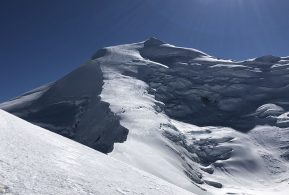
Himlung Expedition 2024

Ama Dablam Expedition 2024

Manaslu Expedition 2024
Why travel with highland expeditions, affiliated with, latest blog, layering for trekking and climbing in nepal.
Of the fundamental aspects to consider when planning a trek or expedition to Nepal, clothing and layering are major considerations. Landing in a warm, temperate climate at Kathmandu (1300 meters […]
REVIEWS Real People, Real Stories
My wife and I recently joined Highland Expeditions for a Everest Basecamp helitrek for our honeymoon. From the start to the end of our contact with Highland Expeditions, we had […]
JOIN THE NEWSLETTER
- Package Name * -- select a Package -- Ama Dablam Base Camp Trek Ama Dablam Expedition 2024 Annapurna Base Camp Trek Annapurna Circuit Trek Annapurna Dhaulagiri Trek Annapurna Inner Circuit Trek Annapurna Jomsom Trek Annapurna Poonhill trek Annapurna Sanctuary Trek Bardia Wildlife Safari Best of Nepal Tour Bhutan Highlight tour Chitwan Jungle Safari Cho Oyu Expedition 2023 Chulu Far East Peak Climb Dhaulagiri Circuit Trek Everest and Annapurna Trek Everest Base Camp and Gokyo Lakes Trek Everest Base Camp Gokyo Lakes Heli Trek Everest Base Camp Heli Trek Everest Base Camp Helicopter Tour Everest Base Camp Trek Everest Base Camp Trek 14 Days Everest Comfort Lodge Trek Everest Expedition 2024 Everest Three High Passes Trek Experience Nepal Tour Full day sightseeing of Kathmandu Gokyo Lakes Trek Half day sightseeing of Kathmandu Helambu Trek Highlights of Nepal Himlung Expedition 2024 Island Peak Climb Kanchenjunga Base Camp Trek Kathmandu Valley Trek Khumbu Three Peaks Kyajo Ri Peak Climbing Langtang Gosaikunda and Helambu Trek Langtang Valley Trek Lhotse Expedition 2024 Lobuche East and Island Peak Climb Lobuche Peak Climb Luxury Annapurna Trek Luxury Everest Base Camp Trek Makalu Base Camp Trek Manaslu Circuit Trek Manaslu Expedition 2024 Mardi Himal Trek Mera and Island Peak Climb Mera Peak Climb Mountaineering Course in Nepal Nar Phu Valley Trek Nepal and Bhutan Tour Nepal and India Tour Paro Tsechu Tour Pharchamo Peak Climbing Pisang Peak Climb Rolwaling Tashi Lapcha Pass Trek Rolwaling Valley Trek with Daldung La Sleep at Everest Base Camp Tengboche Monastery Trek Three Peaks Climbing Tibet Overland Tour to Kathmandu Tibet Tour with Everest Base Camp Tsum Valley Trek Upper Dolpo to Jomsom Trek Upper Mustang Trek Western Bhutan Tour Yala Peak Climb Yalung Ri Peak Climb
- Email Address* *
- Country Country Afghanistan Albania Algeria American Samoa Andorra Angola Antigua and Barbuda Argentina Armenia Australia Austria Azerbaijan Bahamas Bahrain Bangladesh Barbados Belarus Belgium Belize Benin Bermuda Bhutan Bolivia Bosnia and Herzegovina Botswana Brazil Brunei Bulgaria Burkina Faso Burundi Cambodia Cameroon Canada Cape Verde Cayman Islands Central African Republic Chad Chile China Colombia Comoros Congo, Democratic Republic of the Congo, Republic of the Costa Rica Côte d'Ivoire Croatia Cuba Cyprus Czech Republic Denmark Djibouti Dominica Dominican Republic East Timor Ecuador Egypt El Salvador Equatorial Guinea Eritrea Estonia Ethiopia Faroe Islands Fiji Finland France French Polynesia Gabon Gambia Georgia Germany Ghana Greece Greenland Grenada Guam Guatemala Guinea Guinea-Bissau Guyana Haiti Honduras Hong Kong Hungary Iceland India Indonesia Iran Iraq Ireland Israel Italy Jamaica Japan Jordan Kazakhstan Kenya Kiribati North Korea South Korea Kosovo Kuwait Kyrgyzstan Laos Latvia Lebanon Lesotho Liberia Libya Liechtenstein Lithuania Luxembourg Macedonia Madagascar Malawi Malaysia Maldives Mali Malta Marshall Islands Mauritania Mauritius Mexico Micronesia Moldova Monaco Mongolia Montenegro Morocco Mozambique Myanmar Namibia Nauru Nepal Netherlands New Zealand Nicaragua Niger Nigeria Northern Mariana Islands Norway Oman Pakistan Palau Palestine, State of Panama Papua New Guinea Paraguay Peru Philippines Poland Portugal Puerto Rico Qatar Romania Russia Rwanda Saint Kitts and Nevis Saint Lucia Saint Vincent and the Grenadines Samoa San Marino Sao Tome and Principe Saudi Arabia Senegal Serbia Seychelles Sierra Leone Singapore Sint Maarten Slovakia Slovenia Solomon Islands Somalia South Africa Spain Sri Lanka Sudan Sudan, South Suriname Swaziland Sweden Switzerland Syria Taiwan Tajikistan Tanzania Thailand Togo Tonga Trinidad and Tobago Tunisia Turkey Turkmenistan Tuvalu Uganda Ukraine United Arab Emirates United Kingdom United States Uruguay Uzbekistan Vanuatu Vatican City Venezuela Vietnam Virgin Islands, British Virgin Islands, U.S. Yemen Zambia Zimbabwe
- / Expeditions
- / Seven Summits
THE ULTIMATE ADVENTURE
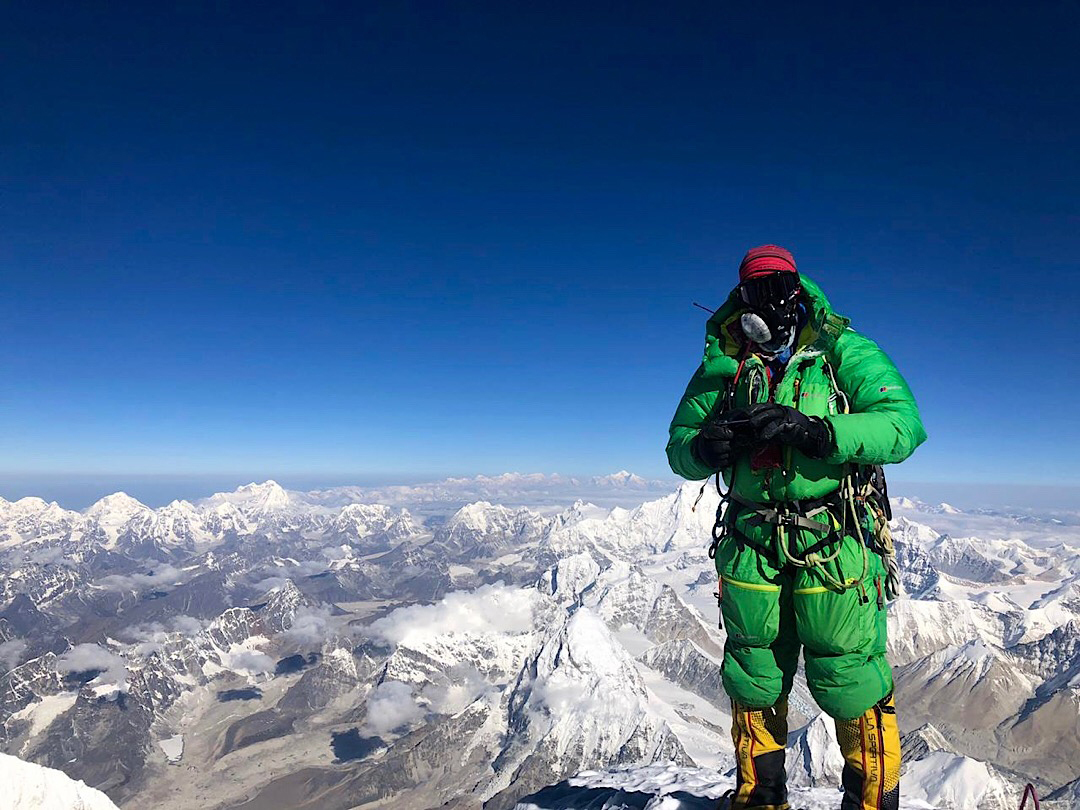
Mount Everest is still the ultimate mountaineering adventure. To stand at the pinnacle of the Earth is one of life's most rewarding experiences. As pioneers of guided ascents on Everest, Adventure Consultants is recognised as the premier guiding service with a superb reputation for enabling members of our expeditions to achieve summit aspirations.
An attempt on Everest is a committing undertaking which requires a huge amount of dedication and determination. If you are serious about achieving the top and feel you have the right ingredients and experience, we invite you to apply for a position on our team in 2025, on what will be our twenty-ninth Everest expedition.
The Adventure Consultants methodology and tactical approach to climbing Mount Everest has seen us achieve the highest success rates and our extensive experience gives us the edge when it comes to the big decisions. We provide a consistently higher Sherpa and guide ratio than any other operator, resulting in more support and backup for your summit attempt and therefore a greater safety margin and chance of success.
We are constantly developing and evolving our operational systems to ensure you participate in the best expedition available. We figure our expedition members do not deserve anything less! In the interests of giving you the most optimal chance to summit, we limit our team size to ensure the group summits on the best weather day; sometimes there is only one summit day! Large teams offering cheap climbs often miss out as they split their groups over several potential summit days.
Our guides are seasoned professionals who are trained and assessed through the International Federation of Mountain Guides Associations (IFMGA) resulting in a greater repertoire of skills that enables them to provide a dedicated level of security to you during the expedition. The guide's contribution is predominantly around making decisions to keep you safe and healthy and to avoid mishap. This is based on years of first-hand experience on the mountain and is in contrast to startup operators looking to learn the ropes at your expense or locally-led groups which are wanting of preventative strategies and back-up contingency in case of mishap.
For two decades we have been at the forefront of providing the most current communications systems for our expeditions. These deliver comprehensive weather forecasts which enable us to plan our ascent around favourable weather. Additional meteorological interpretation provided by veteran Everest guides through our head office in New Zealand helps manage the decision-making process.
Our Wi-Fi data connection allows you to keep in touch with sponsors, business, friends and family via email, social media accounts or blog throughout the expedition from the comfort of your tent or our Base Camp lounge. The comfortable Base Camp environment and the quality of food provided by AC is legendary. Our cooks are regarded as the best in the business, providing wholesome and appetising meals with an agreeable array of menus to suit all your food requirements. The meals you are served on the mountain are also of the highest standard and designed to sustain you for the rigours of the ascent. For those with specific needs - we can cater to special dietary requirements.
In line with our objective to ensure you receive the best possible level of care while you are on the expedition, we provide a dedicated Base Camp doctor who is there specifically to ensure the wellbeing of the team members. We have had it confirmed time and again that this consistently makes a crucial contribution to the success rate and well-being of our team members.
You can customize your expedition by adding further service options to complement your ascent, such as private expeditions, additional Sherpa support, Everest Traverse from south to north, training schedules and much more. There is no doubt that an attempt of Mount Everest is a committing and serious undertaking. It takes a huge amount of dedication and determination to be successful. We work with you to help develop a suitable training program and a schedule of preparatory ascents to give you the best chance of achieving that lofty goal.
If you are serious about being successful on an ascent of the world’s highest mountain—and you want an environment that gives you the best chance of attaining that goal in a relaxed team atmosphere or private expedition—then Adventure Consultants is the perfect choice.
- Climb with the pioneers of Everest expedition guiding
- 1:1 Sherpa to climber ratio on summit day and 1:4 ratio of Western Guides
- No other operator offers so much in the way of resources and personnel to help you achieve success!
- High flow oxygen package for all team members
Expedition Level
8,850m/29,035ft
Arrive in Kathmandu
Kathmandu Preparations
Trek to Base Camp 5,300m/17,400ft
Establish camps and acclimatise
Clean up and depart Base Camp
Trek to Lukla
Fly from Lukla back to Kathmandu
Depart Kathmandu
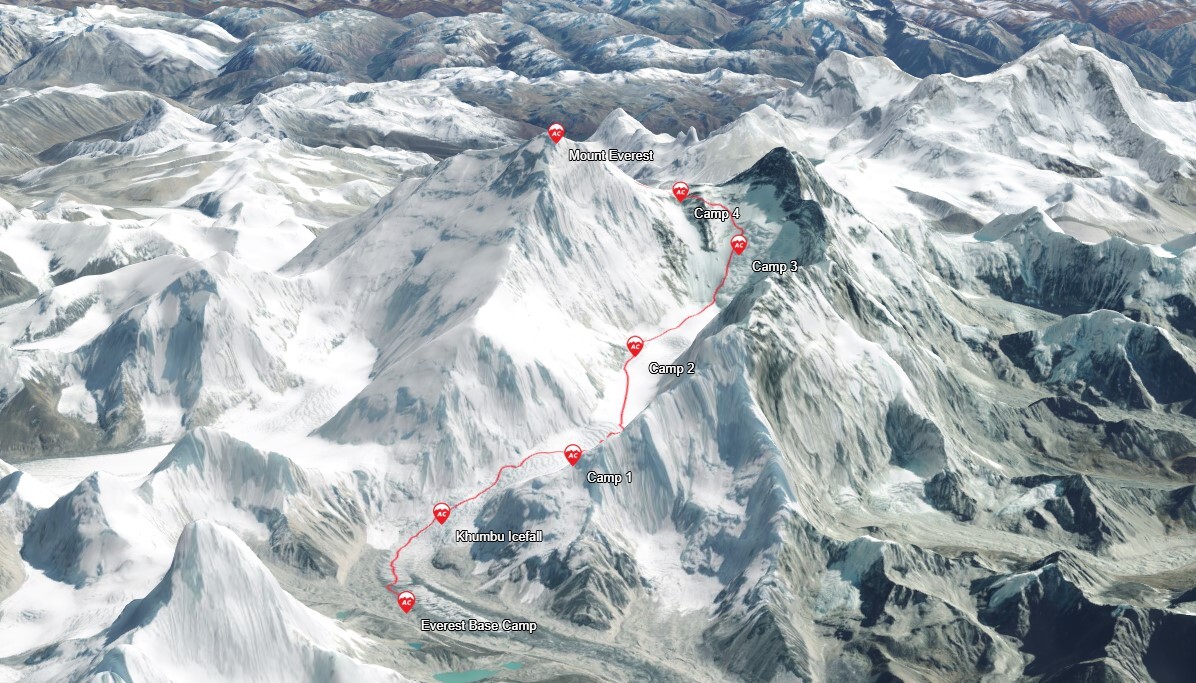
Departures and Pricing
Looking for a specific date? Book a private expedition
The need for exceptional physical fitness cannot be over-emphasised. A regular, strenuous programme must be followed for many months to achieve the level of fitness required. We recommend a training programme tailored to mountaineering such as those from Uphill Athlete .
You must be able to efficiently climb ice, snow and rock terrain, multiple days in a row. Climbers will ideally have a broad set of climbing skills from basic rock climbing to advanced cramponing on snow and ice and strong rope skills such as rappelling and rope ascending. You should be comfortable with camp craft and self-care at high altitude.
Prior ascents of multiple 6000-7000m peaks are required (such as Denali, Aconcagua , Peak Lenin , 6000m peaks in Nepal , or the Ecuador Volcanoes ) and a prior ascent of an 8000m peak, such as Cho Oyu , is strongly recommended. This will allow you to fine-tune your skills and equipment and discover how you personally cope with extreme altitude.
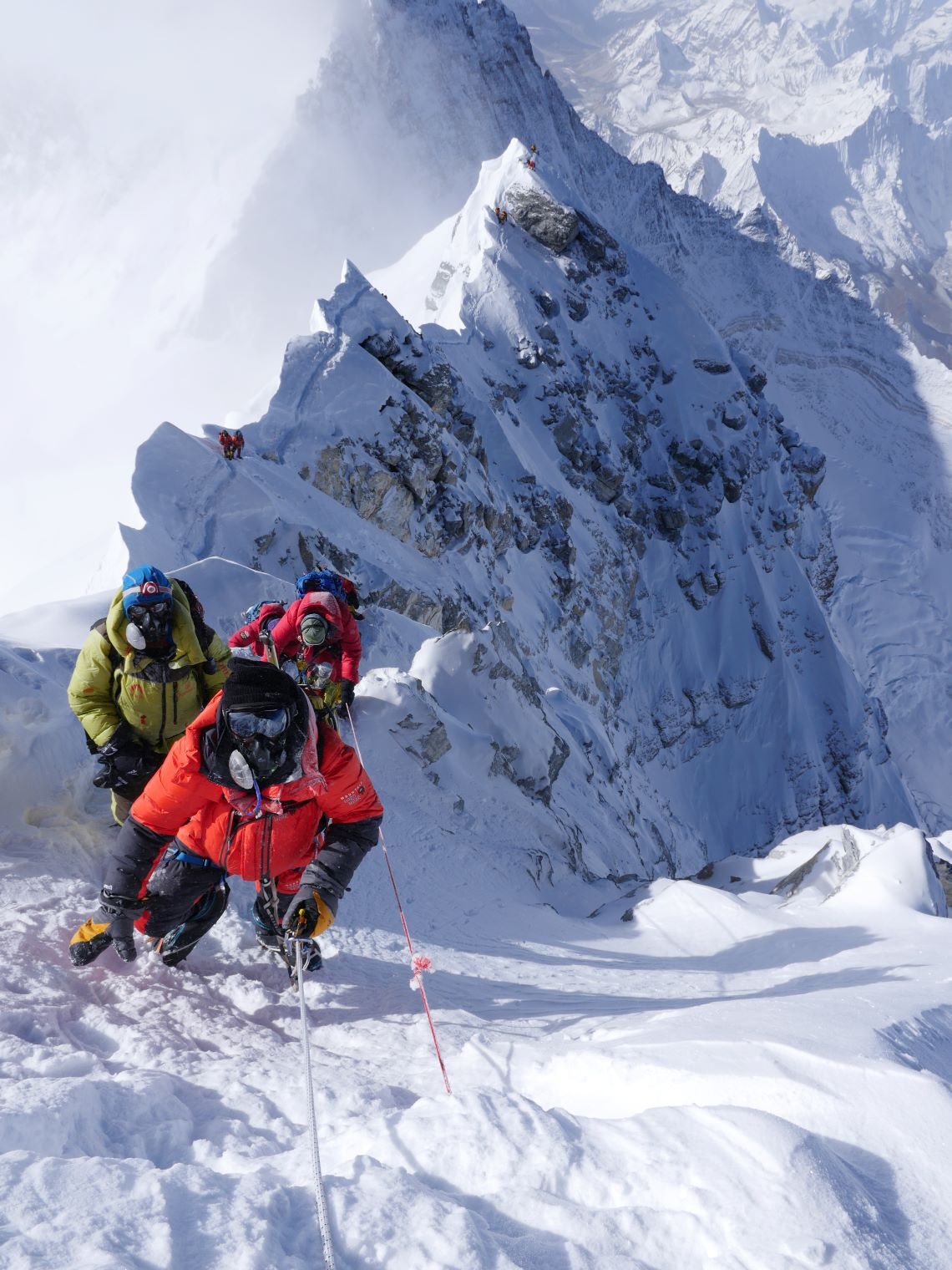
When you climb Everest with Adventure Consultants you'll join a small team of companionable people who are focused on reaching the summit in good style with the highest level of support and safety standards possible. You'll enjoy the best standards of food and equipment that are attainable - not just at Base Camp, but where it counts the most; on the mountain.
Our methodology and tactical approach to climbing Mount Everest has seen us achieve the highest success rates and our extensive experience gives us the edge when it comes to the big decisions. We provide a consistently higher Sherpa and Guide ratio than any other operator , resulting in more support and backup for your summit attempt and therefore a greater safety margin and chance of success.
In the interests of giving you the most optimal chance to summit, we limit our team size to ensure the team summits on the best weather day ; sometimes there is only one summit day! Large teams offering cheap climbs often miss out as they split their groups over several potential summit days.
Our g uides are seasoned professionals certified by the International Federation of Mountain Guides Associations ( IFMGA ) to ensure your safety throughout the expedition. Our experienced Sherpa team is enthusiastic, motivated, and regarded as the strongest and most cohesive group of Sherpas on Mount Everest. They have dozens of Everest summits between them.
You'll benefit from a higher flow of oxygen than other expeditions (sleeping on 1l/min and climbing on 4l/min), maximizing safety and success. Your overnight gear will be carried between camps , meaning you only carry what you need for the day.
We provide a dedicated Base Camp doctor - proven to make a crucial contribution to our success rate and the well-being of the team members. Our Base Camp Manager ensures the smooth running of the expedition. Our Expedition Chef and cooks are regarded as the best in the business, providing wholesome and appetising meals with a range of menus to suit all your food requirements. Meals on the mountain are also of the highest standard and designed to sustain you for the rigours of the ascent. For those with specific needs, we can cater to special dietary requirements.
For three decades we have been at the forefront of providing the most current communications systems for our expeditions. These deliver comprehensive weather forecasts from our Swiss meteorologists which enable us to plan our ascent around favourable weather. Additional meteorological interpretation provided by veteran Everest guides through our head office in New Zealand helps manage the decision-making process. Our Wi-Fi data connection allows you to keep in touch throughout the expedition from the comfort of your tent or our Base Camp lounge.
The comfortable Base Camp environment and the quality of food is legendary . On the mountain, our camps are comfortable but not excessive - eliminating unnecessary additional loads to be carried through the icefall.
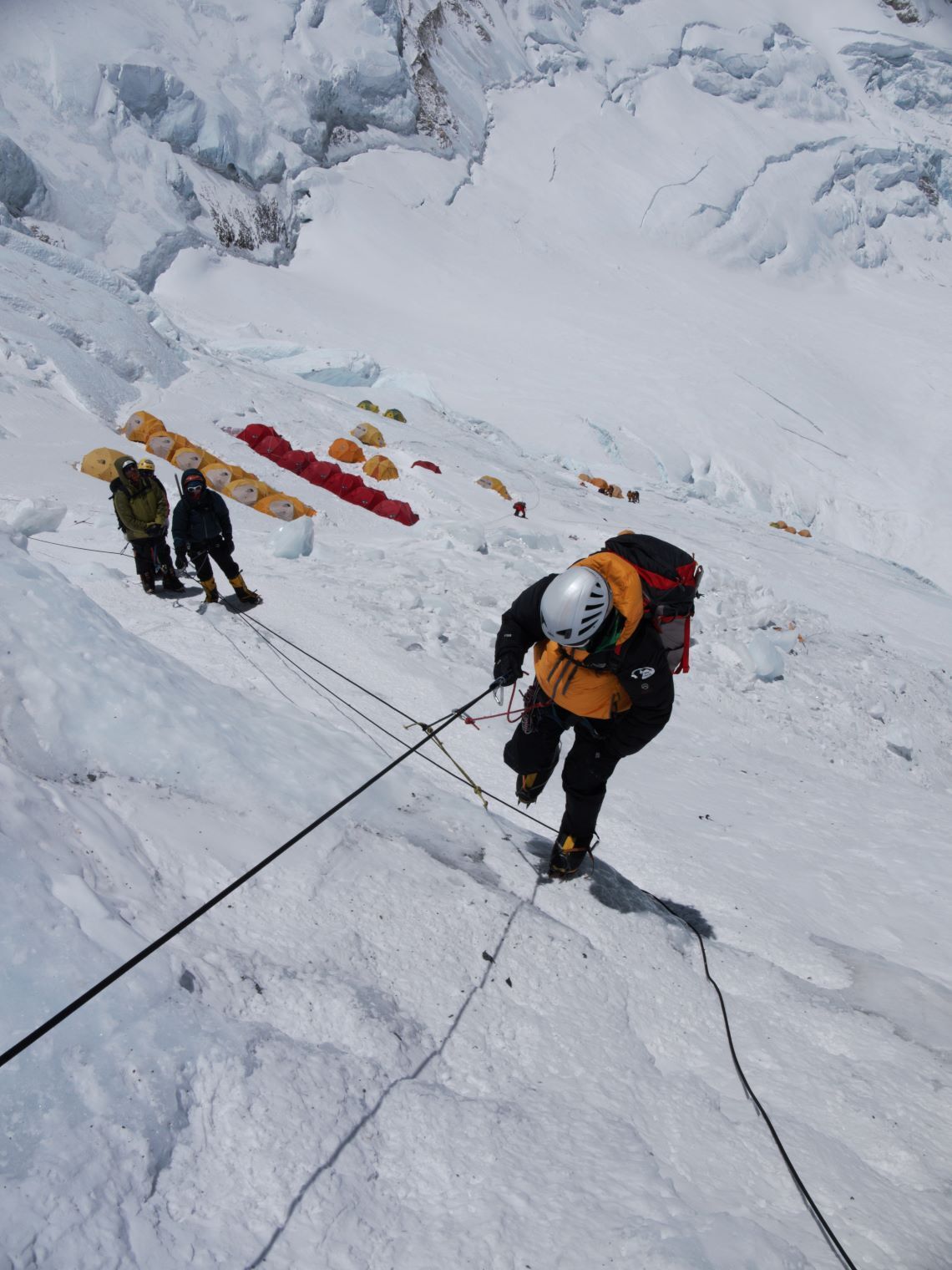
The price of your trip includes the following:
- 1:4 Western guide ratio
- 1:1 Sherpa to climber ratio on summit day
- High Flow Bottled oxygen
- Personal equipment carried on the mountain
- Helicopter flights Kathmandu-Lukla and return
- Expedition Base Camp Doctor
- High-end Base Camp and mountain camps
- Excellent food and catering
- Wi-Fi at Base Camp
- Regular dispatches for families and friends to follow your expedition updated daily by guides and Base Camp staff, and semi-hourly on summit day
- Comprehensive support from our New Zealand office team.
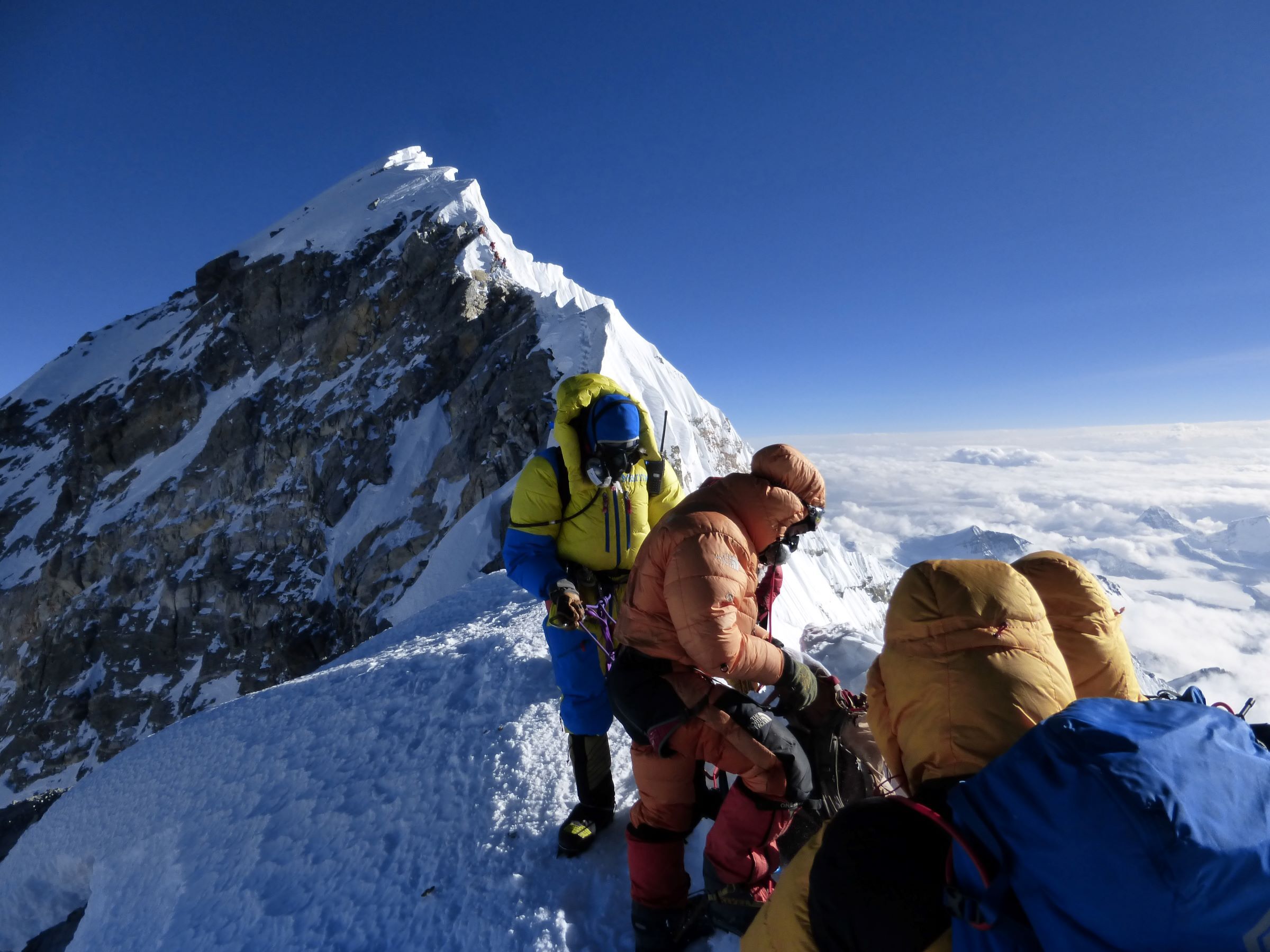
The ridge between the South Summit and the true summit of Mt Everest, is actually the best climbing on the mountain. Views aren't bad either.
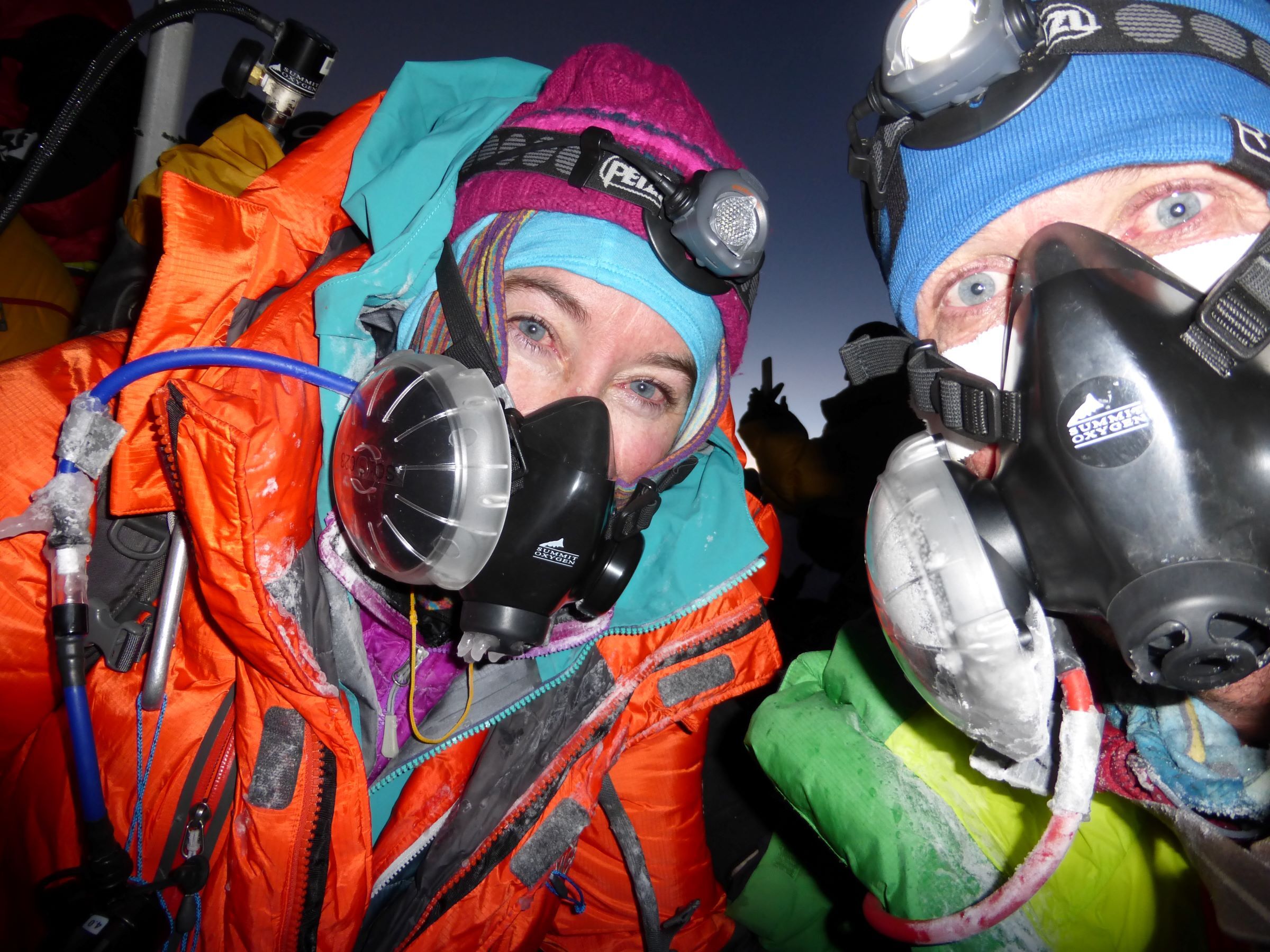
There is nothing like being on the highest summit in the world to bring a smile to your face!
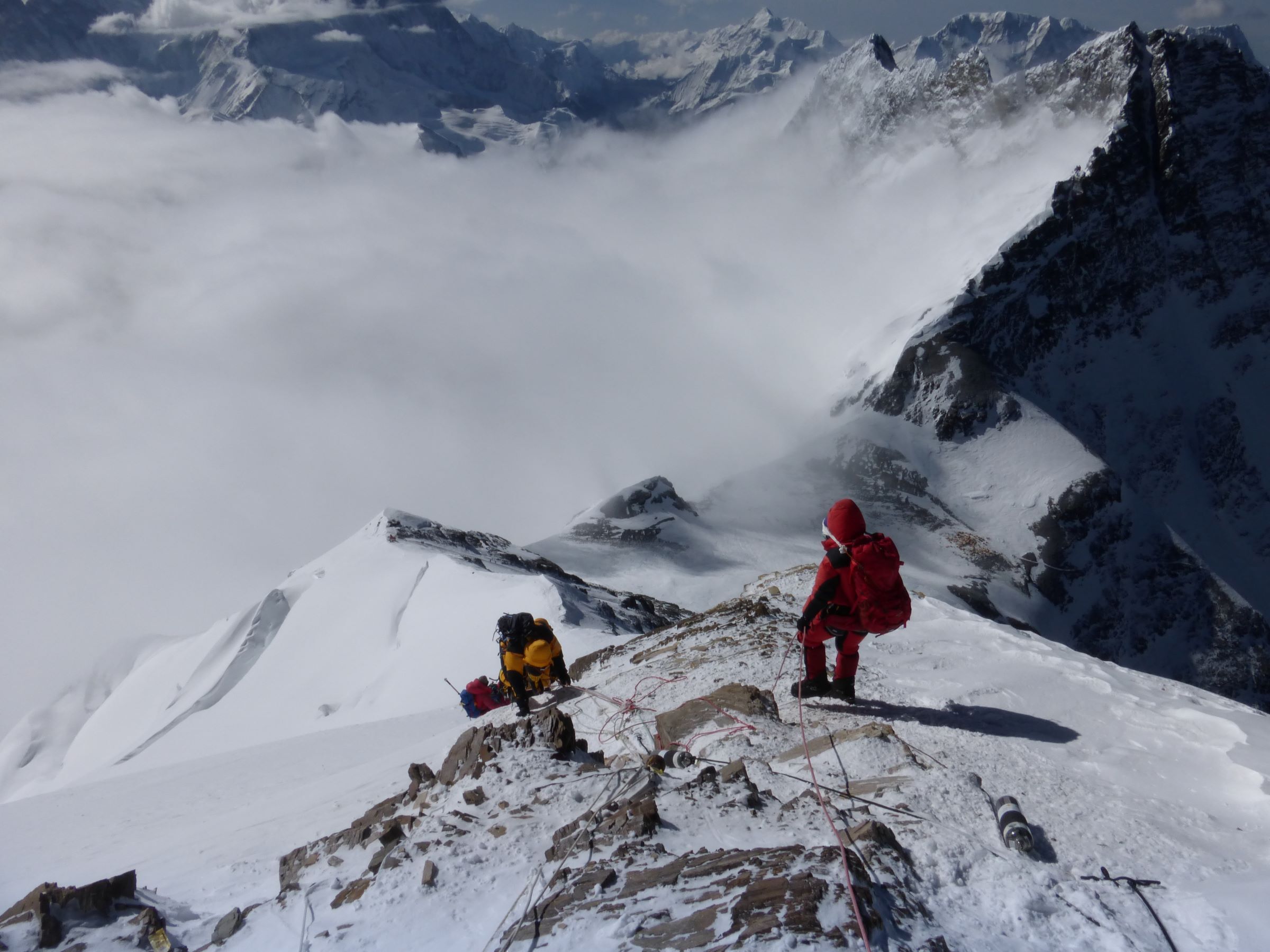
Adventure Consultants guides are focused on your safety and success.

Numerous climbers have achieved the remarkable feat of summiting Mount Everest with Adventure Consultants. Guided by the expertise of the company's seasoned guides, these individuals showcase a diverse array of stories marked by determination and triumph. United by the shared goal of conquering the world's highest peak, they exemplify the spirit of adventure and the resilience inherent in human pursuit of extraordinary achievements. The success of these climbers with Adventure Consultants underscores the company's legacy in facilitating remarkable ascents.
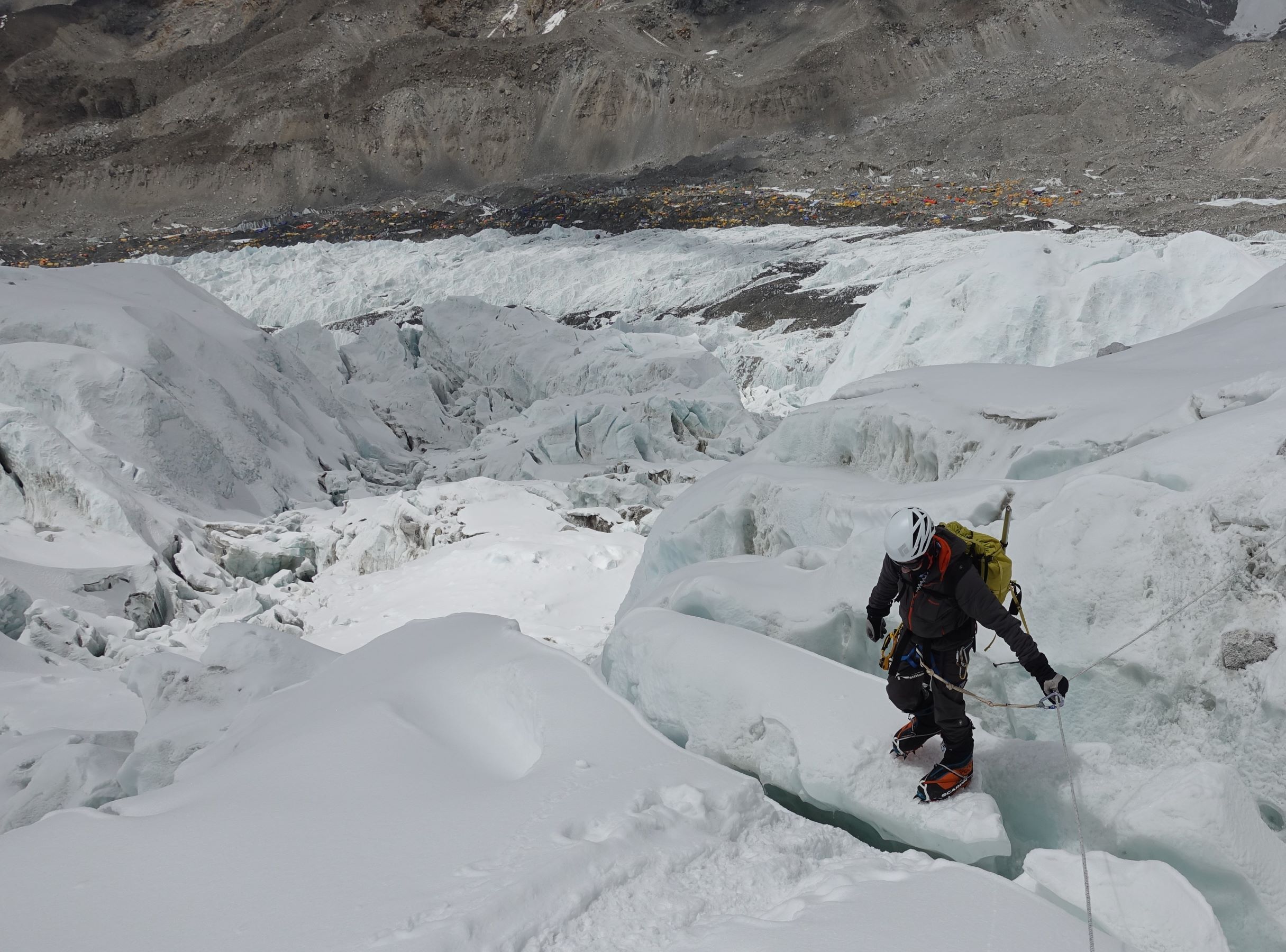
"Would simply say to other climbers if they want the best possible experience go with Adventure Consultants. I can honestly say I think about the whole Everest experience every day of my life and reminisce what an incredible trip it was and how lucky I was to share it with such wonderful people. As Guy says, keep doing it AC style."

"Maximisation of chance to get to the top would be the main reason I would recommend Adventure Consultants . Small group numbers and flexibility. Detailed dispatches were greatly appreciated. I thoroughly enjoyed my trip and never once felt fear or apprehension. Looking forward to climbing with AC again."
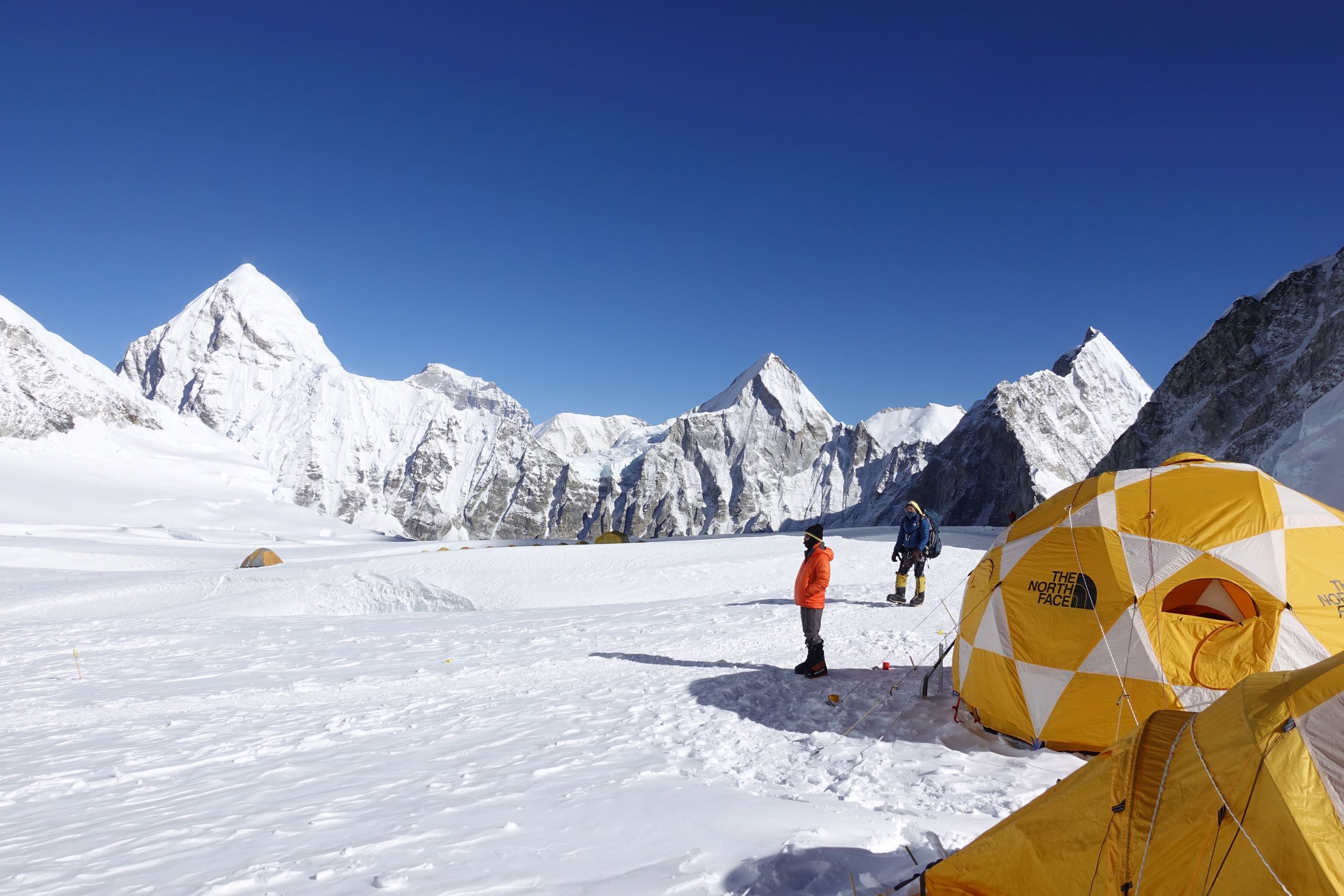
"The guides were exceptional in selecting the best strategic plan that put us all in the best position we could have been in to reach the summit. While others moved into weather unnecessarily, Mike was amazing at patiently placing us on the best days to advance and climb."
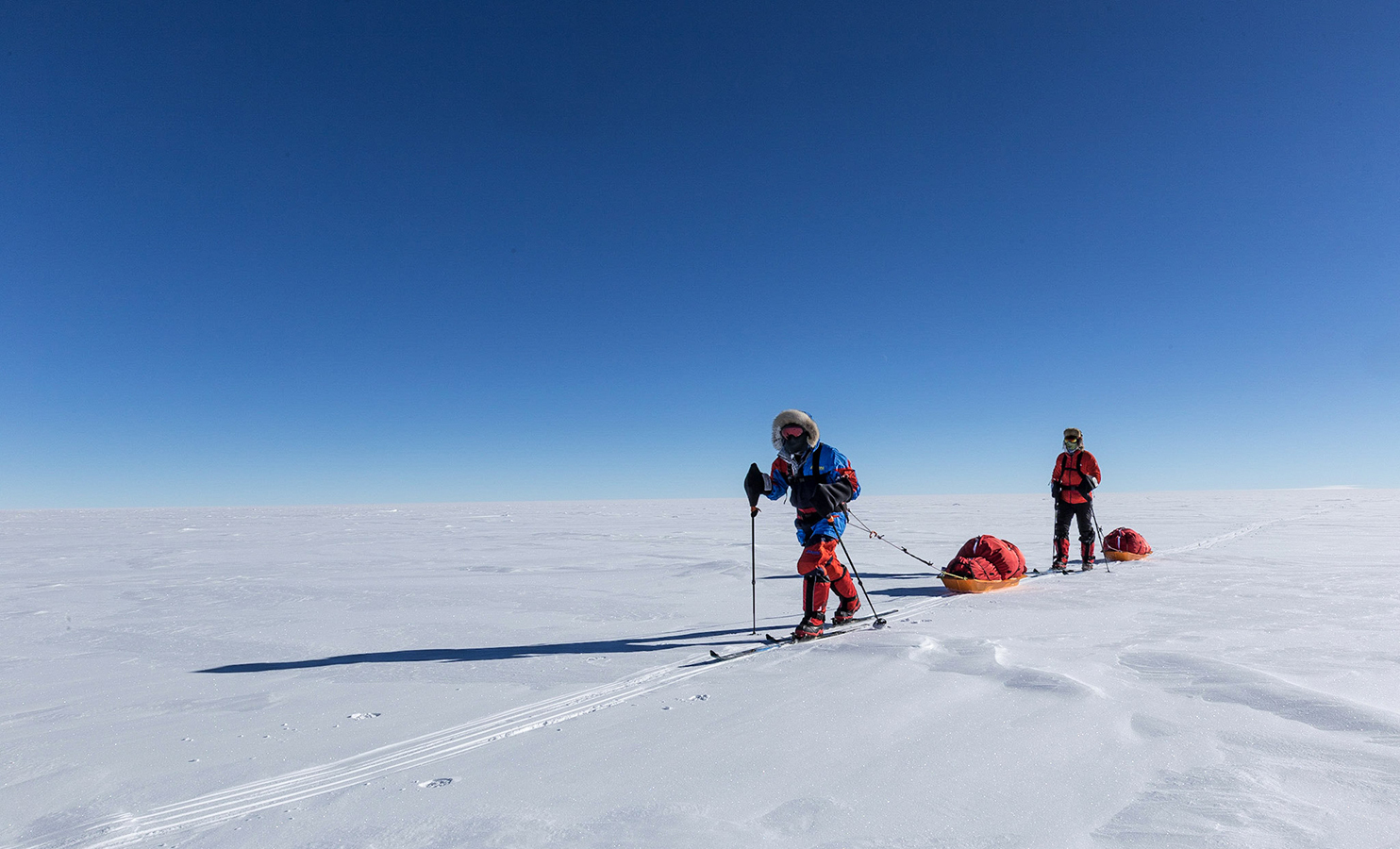
The Explorer's Grand Slam awaits! Join the exclusive club of explorer's that have climbed the Seven Summits and skied to both the North and South Poles!

Tick off another 8,000er! Join one of our scheduled Gasherbrum 1 and 2 , Dhaulagiri, Cho Oyu or Manalsu expeditions or plan a custom expedition .

How Much Does It Cost to Climb Mt Everest in 2024?
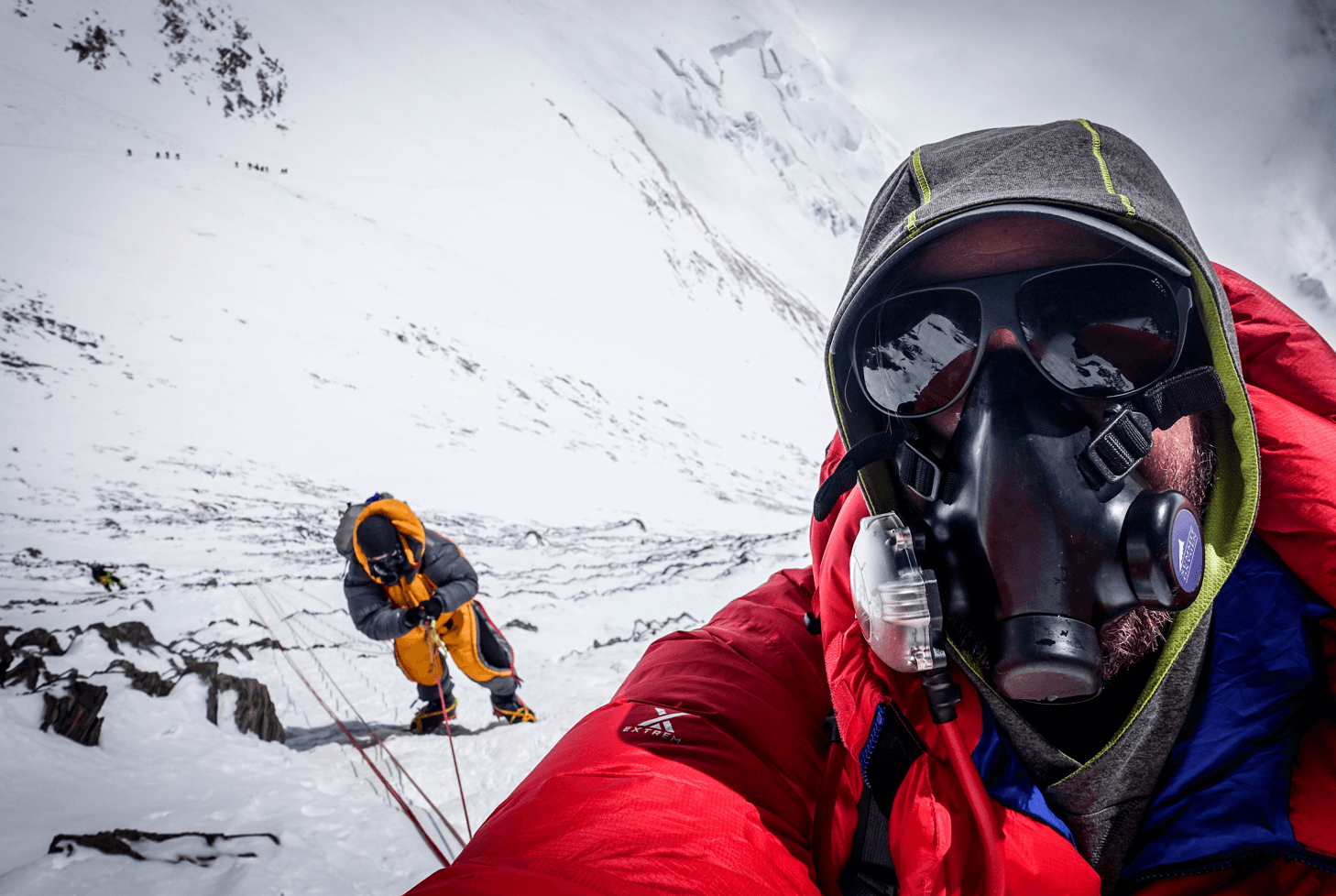
This article has been updated with our latest 2024 data.
With the autumn climbing season already completed in Nepal , places on expeditions to the world’s most iconic mountain range are filling up quickly.
For many climbers with the requisite fitness and high-altitude experience, now may be the time to book that once-in-a-lifetime expedition to Mount Everest , the world’s highest peak.
As with many things in life, the answer to this question is not so simple. However, climbers can expect to spend anywhere between $33,000 (USD) and $200,000 depending on the type of expedition, what is included in the price, and the level of luxury expected.
Keep reading: The Essential Guide to Mountaineering and Trekking in Nepal
According to pricing data from ExpedReview, the average price of an expedition to Mount Everest in 2024 is $59,069, and the median price is $51,000.
However, when private trips and flash expeditions are removed from the equation, both of which are considerably more expensive, the average price falls to $53,448, and the median price falls to $50,500.
By comparison, the average price to climb Everest in 2023 was $55,972, with a median price of $47,995. In 2022, the average price was $55,044, with a median price of $47,498.
While China has opened its borders to regular international travel in 2024, climbing permits are limited.
As a result, climbing Everest via the northeast ridge is difficult and we have not included those prices in this update.

Prices at a Glance
(Slight fluctuations due to expeditions advertised in currencies other than USD)
Why would prices change from one year to the next?
There are many reasons why prices change from one year to the next when climbing Mount Everest.
According to Pasang Sherpa, the managing director of Kathmandu-based Pioneer Adventure , changes in permit fees, government taxes, logistics costs, inflation and the season in which the expedition is held all determine how its price will change.
“If the cost of the above-mentioned factors increases or decreases, there will be possible changes in the final cost we offer to our clients,” he told ExpedReview.
Caroline Pemberton, the managing director of Climbing the Seven Summits , added that mountaineering expeditions in the Himalayas tend to increase in price incrementally each year.
“People can expect climbing in the Himalayas to get more expensive year to year, and prices generally go up industry-wide after the spring climbing season,” she told ExpedReview.
Keep reading: Comparing Everest’s Khumbu Icefall and K2’s Bottleneck
However, Pemberton added that the price jump from 2022 to 2023 would likely be more significant than in previous years due to global macroeconomic headwinds.
“Prices have most definitely seen huge pressure recently from inflation,” she said. “However, we have tried to keep them as steady as possible.”
Pemberton added that price ranges on trips are not unusual and reflect the diversity of services and new levels of customization that guides can afford customers.
“We are not a 'one size fits all' outfit,” she said. “Rather, we recognise that climbers come to us with differing levels of experience, different styles and different budgets, and therefore, we have accommodated by creating numerous expedition options to suit everyone.”
While all prices have generally gone up, not all price changes have been uniform. In general, prices of Western-guided expeditions have increased more than Sherpa-guided ones.
Ryan Water, the owner of Mountain Professionals , told ExpedReview that the rising overhead cost in Western countries partially explained this phenomenon.
Interestingly, the strength of the dollar compared to the British pound (GBP), the Euro and the Nepalese rupee (NPR) means that while some expeditions priced in those currencies are slightly more expensive, they cost less in dollar terms.
While most trips increased in price, Lukas Furtenbach, the owner of Furtenbach Adventures , said his company’s Signature and Flash expeditions, two of the most expensive, remained the same despite the increased costs of running expeditions. “We cover most of this loss,” he told ExpedReview.
What contributes to the price of an Everest expedition?
Four main factors contribute to the pricing of a Mount Everest mountaineering expedition: type of guide, travel, permits and insurance, and supplies and gear.
There are two types of guiding services usually offered for Mount Everest expeditions: all-inclusive or logistics only.
Logistics-only guides offer the bare minimum and are best suited for experienced mountaineers who are willing to take on Everest on the mountain's own terms. Very few people are cut out for this type of expedition. Most climbers who choose the logistics-only option to climb will spend between $32,000 and $60,000 depending on the types of expenses they incur along the way.
Keep reading: A Comparative Analysis of High-Altitude Mountaineering Expedition Costs
By law, every foreign climber in Nepal is required to hire a local Sherpa guide. A logistics-only option means that climbers must arrive at Everest Base Camp (EBC) on their own and would later hire a local company to provide all the necessary camping and cooking gear as well as support staff for the summit ascent.
However, most climbers will opt to avoid all the headaches and paperwork involved in a logistics-only climb and instead opt to pay for an all-inclusive expedition. These expeditions cost anywhere from $40,000 to $100,000, depending on the service.
Traveling to EBC
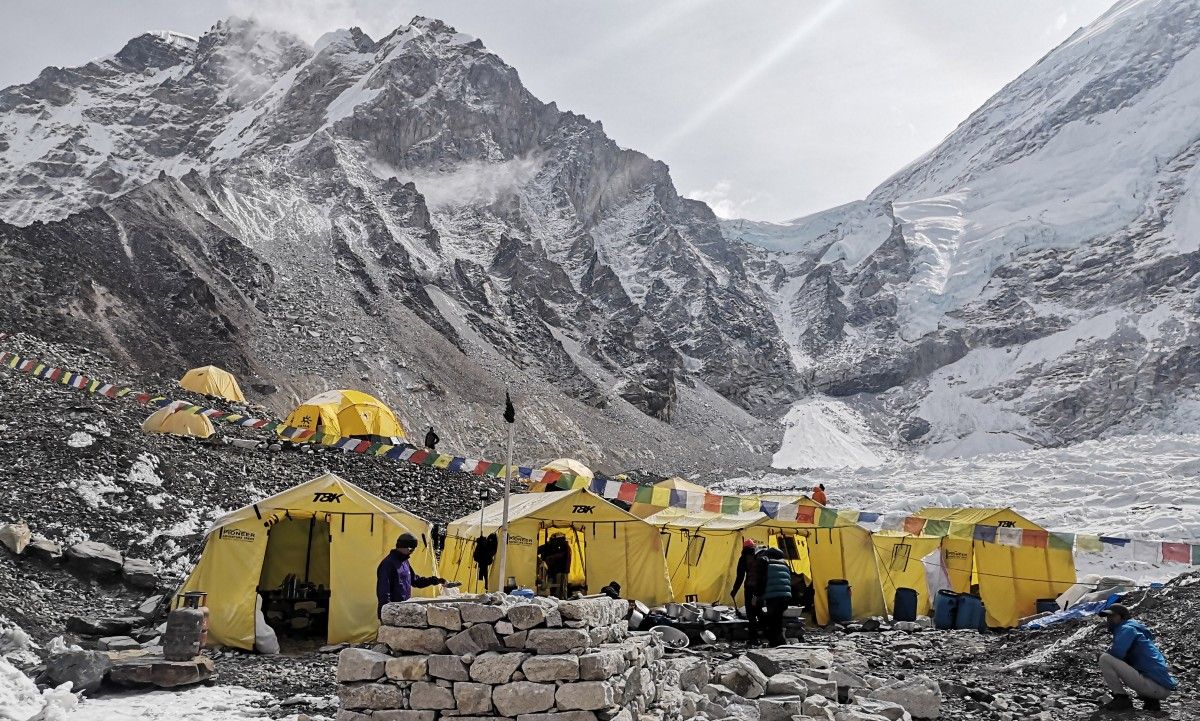
Climbers traveling to EBC on their own should expect to spend up to $10,000 from their point of origin to the base camp.
Before arrival, climbers will need to obtain a Nepali visa and the necessary immunizations, which cost $125 and $225, respectively.
Once all the proper documentation is collected, the next step is to fly to Kathmandu, which can cost anywhere from a few hundred dollars to more than $7,000, depending on the airline and how many layovers are involved.
Once in Kathmandu, climbers who do not have an approved Covid-19 vaccine will need to take a mandatory PCR test. Vaccinated travelers do not need to take the test.
Keep reading: Everest Base Camp Guide: What to Know Before You Go
From Kathmandu, climbers can expect to spend anything from $300 to $500 for roundtrip tickets to and from Lukla. To save some money, it is possible to take a bus to Jiri and trek five days to Lukla and then on to EBC.
From Lukla to EBC, climbers can expect to spend between $400 and $1,000 per person for food and lodgings. The amount spent will depend on the quality of the places in which the climber stays.
It is possible to save quite a bit of money on this step of the trip by camping in approved places instead of staying in teahouses.
Away from eating and sleeping, climbers also need to transport all of their gear to base camp. A combination of yak and porters usually does this. Climbers can expect to spend between $20 and $40 per day per load for yaks and $20 per day per porter. The total cost of transporting gear usually comes out to at least $1,000.
Permits and Insurance
The permit cost in Nepal is fixed at $11,000 per climber.
However, this does not include the cost of a local company to organize the permit (required by Nepalese law), which is $2,500 per expedition. It also does not include the costs of a non-refundable trash deposit ($4,000 per permit) or the payment for a liaison officer ($3,000 per team).
When all is said and done, climbers will spend about $20,000 before setting foot in Nepal.
Keep reading: What is Acute Mountain Sickness (AMS)?
In terms of insurance, most guiding companies require a minimum of evacuation insurance. However, many others require medical insurance too.
Trip cancellation insurance is also a smart investment in case the climbing season ends abruptly due to natural disaster.
It is very difficult to give price estimates for insurance as these are highly variable and depend on age and trip length. However, expect to spend anywhere from $70 to $5,000.
Supplies and gear
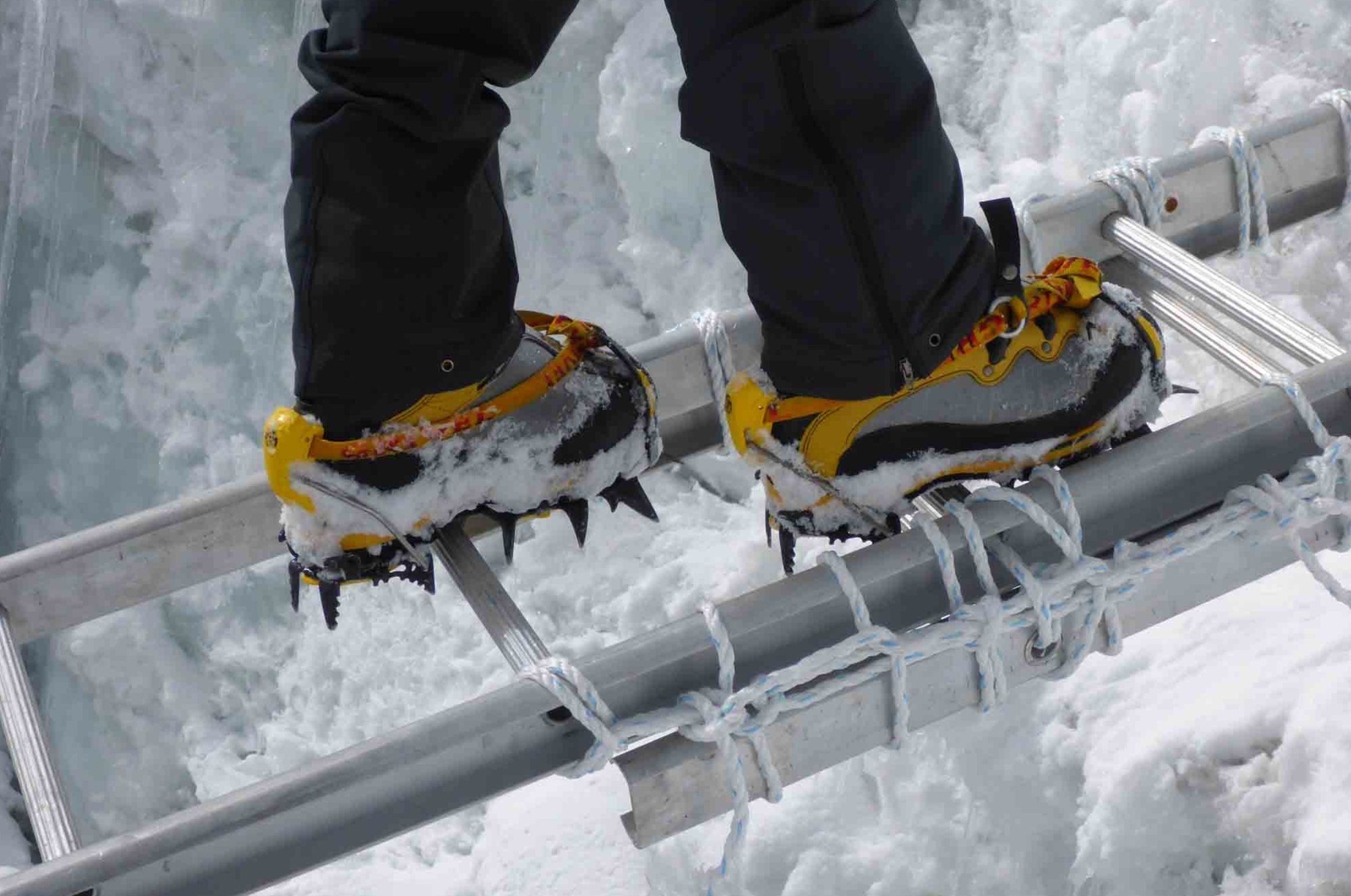
Climbers heading to Mount Everest should expect to spend up to $30,000 on gear and supplies during an Everest expedition.
This includes about $5,800 for food, fuel and a local cook for a six-week trip. While $5,000 can be saved on the cook, it is generally a good idea to hire one.
Virtually all climbers – 97 percent – require supplemental oxygen for the ascent, which costs $550 per bottle. Most climbers will require at least five bottles, along with a mask ($450) and regulator ($450) for the ascent and descent, totaling $3,650.
Strong and experienced climbers may opt to haul their supplemental oxygen up the high camps on the mountain, but many will use Sherpas instead. Furthermore, it is customary to provide Sherpas with supplemental oxygen, which will cost an additional $2,000 (they use less oxygen).
Away from food and oxygen, climbers will also need all the proper gear to climb. This includes boots , crampons , down suits, clothing layers, gloves, sleeping bags and backpacks , among other things. Buying all the proper mountaineering gear new will cost about $7,000. This price can be cut down by buying some of the equipment lightly used online.
All-inclusive guides
Many climbers will opt to avoid all the headaches and paperwork involved in a logistics-only climb and instead opt to pay for an all-inclusive expedition. These expeditions cost anywhere from $30,000 to $100,000, depending on the service.
Nepali operators tend to be the cheapest. According to data from ExpedReview, the median cost of these expeditions is $39,499. They tend to be led by experienced Sherpas, many of whom will have no formal guiding qualifications. A number of the cheaper options also do not include any expenses prior to arrival in Lukla.
The mid-range option is to book a Western guide service that employs a Sherpa guide. The median price for these types of expeditions is $47,995. This option usually includes all of the aforementioned costs (except personal gear) from the previous sections.
Keep reading: Rolfe Oostra on the Hidden Costs of Low-Budget Operators
The main difference between this and the Nepali operators is the Sherpa guide will have a partial UIAGM certification (usually without the ski touring part), which is more expensive than a non-certified guide but less expensive than a fully-certified Western guide.
The most expensive option is the Western guide service with a Western guide, which has a median price of $65,000. This option also tends to include all of the aforementioned costs (except personal gear) from the previous sections. While it is the highest price, there are certain advantages of traveling with a Western guide.
All guides from these types of agencies will have an IFMGA/UIAGM-certification . This is likely to increase your chances of making it to the top and minimises the risks involved with climbing at extremely high altitudes.
Now you know before you go!

Compare prices, itineraries and certified reviews of many guides that lead trips up Mount Everest on ExpedReview. Begin planning your trip to the top of the world today!
Recent posted
Related locations.
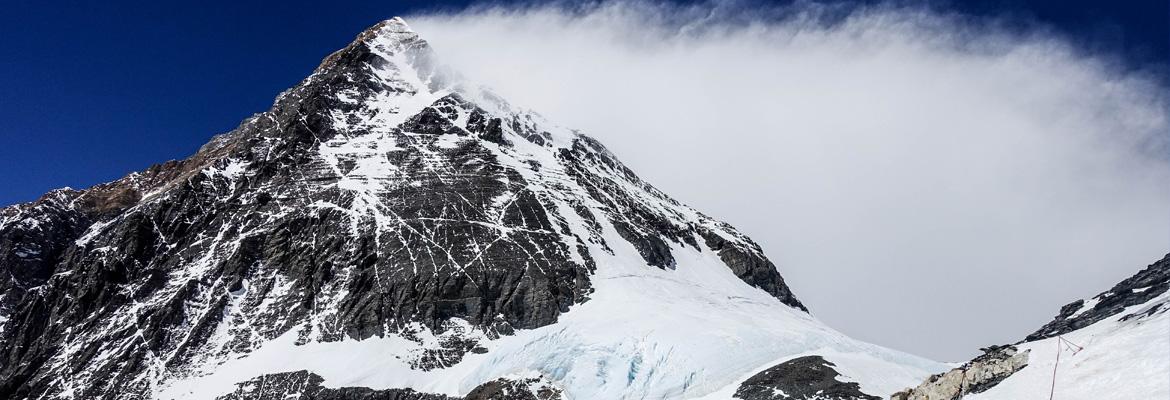
Related articles
Mount Everest Ascent
The roof of the world
Join our guides as we climb to the summit of Mount Everest and gain the mountaineer’s ultimate expedition prize — an ascent to the top of the world. The expedition to Everest is an unparalleled journey of both legendary and epic proportion. With our full service approach to climbing Mount Everest you experience the highest chance for success — you need only gain the experience required and bring your determination.
The preparation itself for the climb of Mount Everest may include expeditions to Aconcagua , Nun , Vinson and other adventures that are worthy on their own. The commitment, training, focus and preparation climbs make this one of the world’s most incredible and rewarding lifetime journeys.
Isn’t it obvious? But, ok; Mountain Madness climber Julio B. summed it up nicely, “ Watching the sunrise from the Balcony was the realization of a dream. The Tibetan highlands yawned to my left, Nepal on my right, and the Earth’s curvature visible on the horizon.” After climbing Mount Everest, once you’re standing on top of the world, the hard work, pain and suffering, and the nagging question of why am I doing this? , all seem to dissolve into the ether.
Description
Since the late 19 th century, adventurous spirits have been fascinated with the ascent of the highest mountain in the world. Mt. Everest rises to an imposing 29,029 feet / 8848 meters, and after 29 years of numerous attempts, Sir Edmund Hillary and Sherpa Tenzing Norgay became the first people to stand on the elusive summit on May 29, 1953. These courageous climbers ascended through to the South Col from the Khumbu Glacier, and continued their ascent to the summit via the Southeast Ridge. Their route is now referred to as the Normal Route and is the route ascended by Mountain Madness.
Our team will use classic expedition methods to gain the summit. We will start the acclimatization process with the trek to base camp. We will provide each member their own private tent at base camp. After a short rest, we will make the brief trek over to the base of Lobuche Peak for an acclimatization summit climb to 20,075 feet/6,119 meters. Once on Everest three-person, four season tents will be used. Two to three people will sleep in each tent at higher camps. A pyramid of camps will be established by the guides and Sherpas who will fix ropes, stock camps and provide leadership and support for the climb. This will enable you to carry lighter loads, thus saving your strength for the summit bid. Oxygen will be provided for all team members and is traditionally used above Camp III. With tremendous leadership, our strong team of high altitude Sherpas, and the finest equipment and services, you will have an outstanding shot at reaching the summit of the highest mountain on the planet.
Want to climb Mt. Everest without going to the summit? Check out our Khumbu Icefall Climb to 21,000 feet or our Everest Base Camp Trek to experience what all the buzz is about.
Mountain madness strategy.
Mountain Madness has been running successful expeditions to Everest since 1994 with more than 40 team members making it to the top of the highest point on earth. Our focus is on individual attention to our team members and this is accomplished by keeping our groups small, with average group size about 3 – 6 members. We are committed to providing you with the best quality service and experience to help you reach your goal.
Current Mount Everest Expeditions
Mountain Madness tends to run expeditions every other year or based on demand. For some team members the planning starts years before the climb and this allows us to organize according to individual’s schedule and what additional training they may need before embarking on this expedition.
The Climbing Strategy for Everest
Because it’s critical to acclimatize properly to maintain health and fitness and avoid altitude problems , Mountain Madness begins the slow acclimatization process with a leisurely 9‑day trek to base camp. Once at base camp a pyramid of camps is established. Our experienced guides and Sherpas will fix ropes, stock camps and provide leadership and support for the climb. This enables you to carry lighter loads and save your strength for the summit bid. Oxygen will be used for all team members above Camp 3.
The highest camp in the acclimatization process is Camp 4 at nearly 8000 meters, and from there we will begin our summit attempt. Team members leave for the summit late evening to allow adequate time to reach the summit by mid-morning. Mountain Madness equipment, service, and support are of the highest quality, providing you with an outstanding chance of reaching the top of the highest mountain on the planet.
All Mountain Madness lead guides on Mount Everest have made successful ascents on the mountain. In addition to having summited Everest, our lead guides have extensive past high-altitude guiding experience that will contribute to your chances of success. Our client to guide ratio is 4:1 for the lead Western guide, with a 1:1 client to Sherpa guide ratio. Our Sherpa Team is one of the best teams of high altitude climbing support on the mountain. Our Nepal staff has worked with us for many years to ensure quality and dependable performance. Many of our Sherpa staff also have multiple ascents of Mt. Everest.
Qualifications
Climbing to the roof of the world is a serious undertaking for any mountaineer. We require that you have proven high altitude experience, technical proficiency, and the physical fitness to handle the rigors of the ascent. You should be familiar with extreme cold, extended hypoxic conditions, tent living, exposure to steep terrain, and more.
Climbing Mount Everest: Do You Need Training?
Yes, all climbers are required to have past high-altitude mountaineering experience . In addition, members should be able to ascend and descend fixed lines independently and be proficient with cramponing on steep ice/snow slopes.
An example of sufficient training & experience would include a combination of the following in a logical progression:
- Technical training in the Washington Cascades or international course. Examples: Alpine Ice Course , Ouray Ice Courses , Ecuador Mountaineering Course , or Bolivia Mountaineering Course
- Ascents of 6,000 meter peaks in South America or Asia. Examples: Ecuador Volcanoes , Aconcagua , Chopikalki , Bolivia’s Cordillera Real , Island Peak , or Ama Dablam
- Denali or Vinson and/or a 7000 – 8000 meter peak such as Pik Lenin , Nun Peak , or Cho Oyu .
Mount Everest
Mental Fitness: On Everest, your attitude and mental toughness will dictate whether your reach the summit as much as your physical fitness. Mountain Madness will do its part to prepare the way, but when the time comes to push for the summit, your mental strength will decide whether or not you make it. Arriving on the mountain as mentally and physically prepared as possible will certainly increase your chances of summiting.
Exercise: Proper conditioning is critical to your success on Everest. Obviously, good physical conditioning is essential to be successful at high altitude. Your training regimen should include intense cardiovascular workouts as well as overall strength building. Your aim should be to gain muscle mass and endurance. Long distance running, mountain biking, and cross country skiing are several sports which will help you get in shape. Get your heart rate up and keep it there for long stretches. Your workout schedule should include four to five days of cardiovascular training 1 to 2 hours minimum per workout. Being able to hike or climb stairs with a 50 lb/23 kg pack with 3,000 feet/909 meters elevation gain at least two days a week is imperative. Heading into the climb as prepared as possible will help give you the edge to go for the top. Hit the weights for upper body conditioning. Imagine the strain of jugging (ascending) fixed lines at 25,000 feet/8,250 meters on the Lhotse Face, or climbing the Hillary Step at 28,000 feet/8,485 meters, then head for the gym! Our climb is pre-monsoon, and the Lhotse Face will be icy, so get those calves in shape for front pointing!
Reading list
EVEREST/CLIMBING
Everest: The West Ridge Hornbein, Tom 1989. 181 pp, color photos. The first American ascent of Everest, and traverse of the summit via the West Ridge.
High Adventure Hillary, Edmund 1955, 1 st UK or American edition. 224 pp, 22 ill. Hillary’s principal book on his Everest climb. Includes the 1951 Reconnaissance Expedition, the Cho Oyu attempt, and his Everest success.
Kathmandu to Mount Everest Uchida, Ryohei 1991. 128 pp, 180 color photos. A complete description of the entire Khumbu region of Nepal, with lavish photographic coverage. Practical information on travel and trekking.
Seven Summits Bass, Dick; Wells, Frank and Ridgeway, Rick 1986. 336 pp, color photos. Bass was the first person to climb the seven continental summits. This book started the modern quest to climb continental, national and state high points.
The Crystal Horizon Messner, Reinhold 1998. 322 pp, color photos. Messner’s remarkable solo ascent of Everest without oxygen has captured the imagination of the climbing world like no other single event since the first ascent in 1953. This is his record of the mental, emotional and physical efforts to succeed beyond the limits of human endurance.
Climbing Mt. Everest: A Bibliography Salkeld and J. Boyle 1993. A bibliography of every book or magazine article ever written on Mt. Everest. Includes a chronology of climbs.
Trekking in Nepal: A Traveler’s Guide Bezruchka, Steven Mountaineers, Seattle, Washington; sixth edition, 1991.
Insight Guide to Nepal Hoefer, H.J. et al A.P.A. Productions, 1983 (Highly Recommended). 30
Insight Guide to Nepal Raj, Prakash
Lonely Planet, South Yarra, Vic. Australia.
Many People Come, Looking, Looking Rowell, Galen The Mountaineers, 1980.
HISTORICAL
An Account of the Kingdom of Nepal, and of the Territories Annexed to This Dominion by House of Gurkha Hamilton, Francis Archibold Constable and Co. Edinburgh, 1819.
History of Nepal Wright, Daniel, editor; Vamsavali With an Introductory Sketch of the Country and People of Nepal. Translated from the Parbatiya. University Press 1877, Cambridge. Second Edition, Susil Gupta, Calcutta 1958.
PEOPLES, ART AND CULTURE
Hindu-Buddhist Festivals of Nepal Hemanta K. Jha South Asia Books, 1996.
Festivals of Nepal Anderson, Mary M George Allen and Unwin, London, 1971.
The Art of Nepal Aran, Lydia Ratna Pustak Bhandar, Kathmandu, 1974.
People of Nepal Bista, Dor Bahadur
Rhythms of a Himalayan Village Downs, Hugh R. Harper & Rowe, New York, 1980.
The Sherpas of Nepal & Buddhist Highlanders Furer-Haimendorf, Christoph von University of California Press, Berkeley and Los Angeles, 1964.
Schoolhouse in the Clouds Hillary, Edmund Doubleday, Garden City New York, 1964.
Moral Knowing in a Hindu Sacred City: An Exploration of Mind, Emotion, and Self Parish, Steven M. 31 Columbia University Press, New York, 1994.
The Splendour of Himalayan Art and Culture Jeratha, Asoka Indus, 1998.
The Way to Shambhala Bernbaum, Edwin Anchor Press, New York, 1980.
The Gods and Goddesses of Nepal Detmold, Geogrey Rubel, Mary Ratna Pustak Bhandar, Kathmandu, 1979.
Mani-Rimdu, Sherpa Dance Drama Jerstad, L.G. University of Washington Press, Seattle, 1969.
An Introduction to Hinduism Flood, Gavin D. Cambridge University Press, Cambridge, 1996
Hinduism Sen, K.M. Penguin Books, Harmondsworth, 1961.
High Altitude Medicine and Physiology West, John B. Schoene, Robert B. Milledge, James S. Chapman and Hall, Great Britain, 1989.
Have a Question? Contact Us!
- (800) 328-5925
- [email protected]
$67,000 – 69 Days / Includes travel time
Price Includes
4:1 client to lead guide ratio, plus 1:1 client to Sherpa guide ratio
- Climbing permit and park fees
- All oxygen equipment — bottles, mask and regulator
- Domestic airfare to/from Kathmandu to Lukla
- Four scheduled hotel nights in Kathmandu at the Yak-n-Yeti (double occupancy)
- Scheduled restaurant meals in Kathmandu
- All food and lodging during the trek and climb
- All team climbing gear, tents and cooking gear
- All expedition staff including Sherpa support, base camp personnel, porters and pack animals
- Airport transfers
- Phone and wireless internet available in base camp for additional fee
Price Does Not Include
- International airfare
- Nepal entry visa and airport fees
- Personal climbing gear and clothing
- Personal expenses (phone calls, laundry, room service, extra hotel nights, extra meals, tea house showers, etc.)
- Travel insurance with trip cancellation, medical and evacuation policy
- All expenses associated with non-scheduled departure
- Lunch on Days 3, 67 & 68
- Alcoholic and bottled beverages
- Guide/Sherpa/Staff gratuities
Payment Schedule
- $10,000 non-refundable deposit upon confirmation of your eligibility to join the expedition
- $57,000 non-refundable balance due 120 days prior to departure
- Payments can be made by check, wire transfer, ACH or credit card with a 3% convenience fee
Mount Everest - custom climbs only- call for details
- Mar 29, 2024 — Jun 2, 2024
- Mar 29, 2025 — Jun 2, 2025
Cancellation / Refund Policy
- MMI strongly recommends trip cancellation/interruption and evacuation insurance for Mount Everest Expedition. Our insurance partner, Ripcord , offers comprehensive travel insurance including trip cancellation, as well as rescue/evacuation policies and can assist in answering any questions. In addition, Participant is expected to have sufficient medical insurance as prescribed by their country of origin. Participant understands that MMI does not include any type of insurance with the cost of the trip.
- If you decide to cancel your trip or change your itinerary, MMI must be notified in writing. Your trip will be cancelled from the date written notice is received and all amounts paid will be forfeited.
- Circumstances outside the control of MMI and its partners, may require amended cancellation/refund policies. Such circumstances may include, but are not limited to COVID-19, natural disasters, terrorism and so forth.
- No refunds on the deposit, nor balance payment will be provided for Mount Everest Expedition due to the great expense incurred planning/facilitating such an expedition.
Trip Insurance
We strongly recommend the purchase of travel cancellation insurance to protect you from the unexpected. You aren’t likely to think of it now, but people do get ill, break a bone, have a family emergency or get assigned to a last-minute business trip. If you are in remote areas, please note that emergency rescue & evacuation can be very expensive.
We also strongly urge you to consider rescue and evacuation insurance if your own policy does not provide the coverage needed. Services available may include, but are not limited to, helicopter evacuation, medical care, etc.
If you choose not to purchase insurance, you assume full responsibility for any expenses incurred in the event of a medical emergency and/or evacuation, as well as for trip cancellation, interruption, lost luggage, etc. We are not the experts and therefore ask that you please consult our travel insurance partner directly with any specific questions.
To protect against losses due to illness, accident, or other unforeseen circumstances, Mountain Madness strongly recommends the purchase of travel insurance as soon as possible after making a deposit. Mountain Madness has partnered with Redpoint Resolutions as our preferred travel insurance provider. Redpoint’s Ripcord Rescue Travel Insurance™ is designed for adventurers.
For a quote, or to purchase travel insurance, please click this link Ripcord Rescue Travel Insurance™ or call +1 – 415-481‑0600. Pricing varies based on age, trip cost, trip length, and level of coverage.
Critical benefits of Ripcord Rescue Travel Insurance include:
- A completely integrated program with a single point of contact for emergency services, travel assistance, and insurance claims
- Evacuation and rescue services from your point of injury or illness to your hospital of choice
- Comprehensive travel insurance for trip cancellation/interruption, primary medical expense coverage, baggage loss or delay, emergency accident and emergency sickness medical expense, emergency dental, accidental death and dismemberment, and more
- Optional security evacuation coverage in case of an unplanned natural disaster or other security events
- Waiver for pre-existing conditions (must be purchased within 14 days of tour deposit)
- Optional “ Cancel for Any Reason” coverage (must be purchased within 14 days of tour deposit)
Flight Information
The total number of days for your trip includes all travel to and from your destination, with some exceptions. Dates listed on the website start with your departure date from the US and include the day you arrive home.
For this trip you will need to arrive in Kathmandu, Nepal on Day 3 of the itinerary. You will cross the date line in mid-flight to Asia, thus losing a day. If you are traveling from outside the US. your itinerary may require less time to reach Kathmandu, so all that is required is that you arrive on Day 3 of the itinerary, where Mountain Madness services begin. If you arrive early, we can assist with extra hotel arrangements and activities. Otherwise, you can arrive at any time on Day 3. You will be met at the airport by a Mountain Madness representative and transferred to your hotel.
Please contact our office for any help needed with flight schedule.
Day by Day
Please contact our office for a complete Everest itinerary.
Equipment for Mount Everest Ascent
Carrying gear, small pack (40l).
Lightweight as possible with a volume approximately 2,500 cubic inches (40 liters)
Osprey Mutant 38, Black Diamond Speed 40
Large capacity climbing pack (65+L)
Lightweight as possible with a volume of 4,000+ cubic inches (65+ liters)
Osprey Aether 70, Black Diamond Mission
2 Large duffel bags
Two at least 7,000 cubic inch capacity (150 liters). Must be durable and waterproof
Patagonia Black Hole
Small duffel bag
Large enough to hold everything you’re not taking on the mountain. Will be stored at hotel, to be used after trip
Small padlock for duffel bags
Extra security
Baggage tags
Makes identifying your bags easy at airports or hotels
Sleeping Gear
Expedition quality sleeping bag (-20f down).
One down bag rated from -20°F / -30°C
Feathered Friends Ptarmigan, Marmot Col
Expedition quality sleeping bag (-40F Down or Synthetic)
One down or synthetic bag rated from -40°F / -40°C
Feathered Friends Snow Goose EX, Marmot Cwm
Sleeping Pad (insulated inflatable X 2)
Two full length inflatable
Therm-a-Rest NeoAir XTherm
Sleeping pad (foam)
A foam pad will be provided but a supplemental sleeping pad is advised for warmth and comfort. Closed cell foam 3/4 or full length. This pad is used in conjunction with the first pad
Therm-a-rest Ridgerest
Climbing Gear
Alpine climbing harness.
Must have adjustable leg loops and fit over all clothing
Black Diamond Couloir, Petzl Altitude, Petzl Hirundos
Mountaineering ice axe
under 5’7” use 60cm, 5’7”-6’2” use 60 or 65cm, over 6’2” use 70cm
Black Diamond Raven, Petzl Glacier
Crampons w/ anti-balling plate
Steel 12-pont. Must be fit to climbing boots prior to trip, new-matic/hybrid type
Black Diamond Sabretooth, Petzl Vasak
Locking carabiners (3)
Three large, pear-shaped carabiners are best
Black Diamond Rock Lock, Petzl William, Petzl Attache
Non-locking carabiners (8)
8 non-locking carabiners. wired straight-gates are recommended
Black Diamond HotWire
Belay device (plaquette)
Black Diamond ATC Guide, Petzl Reverso
Ascenders (Pair)
One full set of ascenders with handles for fixed lines
Petzl Ascension
Climbing helmet
Lightweight
Black Diamond Half Dome, Petzl Elios
50’ of perlon accessory cord
Accessory cord, made of nylon, is useful for many purposes on an expedition. You should bring 50 feet of 6mm cord
Adjustable trekking poles
Three piece poles recommended
Black Diamond Trail Back Pole
Head and Face
Fleece or wool hat.
It must cover the ears
Shade hat or baseball cap
A visor hat with a good brim is essential for protection from the sun
Mountain Madness trucker hat
Bandanas or neck gaiter
Various uses, i.e. cleaning glasses, sun protection when tied around the neck, etc. We have our own Mountain Madness neck gaiter available for purchase!
Mountain Madness neck gaiter
Balaclava or Buff
A thin balaclava will add significant warmth on that cold summit day
Outdoor Research, Marmot
Neoprene or microfleece ski type
To protect you from the wind and sun
Glacier glasses
100% UV protection with side shields and a hard-sided storage case
Ski goggles
To fit over glacier glasses in high wind. Rose or amber lenses
Smith, Oakley
Leather work gloves
One pair lightweight to spare your climbing while doing camp chores
Liner gloves
Two pairs thin fleece or synthetic
Softshell gloves
One pair medium-weight for daily wear when it’s not too cold
Black Diamond Arc, Arcteryx Zenta LT Glove
Expedition gloves
Insulated, water resistant shell with leather palms
Black Diamond Guide
Expedition mitts
One pair Gore-Tex or equivalent, with textured palms and taped seams. Synthetic or down filled. Warm, heavy duty for cold temperatures
Outdoor Research Altimitt
Thin socks (6 pair)
Six pairs of synthetic or wool socks to wear under heavy wool socks to help prevent blisters and keep feet dry
Smartwool or Cool Max
Thick socks (6 pair)
Six pairs of synthetic or wool socks, medium to heavyweight. Check boot fit with thin and thick socks on
Smartwool or Thorlo
Synthetic or down to keep feet warm while in tent
For warmth and comfort at base camp
Sorrel Caribou, Uggs
High-altitude double mountaineering boots (8000m)
Insulated boots rated for 8,000-meter peak climbs with a warm removable liner and built in, insulated overboot
La Sportiva Olympus Mons, Scarpa Phantom 8000
Light hiking boots or trail shoes
For acclimatization hikes
Salomon X-Ultra 3 Mid, Merrell Moab, La Sportiva Boulder Ex
Synthetic t-shirts
Two synthetic or merino wool t-shirts. No cotton!
Long-sleeved Base Layer
Two lightweight to mediumweight, pull-over is best
Patagonia Capilene
Sports bras
Two, synthetic, no cotton!
Light fleece hoodie
Light or medium-weight fleece (or wool) top with a hood. You will wear this over your light weight base layer
Mountain Equipment Eclipse Half-Zip Hoodie
Down or synthetic jacket w/hood
This is your most important piece of warm gear and will mean the difference between an enjoyable climb or a miserable one. A warm, full zip jacket with hood is ideal.
Helly Hansen Vanir, Feathered Friends Volant, Marmot Guide’s Down Hoody, Outdoor Research Virtuoso Hoody
Softshell Jacket w/ hood
This is what you will be wearing while hiking at higher altitudes or while kicking around camps at lower altitude. This jacket should be full-zip
Outdoor Research Ferrosi
Hardshell jacket w/ hood
A good jacket made of Gore-Tex (recommended) or waterproof nylon, roomy enough to fit over multiple layers
Outdoor Research Foray, Patagonia Triolet
Expedition down parka w/ hood (Feathered Friends Rock and Ice Parka, Marmot 8000 Meter Parka)
This is your most important piece of warm gear and will mean the difference between an enjoyable climb or a miserable one. A warm, full zip jacket with hood is mandatory. It’s important that you jacket is 700+ fill down, baffle construction (not sewn through seams) and as a thick, insulated hood
Feathered Friends Rock and Ice Parka, Marmot 8000 Meter Parka
Expedition down suit
You will be living in this above 7,500 meters!
Feathered Friends Expedition Suit, Marmot 8000 Meter Suit
This piece with a high SPF rating and lightweight fabric offers protection from high altitude sun
Outdoor Research
Undergarments
Adequate supply for the entire trip
Long base layer
Two pairs light or mediumweight
Softshell pants
Softshell pants are water resistant, yet highly breathable and durable. Great for colder conditions over a pair of long underwear or tights higher on the mountain or summit day
Outdoor Research Voodoo, Mountain Hardwear Touren, Patagonia Guide
Hardshell pants
waterproof and breathable with side zips (minimum of ¾ zips recommended) Gore-Tex or equivalent
Outdoor Research Furio, Arcteryx Beta AR
Insulated pants
Synthetic or down with full side zip. Warm insulation for upper mountain
Mountain Hardwear Compressor

Miscellaneous
Stuff sacks/ditty bags/plastic bags.
To organize gear in your duffle and pack. All clothing should be kept dry using waterproof stuff sacks or large heavyweight plastic bags (trash compactor bags work great)
Toothbrush and paste, comb, tampons, biodegradable soap (small amount), etc. Bring enough for the entire trip
Toilet paper
1 – 2 rolls stored in a plastic bag
Bring plenty of sun block with SPF of 40 or more. It's easy to underestimate the amount necessary for your trip!
Must have SPF rating of 20 or more. Bring two just in case!
To block out snoring and other noise to ensure a good night's sleep
Water bottles with insulators
Two one-liter wide-mouthed plastic bottles
Small stainless-steel thermos (optional)
For hot beverages on summit day
Water purification
Steri Pen, Potable Aqua, Polar Pure crystal iodine. Purifies drinking water while on the trip.
Water flavoring
Powdered additives like Gatorade or NUUN are a nice change of pace to water and help replenish much needed electrolytes.
Large plastic bowl
Bring a 2-4 cup camping bowl or a plastic "Rubbermaid" style container for your mountain dining
Insulated cup (12-16oz)
A 12-16 oz (350-500 ml) mug with an attached lid will help keep you hydrated
Lexan spoon or spork
Lightweight and strong
Bring extra batteries!
Pocket knife or multitool
Simple Swiss Army type with scissors. Make sure you transport in checked bag, not carry-on!
Personal first aid and drug kit
small personal first aid kit with ample bandaids and moleskin
Nausea medications
Pepto Bismol tablets; Maalox, Gelusil M or Mylanta antacid tablets. Donnatal for stomach cramps. Probiotic capsules taken daily may help keep your gastro-intestinal system working smoothly
For wash up in camp
Handi-Wipes
A small pack or two anti-bacterial are great for general hygiene
Spare contacts and glasses
Contacts can be a problem in dusty conditions, so make sure you have your back-up glasses with you. Glasses wearers should have a spare set
Snacks (general)
Bring your favorite snacks and power/energy bars or if there is something else you particularly like to eat while hiking and climbing
Spare bottle for a pee bottle, and a pee funnel (Lady J or Freshette) for women
It can be a cold walk to the toilet at night
Insect repellent
Personal electronics.
Phone with camera, and/or separate camera. Bring extra batteries and memory!
Electronics charging
If you want to charge your electronics along the way, a small, lightweight solar panel to charge batteries or portable charging device may be a good addition
Travel power adapter
Most come in kits with all the plugs you need. Double-check to make sure you’re taking the correct adapter/plugs
Travel clothing
Comfortable clothing for travel before and after the expedition
69 Days / Includes travel time
29,029 ft / 8848 m
Guide Ratios
Climbers should be comfortable on 45 to 60 degree snow/ice slopes, waterfall ice climbing up to WI2-WI3, and/or moderate rock from 5.6-5.8+. Participants will have a well-rounded history of climbing experience.
View Gallery
Sample Prerequisite Climbs
Asia Tibet Nepal
Difficulty Advanced Intermediate
Climbing the Seven Summits Antarctica
Mount Vinson Massif
Difficulty Intermediate
- BOOK YOUR NEXT TRIP
- 206.378.1927
- GEAR SHOP ACCOUNT

Mount Everest
(29,031.69 ft./8,848.86 m) nepal, price & schedule, price includes.
- Cancellation/Refund Policy
Everest South Col
$76,000 ( based on 5 climber team )
- A nonrefundable deposit of $20,000.00 is due at the time of registration to reserve a space on the expedition
- The nonrefundable balance is due 120 days prior to departure
- Participants whose balances are not received by the 120-day deadline as stated above, risk forfeiture of their place on the climb.
- A maximum of $10,000.00 may be placed on a credit card (deposit or balance) – any additional amounts paid by credit card will incur a 3% fee
Refunds : NO REFUNDS are provided on the deposit or payments for this expedition.
Note: Acceptance based on prior experience. Enrollment is confirmed upon receipt of deposit. A complete Climber Information Package is forwarded to all members in conjunction with multiple email and phone briefings. Detailed gear lists, logistics, and training information are available upon request.
Everest + lhotse.
- Deposit: $20,000 due upon registration
- Balance: $69,500 due December 1, 2023
Everest Camp II
- Deposit: $3,000 due upon registration
- Balance: $10,000 due 120 days prior to departure
- Two nights’ accommodations in Kathmandu before climb
- All food and lodging during the trek and climb. No expense is spared in providing high-quality food from the USA and Nepal. If you have particular dietary requirements, please give us specific details and we will accommodate your needs.
- Unlimited access to a medical doctor in Base Camp
- All transportation in Nepal, including round-trip flights from Kathmandu to Lukla/Syangboche
- All group equipment needed to reach Base Camp and climb the mountain: cooking gear, fuel, stoves, ropes, all forms of rock and ice protection, radio communications, oxygen, medical supplies, etc.
- Sherpa, porters, liaison officer, camp staff, and guides
- All administration fees owed to Nepal, including climbing permit.
Price Does Not Include
- $25 wire transfer fee (if applicable)
- International round-trip airfare (USA-Nepal-USA)
- Tips for all guides and staff (Suggested tips to be provided. Summit bonus for Sherpa guides $1500 per climber.
- Meals in Kathmandu and hotels after the climb (once the climber has left the mountain)
- Personal gear, clothing and sleeping equipment (see Gear List)
- Wi-Fi available (fee is approximately $400 per climber for the season)
- Insurance. Climbers are required to have a comprehensive medical insurance policy in order to embark on this expedition.
- Trip cancellation insurance. This is highly recommended and can be purchased through Alpine Ascents.
- Comprehensive medical exam. A physician-signed medical release form is required.
- Alcoholic beverages and bottled drinks
- All expenses incurred in the event of early departure (evacuation fees, transport, extra hotel nights, etc.)
- Personal Items
- Gratuities for guide team
- Charges incurred as a result of delays beyond the control of Alpine Ascents International
- Personal communication (phone, fax, email) between Nepal and home country
- A medical evacuation insurance policy is mandatory. Available through Alpine Ascents (included in our standard Cancellation/Refund Policy.)
2024 Schedule April 2 – June 2, 2024 – Register Arrive Kathmandu April 4, end date subject to change
2024 Schedule April 2 – May 8, 2024 – Register Arrive Kathmandu April 4, Depart May 7
- All schedules account for round-trip travel from home country.
- Please contact our office for the most up to date availability for each departure.
- All land prices listed below; round-trip international airfare not included.
- All land prices are per person, based on double occupancy. SRS available for an additional charge.
- Dates and prices are subject to change.
- Please purchase trip cancellation insurance (see bottom of page) within 21 days of booking your trip.
- Please contact us with any questions as we look to provide excellent customer service answering your climb and gear questions.
Everest Cancellation/Refund Policy
Refund Policy: No refunds are provided on the deposit or any payments for the expedition. The reason for such a strict refund policy is due to the great expense incurred in such an expedition. All gear and food must be purchased several months in advance to ensure that it reaches Nepal and Base Camp before we arrive. Our refund policy also protects other members who have committed their time and money to the expedition.
Each deposit and remaining balance is nonrefundable.
All balances are due 120 days prior to departure date unless otherwise specified and can be paid by check, wire transfer, ACH or by credit card with a surcharge of 3%. Payment details will be in your billing statement.
Emergency: In case of emergency and at any time during the expedition, Alpine Ascents and its staff will use all resources available to rescue and evacuate injured climbers. From Base Camp, helicopter rescue is possible. Above Base Camp, an emergency situation can only be handled with the resources of the expedition and other expeditions in the area. Any additional cost involved in an emergency will be the responsibility of the climbing member(s) requiring immediate medical attention and/or evacuation.
Trip Cancellation Insurance
As there are many unforeseen circumstances that may occur during or leading up to the trip, we highly recommend trip cancellation insurance .
In many situations, this may be the only way to receive a refund for unused services.
In brief, trip cancellation insurance may allow you to get reimbursement if you need to cancel your expedition when you are not entitled to a refund from Alpine Ascents.
Alpine Ascents International offers a plan in conjunction with our travel insurance partner.
Many thanks for organizing the expedition. It was a fantastic experience! I am looking forward to climbing with AAI on other mountains.
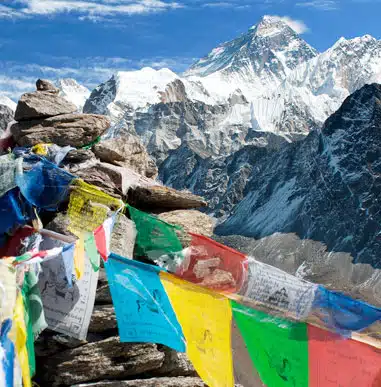
ALPINE ASCENTS BLOG

Diabetes in the Wild
Submission By Morgan McGonagle I was diagnosed with type 1 diabetes when I was 12 years old. As a very active and independent 12-year-old, this was not a convenient diagnosis. I wanted to be outside as much as possible at the time and was planning to attend a summer camp where I would be away […]

Training for Mountaineering Webinar with Steve House
Alpine Ascents International hosted Steve House, founder of Uphill Athlete and author of the training bible for mountaineers and trail runners, Training for the Uphill Athlete, for a free webinar on February 20th. Steve covered the training approach that he used in his own career as a professional climber which he now uses to help […]

Self Love and Wilderness
Submission by Avalon Qian. “Tag responsibly, keep the West wild.” I pause mid-mindless-instagram scroll. This is not the first time I have seen this sentiment in an instagram post or an article about leaving no trace: “Tag responsibly.” “Keep the West wild.” What does this tag mean? I understand the fear that wild places may […]
WHY BOOK WITH ALPINE ASCENTS
Knowledge & expertise.
Alpine Ascents International leads expeditions that have become benchmarks of quality in the climbing community. We operate what we believe is the finest mountaineering school in the country. This expertise is based upon years of accumulated experience-not just from individual mountain guides, but through experience on particular mountains where details are fine-tuned over time.
Our guides are an integral part of Alpine Ascents because they understand and share our climbing principles. These individuals are dedicated to sharing their excellence with others. Many of our guides have been with Alpine Ascents for over five years, with a handful of veterans working with us for most of their careers. The quality of our Guide Staff is the primary difference between us and our competitors.
Environmental Reponsibility
Leave No Trace principles are fundamental to our program, and we encourage all who climb and trek with us to understand proper wilderness practices. We help facilitate this effort by passing on Leave No Trace training and literature to every Alpine Ascents climber.
Partners & Accreditations
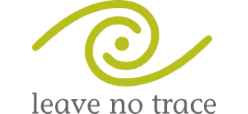
Want to Hike Mount Everest for Free? Good Luck! Inside the Attraction’s Full Cost
Oct. 19 2022, Published 4:48 p.m. ET
Located between Tibet and Nepal in the Himalayas, Mount Everest has long been recognized for testing a mountain climber’s drive and limits. Many travel to the renowned location each year to challenge themselves in ways they never imagined. Those willing to climb Mount Everest agree to journey through the world’s tallest mountain, which is currently measured at 29,032 feet and continues to grow. But how much does it cost to climb Mount Everest ?
Despite Mount Everest’s massive height, the attraction hasn’t had any issues getting travelers to come to climb it for themselves. Nepal welcomes thousands of new people each year willing to experience the extraordinary feat for a hefty price.
So, how much does it cost to hike Mount Everest?
If you thought hiking Mount Everest might not break the bank too much, think again. On average, a trek up Mount Everest can set you back between $30,000 and 160,000, with most people paying $45,000, as mountaineers Alan Arnette and Garrett Madison told The Manual . The hefty price includes several factors travelers must consider before taking the climb.
One significant reason climbing Mount Everest costs as much as it does is that climbers can’t trek the mountain without reliable support. In addition to months of preparation, most climbers look to Sherpas to assist them on their journeys. Sherpas are Tibet locals who live on the Himalayan slopes and offer help with “cooking, carrying gear, and making crucial decisions” for a climber’s survival, as per The Manual.
Although Mount Everest treks don’t require Sherpas, many travelers find they come in handy when the journey starts. However, hiring one will undoubtedly cause a dent in most climbers’ wallets. Sherpas typically cost $5,000, as most charge $3,000 for loading and unloading the gear and an extra $2,000 for cooking fees.
The Mount Everest costs don’t just stop at Sherpas. Mount Everest travelers also need to consider the traveling, food, transportation, permits, gear, equipment, and oxygen costs. Yes, you read that right. The average climber reportedly needs five to six oxygen bottles for a weeklong trip, and these cost $600 a pop. Guests also pay for their ticket and passport to the Himalayas, and around $4,000 to travel around Mount Everest.
High Adventure Expeditions also notes that guests may want to save $1,000 for spending money. If you're going to eat at the popular attraction, meal costs range between $20-30. Then, travelers typically pay around $6,000-8,000 on gear and equipment needed for the trip. However, none of these hefty prices matter if travelers don’t have a permit.
Permits are the only way climbers can access Mount Everest, making it the most extravagant expense. Luckily, there are two ways to get your hands on the esteemed item. Those climbing Everest from the north side of Tibet will need to pay $8,000 for a permit. If one wanted to climb the attraction by way of Nepal, they would cash out $11,000 plus an additional $2,500 to organize the permit through a third-party company.
View this post on Instagram A post shared by Mount Everest Official (@mounteverestofficial)
There are ways to reduce the costs of hiking Mount Everest.
After reviewing the costs, it’s probably not surprising that many of those wanting to hike Mount Everest opt out of the experience. Fortunately, you can still take advantage of Mount Everest’s attractions for reduced costs or free.
Some travelers have received free opportunities by taking advantage of Mount Everest Base Camps. Base Camps allow travelers to experience Everest with around 10 other travelers.
View this post on Instagram A post shared by Ian Taylor Trekking (@iantaylortrekking)
Ian Taylor Trekking , an international trekking company, offers annual base camps on its website. The company also gives climbers a chance to earn a free trip to Everest if they can gather enough people to climb the mountain. However, there’s a catch.
Participants are required to find nine other people willing to pay for the base camp and the rest of the trip’s cost.
Once they do, Ian Taylor Trekking provides pretty much everything you'll need, other than your trip to Nepal, which could still cost thousands.
See the Best Places to See Foliage This Fall
Everything You Need to Know About the New Season of Hiking With Kevin Nealon
Bringing a Dog on Your Hike? Here Are Some Tips to Follow
Latest Travel News and Updates
- ABOUT Green Matters
- Privacy Policy
- Terms of Use
- CONNECT with Green Matters
- Link to Facebook
- Link to Instagram
- Contact us by Email
Opt-out of personalized ads
© Copyright 2024 Green Matters. Green Matters is a registered trademark. All Rights Reserved. People may receive compensation for some links to products and services on this website. Offers may be subject to change without notice.
APRIL SALE: Book now and get up to 60% off!
Everest Base Camp Tours & Trips
Find the right tour package for you through Everest Base Camp. We've got 403 adventures going to Everest Base Camp, starting from just 4 days in length, and the longest tour is 94 days. The most popular month to go is October, which has the most number of tour departures. Find here the best Everest Base Camp trekking companies .
250+ Everest Base Camp tour packages with 2,889 reviews
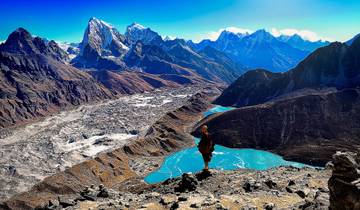
- Hiking & Trekking
- Mountain Hikes
- Christmas & New Year
Everest Base Camp Trek
Well planned, excellent guide and assistant guide.
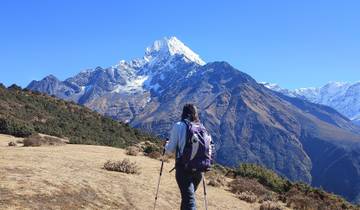
I couldn’t recommend Nepal Hiking team more highly. I was a solo female traveller, and it could not have been a better trip. From the initial booking process the team have been exceptional in their communication and this continued throughout the entire trek. Once arriving in Kathmandu, you are welcomed by a friendly team and the WoodApple hotel was a fantastic place to find your feet in a good location in Kathmandu that’s not too far away from Thamal to ensure you can buy any last minute gear you may need, the food in the rooftop restaurant was excellent and the views of Kathmandu are fantastic. Our Guides Dhurba and Indra were amazing and really helped to ensure this was a trip of a lifetime. The knowledge they have about the Himalayas ensured no question went unanswered and they set a perfect pace for the group to make sure we all reached base camp but also really enjoyed the entire experience with plenty of laughs along the way. If you are considering doing the EBC… do it! And if your considering which company to go with …. Book with ‘Nepal Hiking Team’.

Everest Base Camp Trekking
For those seeking an adventure of a lifetime, we wholeheartedly recommend the trek to Everest Base Camp. It is a journey that pushes your limits, rewards you with stunning landscapes, and provides a deep sense of accomplishment. If you have an adventurous spirit, this trek is an absolute must-do!

Everest Base Camp Trek 12 Days
My trekking guide was wonderful- we felt safe all the way up and down, he was knowledgeable and was telling us stories. I had an amazing, memorable, and fantastic experience! The trek and experience to Everest Base Camp is just once in a lifetime! I’d recommend it anyone with adventurous spirit! And staying overnight at EBC is totally worth it! Highly Recommend! Best Sherpa Expedition and Trekking!

AN incredible trip. Best to get active/be in shape beforehand to fully enjoy it. The guides are incredible and the sights are nothing I had ever seen before. I will remember this trip forever.
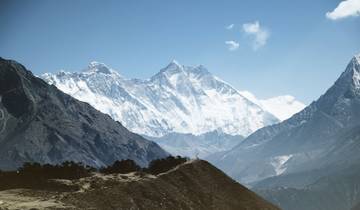
Everest Base Camp (13 Nights 14 Days) Trek
My dream come true...thank you World Travel Experiences team for perfectly arranging my trip to EBC. We really had a great time at Everest region. Highly recommendable..!!!
- 10% deposit on some dates Some departure dates offer you the chance to book this tour with a lower deposit.
- Book With Flexibility This operator allows you to rebook your dates or tours with them for free, waiving change fees.

Good company! I just finished the ABC trek, the guide was super kind and professional.

Everest Base Camp Trek 16-day
They are a group of local Nepalese professional guides who are outstanding in all aspects. It was a very good decision to entrust our first Nepal and Everest trek, including the Kathmandu tour, to them. Ganga, the leader, was very accommodating to any sudden health problems or schedule changes during the itinerary, and the guides worked together as a team and did their best to ensure the best memories for our guests, considering their physical condition. Thanks especially to Uttam! I will never forget seeing Everest at sunset from Kala Patthar. At the end of the trip, in addition to the Certificate, we received some nice souvenirs. The base hotel in the Thamel area of Kathmandu was also very comfortable. From the airport pick-up to the departure, everything was taken care of. I would recommend them to anyone considering a trip to Nepal.

Everest Base Camp Trek with Helicopter Return
In the beginning, I signed up for a group but no one signed up for the same date with me so I ended up doing a solo trip to Everest base camp with my guide and also my porter, Mr.Santa. I was a bit worried at first but then I found lots of friends during the trek to EBC. Mr.Santa took great care of me, always walked behind me to check if everything was going well. Mr. Sheilesh came to the airport to welcome me and dropped me off at the airport at the end of the trip. He was also very kind and open to modifying the plan as I requested. I had a beautiful time in Nepal and wonderful experiences during my EBC trek.
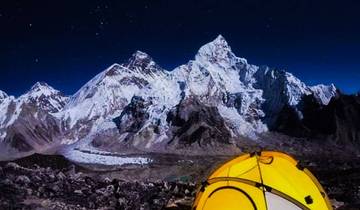
Wow! What an incredible trip to Everest Base Camp with Sherpa Expeditions! The beauty of the mountains was simply breathtaking, with epic scenery that left me in awe at every turn. But what truly made this trek unforgettable was the amazing group of people I had the pleasure of trekking with. The dynamic was so much fun, and everyone was incredibly supportive as we tackled the higher altitudes. Our guide was a true gem - knowledgeable, experienced, and always ready to share fascinating insights about the region. Their presence added so much value to the trek, making it not just an adventure but an educational experience as well. The scenery throughout the journey was nothing short of spectacular, from the lush valleys to the snow-capped peaks. I cannot recommend Sherpa Expeditions highly enough for their exceptional service and support. The entire trip was well-organized, and their attention to detail was evident in every aspect. If you're looking for an unforgettable journey to Everest Base Camp with a fantastic group and unmatched support, Sherpa Expeditions is the way to go!

Everest Base Camp Trek 15 Days Full Board
Nepal Trekking Routes you guys were amazing. They were great to deal with from organising extra hotel stays to adjusting our trek by skipping a rest day (totally our choice) and organising our flights back on time without asking! Mr Bishnu was amazing! He was such a delight to have him along the way with plenty of laughter and jokes! He took care of us by checking on our health and ensuring we were comfortable each day. I loved that he would always walk behind us without fail so we could set the pace. He was always putting us first - Thanks Boss :) I would highly recommend the guys at Nepal trekking routes, very professional, organised and so easy to deal with! Thank you for organising a one in a life time experience for us. Skye & Dan

The guide and the assistance are very friendly. And they are doing very good job from the start to the end.

Epic Everest Base Camp Trek
Geckos Adventures ran a fault free trekking trip for my husband and I to Everest Base Camp in March 2014. Everything was perfect except for my fitness!! I would highly recommend the trip and the experience to anyone with the love of mountains, culture and "yaks" A fantastic time had by all in our group and we have made some life long friends along the way. Perfect tick on the buscket list. Thanks Geckos and your team of hard working guids and porters. The best!

Everest Base Camp Luxury Lodge Trek
I recently trekked on the Everest Base Camp Luxury Lodge Trek with Peregrine Treks during the rainy season, and it was an unforgettable experience. Despite the challenging weather conditions, the team at Peregrine ensured a seamless journey from start to finish. The luxury lodges along the trail were a welcome respite, offering cozy accommodations and delicious meals that exceeded my expectations. Returning to a warm and comfortable lodge after a long day of trekking in the rain was a relief. The staff at each lodge were attentive and friendly, making me feel at home throughout the trip. The trek was breathtaking, with lush green landscapes and dramatic views of the Himalayas. Despite the rainy season, the weather occasionally cleared up, revealing stunning vistas that made every step worthwhile. The knowledgeable guides from Peregrine were invaluable, providing exciting insights into the local culture, history, and geography. While the rainy season brought some challenges, such as slippery trails and occasional rainfall, Peregrine's experienced guides ensured our safety. They were well-prepared with the necessary equipment and provided excellent support throughout the trek. The Everest Base Camp Luxury Lodge Trek with Peregrine Treks and Tours was an exceptional adventure. Despite the rainy season, the luxury lodges, knowledgeable guides, and breathtaking scenery made it a memorable journey. I highly recommend this trek to anyone seeking a unique and luxurious trekking experience in the Everest region.
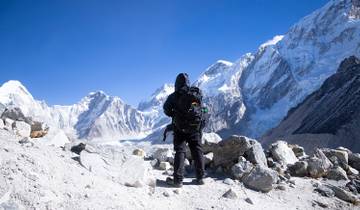
Everest Base Camp Standard Trek- 14 Days
This was my second trek in Nepal and all I can say is that I wish I had used Apex the first time also! The difference between a good guide and a bad guide can severely affect your experience and I can tell you from experience, GYANU IS THE BEST GUIDE!!! He and Ramesh planned everything out perfectly and they took care of every detail. Gyanu is extremely knowledgable about the history and culture of the region and he is excellent at sharing his vast expertise. And apart from being a superb guide, he's also a REALLY nice guy! It was obvious from the outset that he truly cared about the wellbeing of our group and he constantly put in the extra effort to make sure we were taken care of wherever we went. If you're thinking of going to Nepal, Tibet, or Bhutan you should definitely call these guys. I am certain that Apex will take excellent care of you.
What people love about Everest Base Camp Tours
I have already done the review sent from g adventures - another one is duplication.
My Everest Base Camp trek with Sherpa Expedition was nothing short of incredible. The team's attention to detail and dedication to ensuring a safe and enjoyable experience were evident throughout the entire journey. The guides were not only knowledgeable about the area but also incredibly supportive and encouraging. The breathtaking landscapes, challenging yet rewarding trails, and warm hospitality made this trek a once-in-a-lifetime adventure. I am grateful for the memories created and would wholeheartedly endorse Sherpa Expedition for their exceptional service
Everest Base Camp Tours starting in:
- Kathmandu (300)
- Group (372)
- Hiking & Trekking (344)
- Personalized (248)
- Fully Guided (225)
- Active (217)
- Family (188)
- Partially Guided (188)
- Custom (61)
- Explorer (53)
- Private (42)
- In-depth Cultural (22)
- Small Group (258)
- 7 Day Tours (6)
- 10 Day Tours (28)
- 2 Week Tours (137)
- 3 Week Tours (144)
- 4 Week Tours (10)
- Spring 2024 (311)
- Summer 2024 (270)
- Fall / Autumn 2024 (298)
- Winter 2024 / 2025 (258)
- Spring 2025 (196)
- Summer 2025 (151)
- Fall / Autumn 2025 (172)
- Winter 2025 / 2026 (152)
- April 2024 (277)
- May 2024 (312)
- June 2024 (262)
- July 2024 (228)
- August 2024 (240)
- September 2024 (297)
- October 2024 (296)
- November 2024 (284)
- December 2024 (256)
- January 2025 (182)
- February 2025 (175)
- March 2025 (193)
- April 2025 (193)
- May 2025 (186)
- June 2025 (146)
- July 2025 (129)
- August 2025 (138)
- September 2025 (171)
- October 2025 (172)
- November 2025 (170)
Travel Styles
- Budget (68)
- Luxury (35)
- Singles and Solo (210)
- For Couples (64)
- Seniors (118)

Explore an extraordinary adventure tour to the iconic Mount Everest with our carefully curated collection of the 14 best Mount Everest tour packages . Created by local travel experts who know the region intimately, these tours offer an immersive experience in the heart of the majestic Himalayas . From thrilling treks to breathtaking helicopter tours, we have options to suit every adventurer's desire. Join us as we unveil the wonders of Everest and create unforgettable memories in the lap of nature's grandeur.

Everest Base Camp Trek with Helicopter Return

Everest Base Camp Helicopter Tour

Gokyo Valley Trek with Helicopter Return - 8 days

Everest Base Camp Trek - 14 Days

Everest Base Camp Trek 5 Days

Everest Base Camp Trek by Road - 16 Days

Everest View Helicopter Tour with Kalapatthar Landing

Jiri to Everest Base Camp Trekking

Luxury Everest Base Camp Trek - 12 Days

Everest Three Passes Trek

Short Everest Base Camp Trek - 7 Days

Everest View Trek - 8 Days

Everest Circuit Trekking - 17 Days

Gokyo Lake Trek - 11 Days

Gokyo Chola Pass Trekking - 14 Days
Mount everest tour packages facts.
Everest region lets you encounter the highest peak in the world, Mount Everest. Also, the supporting mountains’ panorama is much more mesmerizing. Everest is a paradise for adventure and nature lovers. Mount Everest is the most elevated mountain peak on the Earth above sea level with an ebb and flows official height of 8848 meters (29,029 feet).
It is known as Sagarmatha in Nepali and Chomolungma in the Tibetan language. Sagarmatha is combined with two words, ‘Sagar’ and ‘Matha’, which means ‘sky’ and ‘forehead’. Uniting both, the word Sagarmatha refers to as ‘Forehead of the Sky. It is likewise a worldwide outskirt in China and Nepal.
Mount Everest Tour Difficulty Level
The Mount Everest tours and treks vary in difficulty levels, ranging from easy to moderate. The level of challenge depends on the specific itinerary and trekking route chosen.
Mount Everest Tour Duration
The duration of Mount Everest treks and tours can range from 1 day to 20 days, depending on the chosen itinerary and trekking objectives. Shorter tours, such as the Everest Base Camp Helicopter Tour , provide a condensed experience, while longer treks allow for a more comprehensive exploration of the region.
Mount Everest Tour Environment
The trekking trails to Mount Everest are naturally beautiful, featuring rivers and several suspense bridges that add excitement to the journey. The trails can be moderately busy, but they are well-serviced with tea houses and lodges, providing necessary amenities and accommodations for trekkers.
Max Altitude in Mount Everest Tour
The highest point reached during Mount Everest tours is 5,364 meters at Everest Base Camp (EBC) and 5,643 meters at Kala Patthar. These altitudes offer stunning panoramic views of the surrounding peaks, including Everest itself.
Mount Everest Tour Accommodation
During the Mount Everest tours, accommodation options vary depending on the trekking route and location. Along the trekking trails, there are basic lodges, mid-level tea houses, and luxury lodges up to Lobuche that may offer western toilets. At the higher altitude of Gorekshep, the accommodation is more basic with simple tea houses.
Mount Everest Tour Best Weather
The ideal time to embark on Mount Everest treks is during the months of March to May and October to November. These periods offer favorable weather conditions, with clear skies and stable temperatures. However, other dry seasons can also be recommended for Everest treks.
Mount Everest Tour Transport To/From
To reach the starting point of the Mount Everest treks, trekkers typically take a plane or helicopter flight to Lukla Airport (2,860m). From there, transportation options include jeeps to Sallery or Phaplu Airport, depending on the chosen itinerary.
Everest Entry Documents
To participate in Everest treks, trekkers are required to obtain certain entry documents, including:
Trekkers' Information Management System (TIMS) Card : This card is a registration document that provides trekkers' information and helps in maintaining trekking records.
Sagarmatha National Park Permit: This permit is necessary to enter Sagarmatha National Park, which is home to Mount Everest and its surrounding region.
Additionally, there are no special permits required specifically for the Everest Base Camp trek . However, there may be local government fees of Rs. 2000 to 5000 per person, which are subject to change and should be confirmed with the local authorities.
These Mount Everest tour facts provide essential information for trekkers and adventurers planning to explore the wonders of Everest and its breathtaking surroundings.

Binod Sapkota
We use cookies to ensure that we give you the best experience on our website.

- Last minute guaranteed trips
- Covid Info Hub
- Info nights & events
- How to book
Everest Treks

The Everest region of Nepal is home to the world's most spectacular trekking adventures. It’s here, deep in the Nepalese Himalaya, that you’ll find winding mountain trails dotted with vibrant rhododendrons, stone stupas and fluttering prayer flags, leading you up and on towards the snowcapped peaks of the world’s highest mountains.
Pass prayer wheels, yak herders and remote Sherpa villages as you make your way through the varied landscapes of the Everest valley, trekking in the shadows of some of Earth’s most iconic and spectacular peaks.
Tackle the once-in-a-lifetime journey to Everest Base Camp, add on a trek to the Gokyo Lakes or a climb to the top of Kala Pattar, or join one of our challenging mountaineering expeditions to Mera Peak, Island Peak or Lobuche.
From the glacial rivers, swing bridges and serene alpine scenery of the lower foothills to the imposing mountain faces, gigantic glaciers and lonely moonscapes of the upper altitudes, you’ll never forget the life-changing landscapes after a trek in the Everest Region with the leaders of Everest trekking holidays since 1975.
Destination
Antarctica & the arctic, australasia, central america, central asia, indian subcontinent, middle east, north america, south america, vessels & boats, advanced search, find your everest trip.
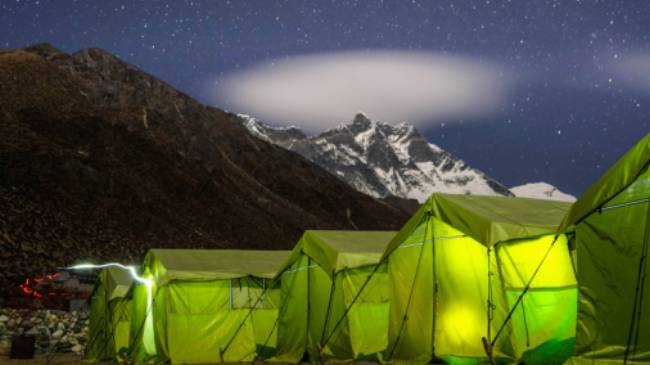
Everest Base Camp Trek in Comfort
Activities:.
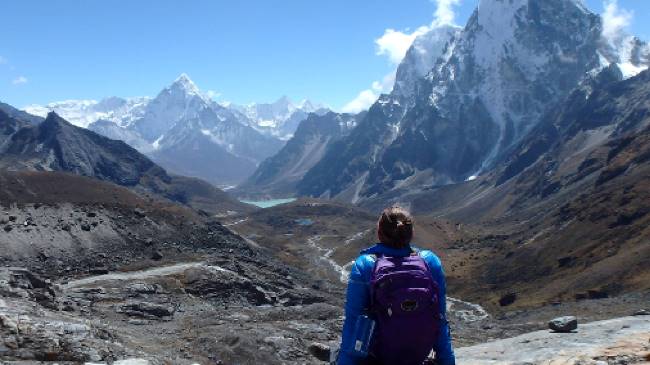
Everest Circuit & the Cho La in Comfort
Moderate to Challenging
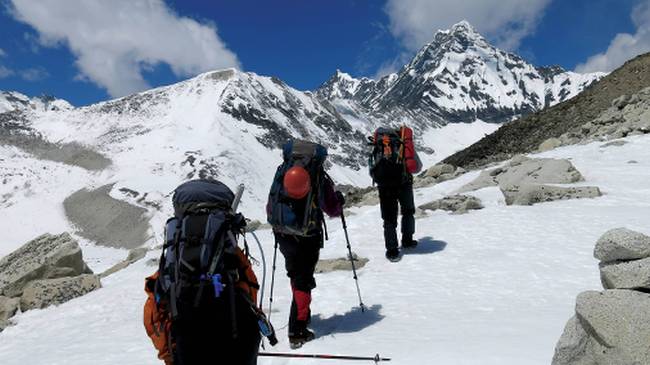
Great Himalaya Trail - The Full Traverse
Intermediate Mountaineering Expedition
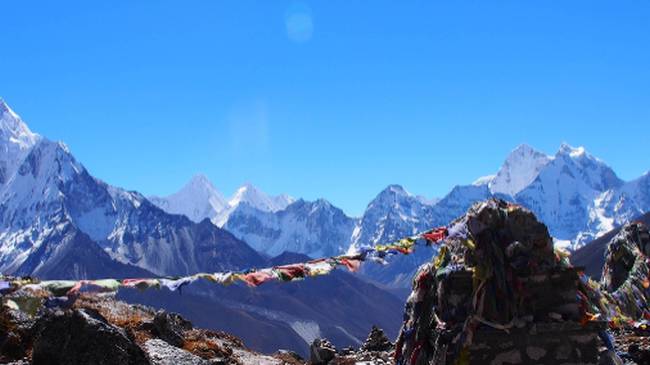
Everest High Passes in Comfort
Challenging
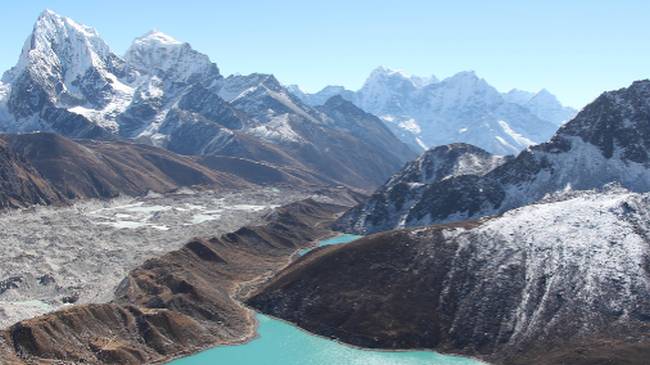
Gokyo & the Renjo La in Comfort
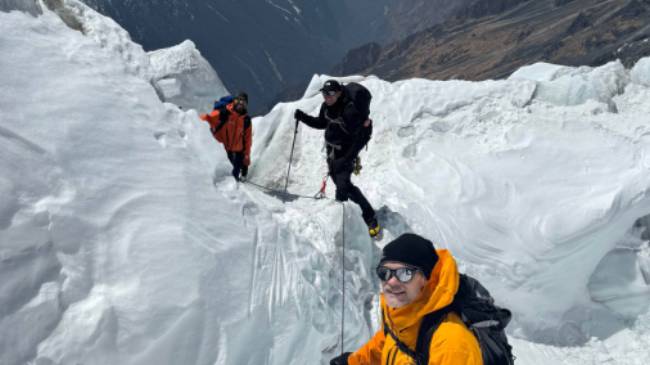
Mountaineering course and Chekigo Peak (6121m) with Soren Kruse Ledet
Entry Level Mountaineering or Exploratory Treks
More about Everest
- Popular activities
- Everest destinations
- Popular travel regions
Why travel with us
Responsible travel, accommodation, leaders in the field, custom made itineraries.
- Related articles
Trip reviews
Country information, everest highlights.
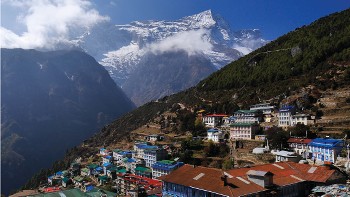
Namche Bazaar
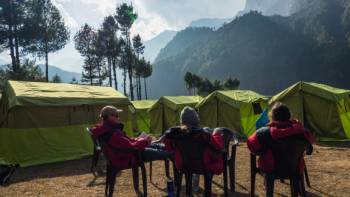
Monjo Eco-Camp
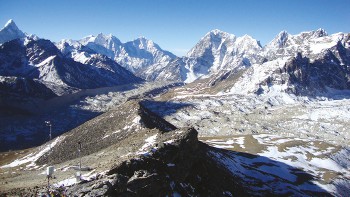
Kala Pattar
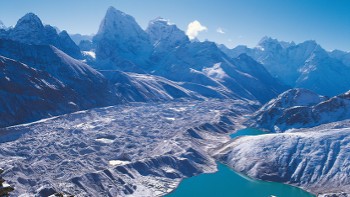
Island Peak
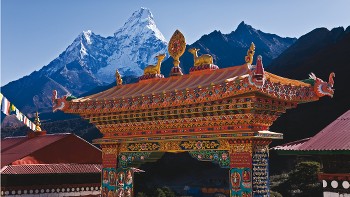
Thyangboche Monastery
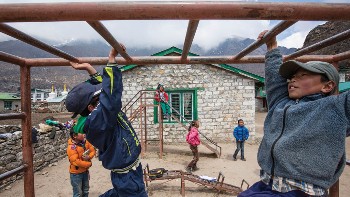
Khumjung School
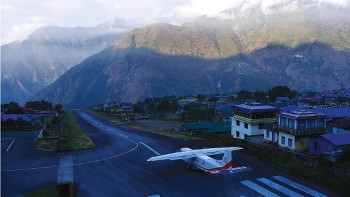
Camping doesn't have to be uncomfortable
Our Exclusive Eco-Comfort camps in the Everest region feature standing height tents, clean beds with mattresses and pillows, a heated dining room, composting sit down toilets and more sustainable features.
Our all inclusive approach
Save money, hassle and time by choosing a trek in the Everest region that includes meals and necessary equipment like sleeping bags and down or fibre fill jackets.
Leaders in Porter Welfare
We're a founding member of the International Porter Protection. Ask us about our Porter Welfare Policy.
Unrivalled experience in the Everest region
We've been operating treks in the Everest regions since 1975.
All meals on trek included
Meals on a two week tea-house based trek in Nepal could cost you more than US$800pp. Many other companies offer cheaper treks by not including meals.
Widest range of Everest treks
Treks for beginners and families to the experienced alpinist.
10 Pieces Litter Initiative
'10 Pieces' is a litter collection initiative where travellers collect 10 pieces of plastic or paper litter on the trail each day.
This simple yet effective initative harnesses the collective power of tourists to keep wilderness trails clean and to educate local communities about the negative impact of litter on their environment and tourism economy.
Regenerative 2030 Project
It is the aim of the World Expeditions Travel Group to integrate ‘regenerative’ projects into every one of our global operations by 2030 and raise funds through the World Expeditions Foundation to support these projects.
Porter Welfare Policies
All porters we employ receive:
- A good working wage that is regulated by the Trekking Agents Association of Nepal and the Labor Union of Nepal, paying as per their guidelines, which are unionized
- We are one of the only trekking companies in Nepal to provide porters with three meals a day, prepared by our cooks, as well as lodging or tents, sleeping mats and blankets.
- Income protection and life insurance
- Access to the same first aid care that travellers receive including emergency helicopter evacuation if required
- A wind and waterproof jacket and over-trousers, woolen socks and gloves, leather or canvas shoes, sunglasses and a warm cap.
All porters carry a maximum of 30kgs (66lbs).
Sustainable Eco-Comfort camps
Our innovative Eco-Comfort camps in the Everest and Annapurna regions contribute to the local economy by providing employment and yearly rent and by bringing trekkers into nearby villages to purchase handicrafts.
The campsites minimise our environmental footprint by using yak or cow dung to fuel heaters, kerosene to cook meals and boil water, rainwater tanks, composting and septic toilets and incinerators to burn paper and non-toxic plastic waste.
Exclusive Eco-Comfort Camps
Comfort and adventure are combined in our private eco-campsites. The campsites are exclusive to World Expeditions, featuring raised beds and high ceiling tents as well as dining and toilet structures. The campsites were designed with the environment in mind, minimising the impact of our presence and providing employment opportunities to local communities.
Wilderness camping
Enjoy fully supported camping in remote locations with our outstanding crew of sherpas, porters and kitchen staff. While the campsite locations have been handpicked for their location, our commitment to responsible travel ensures our footprint is kept to a minimum.
Select locations involve lodges on a twin share basis that provide a comfortable and hygienic environment to relax at the end of the day.
In cities and large towns you will be accommodated in good quality properties that are centrally located, atmospheric and reliable.
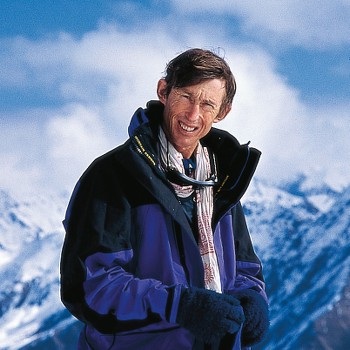
Tim Macartney-Snape
Tim is Australia's best known mountaineer and an inspiring leader whose passion is taking small groups into the most isolated and wildest places. He has climbed Everest [twice], Ama Dablam and Gasherbrum 4, among many others. Tim brings different tangents to exploratory treks with his natural history knowledge and true understanding of the Himalayan culture.
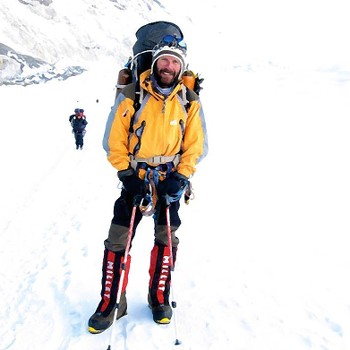
Soren Kruse-Ledet
One of our most experienced leaders; Soren has summitted many Himalayan peaks as well as completed a six month traverse of Nepal, and attempted Everest solo. He has also led many climbs and treks in Nepal, Tibet, China and Bhutan including Cho Oyu. Popular, easy-going and professional, Soren can be found leading various adventures for us in Nepal.
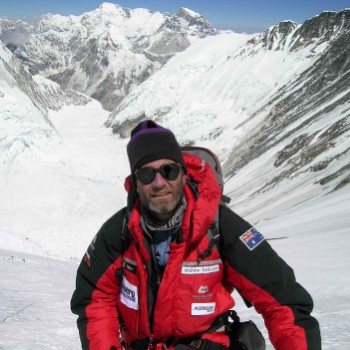
Andrew Lock
Andrew is an inspiring and immensely accomplished adventurer, and a wonderful communicator. In October 2009 he conquered Shishapangma, Tibet, becoming the first Australian to climb all 14 of the world's 8000m peaks - a feat only achieved by a select few worldwide. His achievements include multiple ascents of Everest, Lhotse & Manaslu, five Australian first ascents and establishment of many new routes.
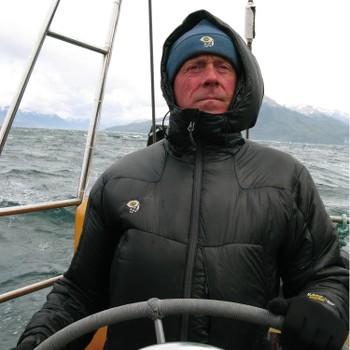
Simon Yates
Simon has been at the forefront of mountaineering for almost two decades with first ascents in the Andes, Himalaya and Karakoram. Best known as Joe Simpson's climbing partner [Touching the Void], he has developed a strong reputation as an engaging expedition leader.
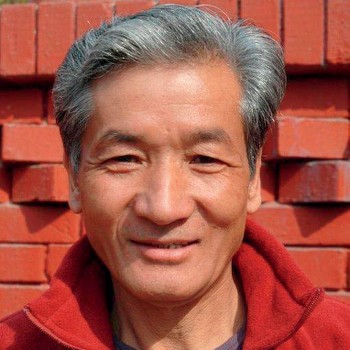
Lhakpa Lama
Based at our desk at the Radisson Hotel, Kathmandu, Lhakpa is always on hand to advise you on the best restaurants, local sightseeing opportunities and to assist with questions on forthcoming treks. Lhakpa has been with World Expeditions for over 20 years. His helpful, cheerful and efficient manner ensures the beginning and end of your Nepal adventure will be smooth, letting you focus on enjoying Kathmandu and preparing for your trek.
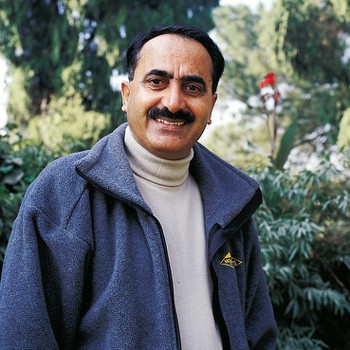
'Mr Din' has been the driving force behind the operation and management of our Nepal trekking program for the past two decades. His tireless commitment to trip quality and focus on responsible tourism practices has ensured that World Expeditions remains at the forefront of the Himalayan trekking scene.

Mrs Uma has been with us nearly 20 years and is the driving force behind our Kathmandu office. Coordinating the details of school and private groups and managing our community project works, her skills are as diverse as her knowledge of achieving the best services and prices for our travellers. We are privileged to have such an effective administrator and negotiator on the team, not to mention Uma's delightful manner when liaising with travellers.
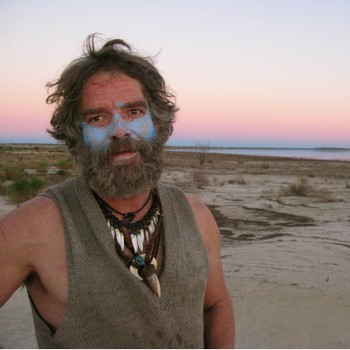
Jon has been at the cutting edge of world adventure for 33 years. Jon reached the summit of Everest alone and completed first ascents of extreme new routes in the Himalaya. An accomplished polar explorer, Jon was the first Australian to trek to both poles with Eric Philips. The culmination of Jon's dedication to adventure was his unsupported traverse of Australia in 2001, where he completed the first unsupported walk to the geographic centre of Australia.
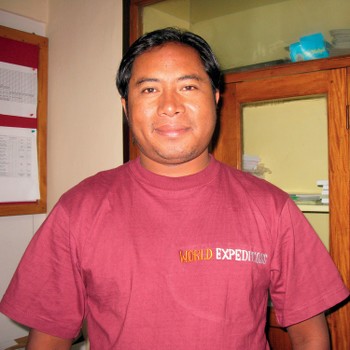
Bir is one of our most versatile leaders, escorting our trekking groups along challenging sections of the Great Himalaya Trail, our family treks in the Annapurna region, private special interest groups to Everest Base Camp and our Mera and Island Peak Expeditions. He has also been instrumental in the organisation of our community projects at the Sanjiwani Health Clinic which has seen positive change for this important medical facility in the lower Annapurnas. Bir is a very popular guide with all groups he is involved with.
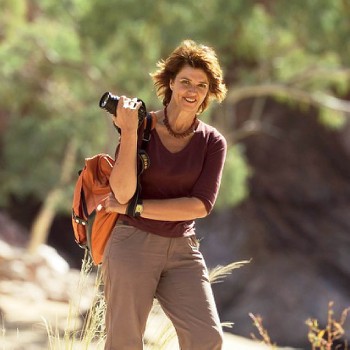
Sorrel Wilby
Sorrel is best known as a television presenter on Channel Nine's Getaway and the ABC's Painting Australia, brings a vast adventure heritage with her. Her adventures began with a 3000km solo trek across Tibet and a pioneering complete Himalaya traverse with her husband. Sorrel has also made a name for herself as an accomplished travel writer, photographer and illustrator.
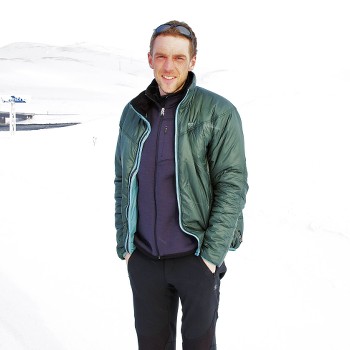
Dr Ross Anderson
Dr Anderson lives with his wife in a small town near the Lakes District in the north of England. He is a family doctor and spends much of his spare time travelling as an expedition doctor. He has more than 10 years of altitude and travel medicine experience. Previous treks and expeditions have focused on the Himalayas, with others in the Scandinavian Arctic and mountainous areas of Africa. He also enjoys trail running, cycling and open-water swimming.
A custom made itinerary is the ultimate way to see the world how YOU want. They are created especially for you, giving you complete freedom to choose what you want to see, where you want to go and when you want to do it. If you love our current itineraries but want to customise it privately as a couple, a group of friends, family, club, business or school, you have the freedom to add or remove as many elements as you like to suit the interests of your group. Alternatively, you can start with a blank canvas and create a new and exciting itinerary from scratch! Our well-travelled consultants can give you firsthand suggestions and eliminate any uncertainty with trip planning to ensure you maximise the quality of your experience and get truly off the beaten track. Simply email, phone or visit us to start planning your dream adventure.
Related Articles
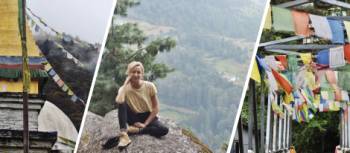
Rating: ☆ ☆ ☆ ☆ ☆ ☆ ☆ ☆ ☆ ☆ ☆ ☆ ☆ ☆ ☆ ☆ ☆ ☆ ☆ ☆ ☆ ☆ ☆ ☆ ☆ ☆ ☆ ☆ ☆ ☆
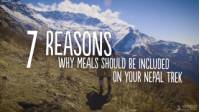
- Where to Go & Weather
- Dialing Code
Electricity
- Health & Safety
Where to Go
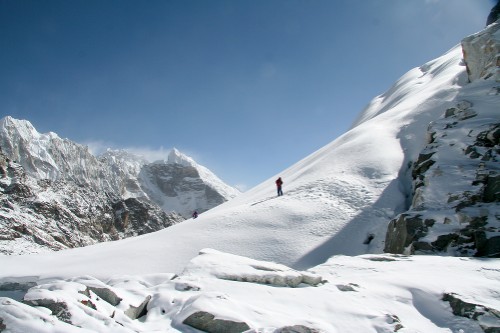
Trek among the gorges, glaciers and snowcapped peaks of the Nepal Himalaya
Explore the religious and cultural treasures of the Kathmandu Valley
Shop for souvenirs and stock up on trekking gear in bustling Kathmandu
Trek to Everest Base Camp
Chill out in pretty Pokhara—‘the jewel in the Himalaya’
Visit the lush landscapes and exotic wildlife of Chitwan National Park
Make the pilgrimage to Lumbini, the sacred birthplace of the Buddha
Experience Nepali culture in vibrant colour at one of the country’s many religious festivals
Enjoy the warm hospitality and relaxing pace of Nepal’s rural communities
Shop for beautiful artworks, handicrafts and textiles made by local artisans
Sample traditional Nepali cuisine at one of the many local restaurants
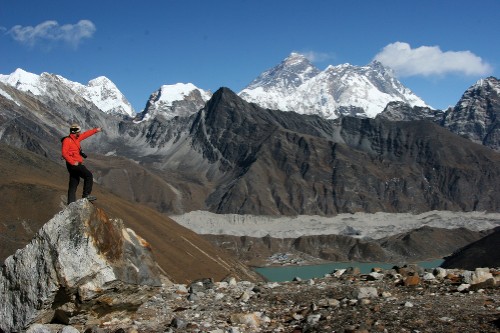
Our trekking season in Nepal extends from mid-September to May. However within this period there are clear seasons in the weather.
Trekking in Nepal during winter, from December to February, offers cool to mild and clear days with often very cold nights. Occasionally winter storms can bring snow as low as 2500m.
In March the cold, dry winter season begins to give way to warmer, spring conditions. Mornings are usually clear with cloud build-up occasionally bringing afternoon rain.
Late spring conditions, in May, are generally hot at low elevations and as the clouds build up to the next monsoon, which generally begins in June, daily afternoon rainstorms are common. This is a period that generally has clear weather at the higher altitudes and is traditionally a time when mountaineering expeditions commence their ascents.
The monsoon creates a rainy season in Nepal, which lasts from mid-June to mid-September. During this time the Nepal Himalaya is unsuitable for trekking, with the exception of a few remote valleys.
During the monsoon in Nepal it is possible to trek in Tibet, the Indian Himalayan regions of Kulu, Garhwal & Ladakh, Central Asia and Pakistan, places that are at their best during this time.
The post-monsoon period - From early September the monsoon rain starts to decrease. By mid-October through to mid-December the weather is usually stable with mild to warm days, cold nights and clear views. Daytime temperatures can reach 25 - 30 degrees Celsius at lower altitudes and decrease as you gain height. Over 3000 meters the daytime temperatures can vary as much as 10 to 20 degrees Celsius, and may be hotter or colder, depending on whether it is sunny or windy etc. At night at lower altitudes, temperatures do not normally drop much, although as you approach November it does get colder and the days shorter. Up high it can drop sharply at night, from 0 to minus 10 or 15 and more when camped on the ice or snow.
The pre-monsoon period - In March the cold, dry winter season begins to give way to warmer, wetter spring conditions. Mornings are usually clear with cloud build-up bringing occasional afternoon rainstorms. Views of the mountains in the middle of the day and afternoon may often be obscured. Daytime temperatures increase quickly in March with temperatures of up to 30 degrees Celsius and mild nights. At higher altitudes it is similar to the conditions of the post-monsoon period, however there is usually more snow, which has accumulated over the winter period. There are spectacular displays of rhododendrons and wildflowers at this time of year. Late spring conditions ie April and May, are generally hot at low elevations and as the clouds build up to the next monsoon, daily afternoon rainstorms are common.
Time in Everest
Nepal is +5:45 ahead of UTC/ GMT
Nepal is a country of high linguistic diversity. 123 different primary languages were reported in Nepal’s 2011 national census—including Nepali (official) 44.6%, Maithali 11.7%, Bhojpuri 6%, Tharu 5.8%, Tamang 5.1%, Newar 3.2%, Magar 3%, Bajjika 3%, Urdu 2.6%, Avadhi 1.9%, Limbu 1.3%, Gurung 1.2%, other 10.4%, unspecified 0.2%
Nepali is Nepal’s official language and also its lingua franca, understood by most in Nepal, and spoken by many living in Bhutan, India and further abroad
Newar (aka Nepal Bhasa; not to be confused with Nepali) is the native language of the Newar people and was Nepal’s official administrative language from the 14th to late 18th centuries, but is now considered by UNESCO to be an endangered language.
English is spoken by many in government, business and tourism sectors, and is part of the core curriculum of Nepal’s education system
In Nepali the local currency is the Nepalese Rupee (NPR). The Nepalese Rupee is different to the Indian Rupee, and the Government of Nepal has banned the import, export and use of 500 and 1000 Indian Rupees notes in Nepal.
It is difficult to convert your NPR back to foreign currency, and you will not be able to exchange NPR once back in your own country. There are many money change shops in Thamel and around Kathmandu where you will also be able to change money, however, note that many places will not allow you to change currency back. There are also ATM’s available for use in Kathmandu.
IMPORTANT NOTE: Nepalese traders do not like TORN notes. Most people will not accept them so ensure you check your notes when exchanging and refuse to accept any torn notes
International Dialing Code
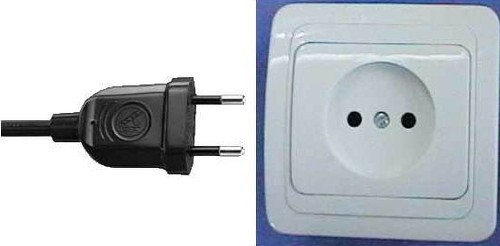
Electricity in Nepal is 230 Volts, at 50 hertz. The most common pin type is C (two round prong).
All nationalities require a visa for Nepal. You will find visa application forms and detailed instructions in your pre departure information kit and the up to date prices for visas obtained in your home country. Please note that if you are applying in Australia you must fill out the visa form provided and paste or staple your photographs in the top right hand corner. However, please note that THE VISA IS ONLY VALID FOR 6 MONTHS FROM THE DATE OF ISSUE, ie. you must enter and depart Nepal within six months of the date of issue of the visa. If you are American or Canadian you will need to obtain application forms for your visa directly from your nearest embassy/consulate.
It is possible to obtain your Nepal visa on arrival at Kathmandu Airport, however this is not ideal as it can cause long delays to your group. At the time of printing the cost is as follows;
15 day tourist visa US$25
30 day tourist visa US$40
90 day tourist visa US$100
(All are multiple entry)
Although the preferred payment is USD, AUD, CAD and GBP will also be accepted very readily.
You can collect the application form required to obtain your visa on arrival, from your reservation consultant or at the Kathmandu Airport on arrival. You should carry two current passport photographs with you, to obtain the visa. These prices are subject to change without notice, however we will do our utmost to keep you informed prior to your departure.
Your safety is our number one concern. Our safety track record is exemplary thanks to careful management and thorough consultation with local partners. Our industry leading risk management procedures have become a skill that we continue to refine. Our leaders in the field are highly trained and have safety as their number one priority. Expert leaders, risk assessments, quality inclusions and your financial security all come standard when you travel with us.
Please refer to our Travel Advisory page for updates on recent events, travel warnings and advice.
We strongly recommend that all clients take out travel insurance at the time of booking to cover against sickness, accident, loss of baggage, unexpected alterations to travel arrangements and travel disruption, emergency evacuation, cancellations, etc. Insurance information is enclosed with your pre-departure information. Please contact us if you would like to obtain a quote for your trip duration.
We suggest that you consult your doctor, local government inoculation centre or a travel medical specialist in order to get the most current advice regarding vaccination requirements.
Money and valuables should always be stored safely when travelling. Keep your passport with you at all times and do not leave it in your main luggage. You will need it to change money and check into hotels. Where safety deposit boxes are available, we recommend that you use them. Keep jewellery and valuables to a minimum.
- Cookie Policy
- Strictly Necessary
- Performance
When you visit any web site, it may store or retrieve information on your browser, mostly in the form of cookies. This information might be about you, your preferences, your device or used to make the site work as you expect it to. The information does not usually identify you directly, but it can give you a more personalized web experience. You can choose not to allow some types of cookies. Click on the different category headings to find out more and change our default settings. However, you should know that blocking some types of cookies may impact your experience on the site and the services we are able to offer.
These cookies are necessary for the website to function and cannot be switched off. They are usually only set in response to actions made by you which amount to a request for services, such as setting your privacy preferences, logging in or filling in forms. You can set your browser to block or alert you about these cookies, but some parts of the site will no longer work. These cookies do not store any personally identifiable information.
These cookies allow us to count visits and traffic sources, so we can measure and improve the performance of our site. They help us know which pages are the most and least popular and see how visitors move around the site. All information these cookies collect is aggregated and therefore anonymous. If you do not allow these cookies, we will not know when you have visited our site.
These cookies allow the provision of enhance functionality and personalization, such as videos and live chats. They may be set by us or by third party providers whose services we have added to our pages. If you do not allow these cookies, then some or all of these features may not function properly.
These cookies are set through our site by our advertising partners. They may be used by those companies to build a profile of your interests and show you relevant ads on other sites and promotional activities through our newsletters. They work by uniquely identifying your browser and device. If you do not allow these cookies, you will not experience our targeted advertising across different websites or via newsletters.
How would you like to continue?
Activate your very own Buddha Air account and get benefited:
- Be the first to receive new offers and discounts
- View your saved flight details and schedules
- Have your preferences pre-filled during booking and payment

- Ticket Status
- Flight Routes
popular Search
- Flight Status
- Destinations
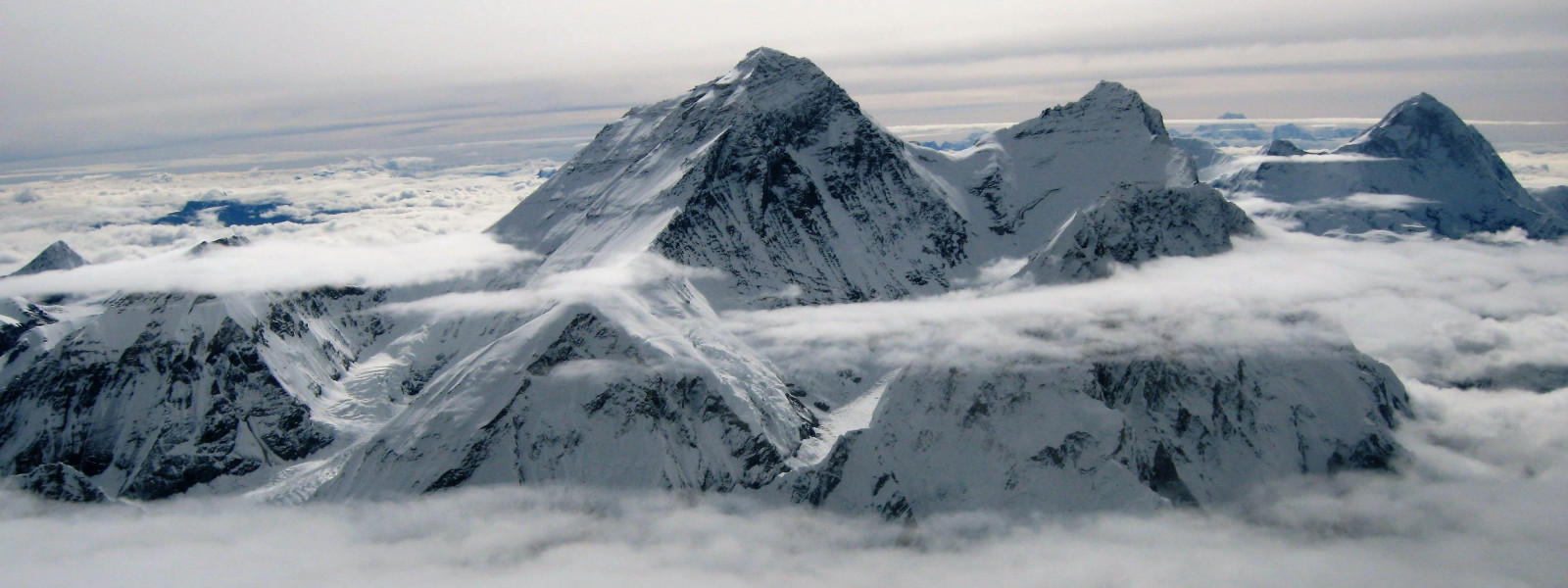
- Afghanistan AF
- American samoa AS
- Anguilla AI
- Argentina AR
- Australia AU
- Azerbaijan AZ
- Bangladesh BD
- Barbados BB
- Bosnia and herzegovina BA
- Botswana BW
- British indian ocean territory IO
- British virgin islands VG
- Bulgaria BG
- Burkina faso BF
- Burma myanmar MM
- Cambodia KH
- Cameroon CM
- Cape verde CV
- Cayman islands KY
- Central african republic CF
- Colombia CO
- Cook islands CK
- Costa rica CR
- Czech republic CZ
- Côte d'ivoire CI
- Democratic republic of congo CD
- Djibouti DJ
- Dominica DM
- Dominican republic DO
- El salvador SV
- Equatorial guinea GQ
- Ethiopia ET
- Falkland islands FK
- Faroe islands FO
- Federated states of micronesia FM
- French guiana GF
- French polynesia PF
- Gibraltar GI
- Greenland GL
- Guadeloupe GP
- Guatemala GT
- Guinea-bissau GW
- Honduras HN
- Hong kong HK
- Indonesia ID
- Kazakhstan KZ
- Kiribati KI
- Kyrgyzstan KG
- Liechtenstein LI
- Lithuania LT
- Luxembourg LU
- Macedonia MK
- Madagascar MG
- Malaysia MY
- Maldives MV
- Marshall islands MH
- Martinique MQ
- Mauritania MR
- Mauritius MU
- Mongolia MN
- Montenegro ME
- Montserrat MS
- Mozambique MZ
- Netherlands NL
- Netherlands antilles AN
- New caledonia NC
- New zealand NZ
- Nicaragua NI
- Norfolk island NF
- North korea KP
- Northern mariana islands MP
- Pakistan PK
- Palestine PS
- Papua new guinea PG
- Paraguay PY
- Philippines PH
- Portugal PT
- Puerto rico PR
- Republic of the congo CG
- Saint barthélemy BL
- Saint helena SH
- Saint kitts and nevis KN
- Saint martin MF
- Saint pierre and miquelon PM
- Saint vincent and the grenadines VC
- San marino SM
- Saudi arabia SA
- Seychelles SC
- Sierra leone SL
- Singapore SG
- Slovakia SK
- Slovenia SI
- Solomon islands SB
- South africa ZA
- South korea KR
- Sri lanka LK
- St. lucia LC
- Suriname SR
- Swaziland SZ
- Switzerland CH
- São tomé and príncipe ST
- Tajikistan TJ
- Tanzania TZ
- Thailand TH
- The bahamas BS
- The gambia GM
- Timor-leste TL
- Trinidad and tobago TT
- Turkmenistan TM
- Turks and caicos islands TC
- United arab emirates AE
- United kingdom GB
- United states US
- Us virgin islands VI
- Uzbekistan UZ
- Vatican city VA
- Venezuela VE
- Wallis and futuna WF
- Zimbabwe ZW
- Kathmandu KTM
- Everest experience MTN
- Annapurna experience MTN
- Bhadrapur (jhapa) BDP
- Bhairahawa BWA
- Bharatpur (chitwan) BHR
- Biratnagar BIR
- Dhangadhi DHI
- Janakpur JKR
- Nepalgunj KEP
- Pokhara PKR
- Rajbiraj RJB
- Surkhet SKH
- Tumlingtar TMI
- Varanasi VNS
- No city found...
Everest Experience
Everest Experience is a close-encounter mountain flight-seeing tour with Buddha Air. Indulge in the panorama and maybe, just maybe, you might realize what you have been missing, or find what you have been looking for, all this while.
After all, a trip to Nepal would be incomplete without truly understanding what really makes it beautiful. The best times to catch a glimpse of the sparkling peaks are the months of winter from September to April. This is the time when the white snow sparkles brightly upon the mountains, with lakes and glaciers equally beaming with clear water flowing down from the Himalayas.
Nothing compares to the sheer beauty or awe the Himalayas has to offer. Take the mother of all mountain flights, the Everest Experience where we put you, one on one with Mt. Everest, so close that you can almost touch it.
Everest From Plane
The flight usually lasts between 50 minutes up to an hour. The planes take off either from TIA, Kathmandu. During the flight, you will catch a glimpse of 20 of the highest peaks to the East of Nepal starting from the Langtang Lirung peak which is the closest peak to Kathmandu, then move towards Mt. Everest in the East and finally fly to Chamlang peak. From there, the plane takes a turn and the passengers get a second look at the view while they make their way back to Kathmandu.
The mountain flight not only allows you to enjoy fantastic views but also helps you to understand the geography of Nepal. Although mountain flights do not have a long history, it has gained popularity among tourists for the beauty that it promises. Buddha Air provides mountain flights every day, early in the mornings, when the Himalayas views are the best!
• Flight starts at 6:00 AM early in the morning • Mt. Everest 20 miles from your window • Witness fantastic Himalayan peaks, lakes and glaciers • 50 minutes flight with guaranteed window seat
While on board, you will receive a 'Himalayan Peaks' map from our flight attendant. This map contains information about the different peaks you will see during the mountain flight. You will also get a briefing from our flight attendant of the visible mountains. You will see stunningly beautiful mountains that are above 8000 meters such as Cho-Oyu, Shisha Pangma, Mt. Everest and Lhotse from a guaranteed window seat on the aircraft .

To commemorate your once-in-a-lifetime experience to the top of the world, we give out a personalized Everest Experience certificate to each passenger after the completion of the flight.
Our travel subsidiary, Buddha Holidays Pvt. Ltd. also has Everest Experience mountain flight as an optional add-on to its itineraries. If you choose to add this splendid flight to your itinerary, Buddha Holidays will provide transport facility between your hotel and the airport.
Everest Flight Testimonials
"This was a great flight to see the Himalayas and Mt Everest. If you are looking to enhance your experience this a remarkable time . The key is to manage your expectations. Weather is always changing. We had to wait 1.5 hours to board and lift off. That may be rather normal. They book the window seats only on both sides of the plane. Outbound the Mts are on your left. The plane will turn left and the right side will see the mountains on the return trip. You are given a map marking the mountains. The flight staff will help you identify the mountains. Understand you will still be a good distance from Everest. You will need to zoom in but the views were spectacular. The plane is very comfortable and we cruised at 21000 ft." Ffitzkew, T ripAdvisor "You are tired after your flight and this early flight is an expensive trip for an 1h of activity. Forget that thinking. You came all the way to Nepal to now miss this breathtakingly wonderful view of the Himalayan Mountain range. Just do it. Everyone gets a window seats, means everyone can take pictures. Don't panic if you are on the "wrong" side of the aisle first and can't take in the mountain views. The plane will turn. You will get the same chance to take great pictures. If I had a bucket list, this woulds have been on there. Useful info: Do a bit of price discovery before you book it.I had not done any research and ended up paying £70 more than had I booked it directly or through another agent. Not a nice feeling when your tour operator, with whom.you are travelling with, does this. They will learn eventually." J_stenm, TripAdvisor "Booked through Intrepid Urban Adventures. It’s an early start for this experience with a 5 am pick up from my hotel. Just 16 people max on the flight in a small aircraft and everyone gets a window seat. The views of the Himalayas were amazing!! We got some great photos out of our windows. It cost about $200 USD but it was worth every penny!" Rebecca E, TripAdvisor "Good experience. Strongly suggest booking it on-line with Buddha Air as we paid a lower price than others. The aircraft are only filled half full so that everyone gets a window seat, you can swap sides as you go and the crew are happy to point out the mountains. Don't worry about the slightly chaotic check-in and boarding system - it works, there may be several identical trips going a few minutes apart, the unusual flight number given will exist, just wait patiently at the gate. You get the vastness of the Himalayas and see Everest of courses ll from two directions, but after a weeks trekking in the mountains themselves I personally felt it all a bit arms length." 88Bradshaw, TripAdvisor
Mountain Flight Aircrafts
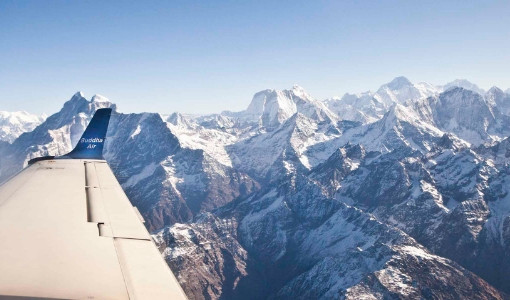
We currently operate mountain flights with a fleet of ATR 72-500, ATR 42-320..
The number of seats available with ATR 42-320 is 24 while on the ATR-72-500, it is 36 seats.
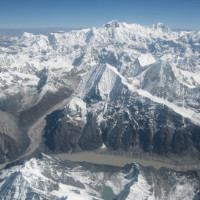
Mount Everest Sightseeing Flight
Mount Everest Flights Schedule
Book flight.

© 2024 Buddha Air Pvt.Ltd. All Rights Reserved.
We've detected unusual activity from your computer network
To continue, please click the box below to let us know you're not a robot.
Why did this happen?
Please make sure your browser supports JavaScript and cookies and that you are not blocking them from loading. For more information you can review our Terms of Service and Cookie Policy .
For inquiries related to this message please contact our support team and provide the reference ID below.
- International edition
- Australia edition
- Europe edition

Tesla shares under pressure after carmaker announces price cuts
CEO Elon Musk postpones India trip ahead of results expected to show worst performance in seven years
- Business live – latest updates
Shares in Tesla came under pressure on Monday after the electric carmaker announced a round of price cuts ahead of a difficult set of results for the company’s chief executive, Elon Musk.
Tesla stock fell as much as 5% in early trading before recovering slightly to a deficit of 3.4% in the wake of the price reductions around the globe, including slashing the cost of three of its leading electric vehicles (EVs) and its self-driving software.
Musk revealed at the weekend that he had postponed a trip to India , including a planned meeting with the prime minister, Narendra Modi, because of “very heavy obligations” at the company.
The CEO faces a key conference call with the investment community on Tuesday, when Tesla’s latest quarterly figures are expected to reveal its worst performance in seven years.
Tesla’s results come amid slowing global demand for EVs and pressure on prices from Chinese rivals. The company has already indicated a poor first quarter in terms of sales, after it revealed this month that deliveries missed market expectations by about 13% .
Tesla attempted to boost demand for its EVs late on Friday by cutting the prices of three of its five models in the US, then went on to cut prices around the world over the weekend, including in China, the Middle East, Africa and Europe.
It cut the US prices of the Model Y, Tesla’s most popular model and the top-selling EV, and also of the older and more expensive Models X and S. Those cuts reduced the starting price for a Model Y to $42,990 (£34,874), and to $72,990 for a Model S and $77,990 for a Model X. It also slashed the US price of its Full Self-Driving driver assistance software from $12,000 to $8,000.
It also emerged on Friday that Tesla was recalling all 3,878 Cybertrucks it has shipped since the vehicle was released in late 2023 because of a faulty accelerator pedal. A filing from the US safety regulator said owners had reported that the pedal pad could come loose and get lodged in the interior trim, causing the vehicle to accelerate unintentionally, increasing the risk of a crash.
Dan Ives, the managing director of the US financial services firm Wedbush Securities, said investors’ reaction to the price cuts on Monday showed they were worried “Tesla is panicking”, as well as reflecting concerns that the reductions would hit margins – a measure of profitability.
Tesla has already reacted to the slowdown by cutting more than 10% of its global workforce , equivalent to at least 14,000 roles.
Musk faces questions on Tuesday about growth in China, plans for a cheaper electric car known as the Model 2 and whether a reported switch in focus to self-driving robotaxis will affect the project. Shares in Tesla have declined more than 40% so far this year. Analysts at Wedbush wrote last week that Tuesday’s conference call represented a “moment of truth” for Musk and Tesla.
after newsletter promotion
“While we have seen much more tenuous times in the Tesla story going back to 2015, 2018, 2020 … this time is clearly a bit different as for the first time many longtime Tesla believers are giving up on the story and throwing in the white towel,” Wedbush wrote in a note to investors.
Reuters reported this month that Tesla had halted development of the Model 2, prompting Musk to post on X that “Reuters is lying”, without citing any inaccuracies.
Musk said this weekend he would reschedule the India trip to a later date this year. He had been due to visit on 21 April and 22 April, where he had been expected to announce an investment of $2bn-3bn in India, according to Reuters, with the spending plans focused on building a new plant.
Musk’s now-postponed visit to Delhi had also been expected to include meetings with executives at space industry startups. The billionaire is awaiting Indian government regulatory approvals to begin offering his Starlink satellite broadband service in the country.
- Automotive industry

How soon can Tesla get its more affordable car to the market?

Bolsonaro supporters hit streets of Rio and hail new hero Elon Musk

Tesla cuts prices around the world as sales decline in a chaotic week

Elon Musk faces Brazil inquiry after defying X court order

Tesla to cut 14,000 jobs as Elon Musk aims to make carmaker ‘lean and hungry’
How much is elon musk to blame for tesla sales slip.

Elon Musk defends stance on diversity and free speech during tense interview

OpenAI fires back at Elon Musk in legal fight over breach of contract claims

Tesla quarterly car deliveries fall for the first time in nearly four years

Tesla settles with former employee over racial discrimination claims
Most viewed.
Enough with airline hidden fees: DOT rules take aim at 'corporate rip-offs'

The Department of Transportation announced new rules on Wednesday to better protect airline passengers against “costly surprise airline fees,” the agency said.
As part of the Biden-Harris Administration’s efforts to crack down on “corporate rip-offs,” two new air travel rules were finalized. The rules mandate airlines to pay full refunds in a timely and straightforward manner and ensure transparency regarding fees associated with air travel.
The new regulations are expected to save consumers over half a billion dollars each year in hidden junk fees, the DOT said.
“Passengers deserve to know upfront what costs they are facing and should get their money back when an airline owes them – without having to ask,” Secretary of Transportation Pete Buttigieg said in a statement.
“Today’s announcements will require airlines to both provide passengers better information about costs before ticket purchase, and promptly provide cash refunds to passengers when they are owed – not only saving passengers time and money, but also preventing headaches.”
Learn more: Best travel insurance
What to know about the newly finalized rules for airline passengers:
What are the new rules from the DOT and how do they impact passengers?
The first new regulation will simplify the process for airline passengers to get what they’re owed by requiring airlines to give automatic cash refunds. Passengers can get these refunds when their flights are “cancelled or significantly changed, their checked bags are significantly delayed, or the ancillary services, like Wi-Fi, they purchased are not provided,” the announcement said.
The second will require airlines and ticket agents to be upfront about any hidden fees, such as checking a bag or changing a flight, to help “consumers avoid unneeded or unexpected charges that can quickly increase and add significant cost to what may, at first, look like a cheap ticket.” Airline fees, increasingly common for airlines to boost their profit, have grown “confusing” for passengers.
Both rules will go into effect in about six months, or around the end of October, the agency said.
Making the skies more accessible: This proposal would help the DOT 'more easily penalize airlines' that damage wheelchairs
How will the new rules make getting refunds from airlines easier?
Getting a refund from airlines is a long-winded and often complicated process. Sometimes, passengers end up getting a travel credit or voucher instead of an actual reimbursement or just a partial refund. Under the new regulation, refunds will be much more straightforward.
Airlines must promptly provide automatic refunds without passengers explicitly requesting them, and the refunds must be issued in the original payment method used to make the purchase.
How fast will the refund get to me?
Airlines will have seven business days to make full refunds for credit card purchases and 20 calendar days for other payment methods.
How else is the DOT cracking down on hidden airline junk fees?
It can be tricky to know exactly how much your final airline ticket will cost due to hidden fees. What may look like a low price at first can quickly add up. Airlines will now have to disclose any baggage, change and cancellation fees and policies before purchases are made – and it has to be clear and upfront, not hidden behind a hyperlink. Airlines will also need to be transparent about weight and dimension limitations. Third-party websites such as Expedia or Booking.com will also be required to display this information.
These days, it’s common for people to pay for seat selection, especially for the lowest price fares, but carriers will now need to inform consumers that seats are guaranteed and it’s unnecessary to pay for one.
The DOT is also banning airlines from using bait-and-switch tactics, in which an airline advertises a discounted fare that doesn’t include mandatory fees that drive the ticket price up.
Kathleen Wong is a travel reporter for USA TODAY based in Hawaii. You can reach her at [email protected] .
Search form
Lax antitrust enforcement linked to rising hospital prices.

(AI-generated image)
A new study co-authored by a Yale economist provides evidence that insufficient antitrust enforcement in the U.S. hospital sector is contributing to reduced competition and higher prices for hospital care.
The study, conducted in collaboration with researchers at Harvard, the University of Chicago, and the University of Wisconsin-Madison, found that of 1,164 mergers among the nation’s approximately 5,000 acute-care hospitals that occurred in the United States from 2000 to 2020, the Federal Trade Commission (FTC), the government agency tasked with preserving competition in the hospital market, challenged only 13 of them — an enforcement rate of about 1%.
The researchers show that the FTC, using standard screening tools available to the agency during that period, could have flagged 20% of the mergers — 238 transactions — as likely to cause reduced competition and increase prices.
The study is available online in the journal American Economic Review: Insights .
If the FTC were optimally targeting enforcement, unchallenged hospital mergers should have had minimal effects on competition and prices, noted the researchers. However, using data on the prices that hospitals negotiate with private insurers, the researchers found that mergers the FTC could have challenged as predictably anti-competitive between 2010 and 2015 eventually led to price increases of 5% or more.
“ It is plainly clear that there has been underenforcement of antitrust laws in the hospital sector,” said study co-author Zack Cooper , an associate professor of health policy at the Yale School of Public Health and of economics in Yale’s Faculty of Arts and Sciences. “We show that about 20% of hospital mergers from 2002 to 2020 could have been easily predicted to increase concentration, lessen competition, and raise prices.
“ Since 2000, hospital prices have grown faster than prices in any other sector of the economy,” Cooper added. “The average price of an inpatient admission is now nearly $25,000. We need to be doing more to preserve competition in U.S. hospital markets.”
Because of steady consolidation in the $1.3 trillion hospital industry — which accounts for 6% of the nation’s GDP — 90% of hospital markets are now highly concentrated, according to the thresholds set by the FTC and the U.S. Department of Justice.
The FTC appears to have had access to the information needed to identify the potentially problematic mergers over the period the study covers, the researchers said, noting that about half of the deals that could be predicted to lessen competition were reportable to the agency under federal law.
Cooper and coauthors Zarek Brot-Goldberg of the University of Chicago, Stuart Craig of the University of Wisconsin-Madison, and Lev Klarnet of Harvard University cite underfunding of the FTC as a potential cause of its lax enforcement activity.
They estimate that the 53 hospital mergers that occurred on average annually from 2010 to 2015 raised health spending on the privately insured by $204 million in the following year alone. Putting this spending increase in context, the researchers note that the FTC’s average annual budget and antitrust enforcement budget between 2010 and 2015 were $315 and $136 million, respectively.
“ We posit that much of the underenforcement is likely a function of a lack of funding for the antitrust enforcement agencies,” said Zarek Brot-Goldberg, an assistant professor at the Harris School at the University of Chicago. “Mergers in the hospital sector are generating short-run harms that roughly approximate the FTC’s entire budget, which suggests the agency might lack sufficient resources to take necessary enforcement action and preserve competition.”
The study found that mergers in rural regions and areas with lower incomes and higher rates of poverty generated larger average price increases, often in outpatient services. The researchers suggest this occurred because those regions — compared with higher income, urban settings — have fewer free-standing clinics that offer surgical and imaging services that compete against hospitals in the outpatient market.
- A Yale economist on taming rising hospital prices while maintaining quality
- In U.S. Senate, Yale scholarship gets a public hearing
Social Sciences
Media Contact
Bess Connolly : [email protected] ,

Rebecca Kramer-Bottiglio wins NSF Alan T. Waterman Award

Meet the FAS faculty: Bhart-Anjan Bhullar

Study identifies driver of liver cancer that could be target for treatment
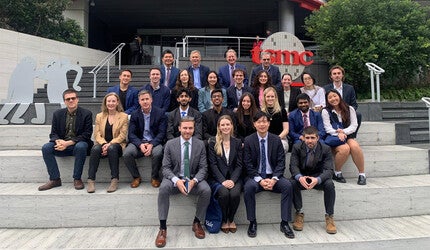
Student trip to Taiwan highlights competition in strategic technology
- Show More Articles

IMAGES
VIDEO
COMMENTS
As of 2021, the average cost for a place on a commercial Everest team, from either Tibet or Nepal, is US$44,500. A minimalist attempt to climb Everest could be organised for about US$20,000. At the very upper level, the private climb option on Futenbach's "signature expedition" comes with the hefty price tag of US$200,000.
International Mountain Guides (IMG) Classic Everest Climb is a Sherpa-guided expedition in which an experienced Sherpa leads climbers throughout the route. IMG charges $49,500 for this model. Climbing The Seven Summits offers a similar program for $48,000. Both companies have increased their prices for 2022.
Everest Climb Permit Cost + Overheads. A Nepal permit to climb Mount Everest currently costs around $11,000 pp. Permits are issued at a price of $70,000 for groups of 7-10 people. If you did for some reason want to purchase an individual permit, this will cost you $25,000.
The cost to climb Mount Everest has continued to skyrocket since we last checked in with Madison 2017. Taking a trip up Everest in 2024 will cost you anywhere from $30,000 to $160,000, with the ...
You will need to eat, stay warm and breath on your trip (97% of all Everest summiteers used supplemental oxygen). ... (Himex), International Mountain Guides (IMG) and others have guided hundreds to the top of Everest for prices ranging from $40,000 to $65,000, all-inclusive. But that is changing. In the last few years, there has been intense ...
Everest Expedition 2024 climb the world's highest peak fully guided by a strong sherpa team and a maximum 02 with premium climbing experience. ... The Trek & Climb leader/guide will try to ensure that the trip runs according to plan, but please be prepared to be flexible if required. ... availability and price. All our fixed departures are ...
The price of your trip includes the following: 1:4 Western guide ratio 1:1 Sherpa to climber ratio on summit day; High Flow Bottled oxygen; Personal equipment carried on the mountain; Helicopter flights Kathmandu-Lukla and return; Expedition Base Camp Doctor; High-end Base Camp and mountain camps; Excellent food and catering; Wi-Fi at Base Camp
AAI went above and beyond the whole trip. Thank you for providing such a great experience. ... Climb Mount Everest Prices. Everest South Col $76,000 (based on 5 climber team) Everest + Lhotse $89,500. Everest Camp II $13,000. Climb Mount Everest Schedules. Everest South Col 2024 Schedule
Discover the ultimate adventure of Mount Everest with TourRadar, the online travel platform that connects you with the best tour operators and packages. Whether you want to trek to the base camp, fly over the summit, or explore the culture and nature of Nepal, you can find your perfect trip among 250+ options. Read real reviews, compare prices, and book now!
By comparison, the average price to climb Everest in 2023 was $55,972, with a median price of $47,995. In 2022, the average price was $55,044, with a median price of $47,498. While China has opened its borders to regular international travel in 2024, climbing permits are limited.
Join our guides and climb Mount Everest, the ultimate expedition ascent - the top of the world. ... Price Does Not Include International airfare ... extra hotel nights, extra meals, tea house showers, etc.) Travel insurance with trip cancellation, medical and evacuation policy; All expenses associated with non ...
Everest South Col. 2024 Schedule April 2 - June 2, 2024 - Register Arrive Kathmandu April 4, end date subject to change. Everest + Lhotse. ... All land prices listed below; round-trip international airfare not included. All land prices are per person, based on double occupancy. SRS available for an additional charge.
On average, a trek up Mount Everest can set you back between $30,000 and 160,000, with most people paying $45,000, as mountaineers Alan Arnette and Garrett Madison told The Manual. The hefty price includes several factors travelers must consider before taking the climb. One significant reason climbing Mount Everest costs as much as it does is ...
Everest Base Camp Tours & Trips. Find the right tour package for you through Everest Base Camp. We've got 403 adventures going to Everest Base Camp, starting from just 4 days in length, and the longest tour is 94 days. The most popular month to go is October, which has the most number of tour departures. Find here the best Everest Base Camp ...
Cost of Everest Base Camp Trek with your own staff. $766 (hike independent) + $500 (guide) + $357 (porter) - starting from $1623. Organizing your own trek with guides and porters sounds very expensive, but is a very affordable way of trekking. Many solo hikers hire a guide that doubles as a company.
Everest Base Camp Trek - 14 Days. Duration: 14 Days Trip Grade: Moderate Trip Type: High-Altitude Adventurous Hike. based on 223 reviews. Price from US $1295 US $1495. In Details. Everest in 5 Days.
Find and book tours and tickets to Mt. Everest. Experience Mt. Everest by buying tickets with Viator. Free cancellation, payment options and millions of reviews.
As you can see on the map, you're on Everest base camp after reaching Gorakshep. It will take 8 hours to get to Gorakshep, Everest Base camp area, at a distance of 14 to 15km. From Gorakshep, you'll go on the trek for Kalapatthat, the trek's highest point. Kalapatthar is your final destination for the Everest base camp trek.
Tackle the once-in-a-lifetime journey to Everest Base Camp, add on a trek to the Gokyo Lakes or a climb to the top of Kala Pattar, or join one of our challenging mountaineering expeditions to Mera Peak, Island Peak or Lobuche. From the glacial rivers, swing bridges and serene alpine scenery of the lower foothills to the imposing mountain faces ...
Mount Everest Sightseeing Flight. The mountain flight that takes you to the landmark of the kingdom, Mount Everest. The daily 1 hour long mountain flight operated by Buddha Air takes you to the top of the world and back to Kathmandu. Fly to the altitude of almost 25,000 ft. with Buddha Air.
Experience the magic of Nepal with My Everest Trip. From the iconic Everest and Annapurna Base Camp treks to lesser-known trails like Manaslu, Upper Mustang, Langtang, Dolpo, and Kanchenjunga, embrace the diversity of Nepal trekking. We also arrange peak climbing adventures and tours to Tibet and Bhutan for a complete Himalayan experience.
The prices usually include permits, round trip flights from Kathmandu to Lukla, accommodation, and meals. However, the booking price won't include visa fees, trekking, and travel insurance. The Everest Base camp Trek is one of the popular trekking destinations for trekkers from all around the world. Conquering the Everest Base Camp is once in ...
The Annapurna Circuit Trek is one of the most popular treks in the world. Join us on this adventure, and we will take you on a journey to discover Nepal and its surreal scenery. Discover the tranquillity of Tilicho Lake, the snow-covered paths of Thorong La, the sacred temple of Muktinath, and the picturesque villages of the Gurungs, Manangis ...
The Gotrax Everest electric dirt bike comes equipped with a 4,000W (8,000W peak) rear-drive motor and a removable 72V battery that work together to reach top speeds of 53 MPH and travel up to 50 ...
The 26-year-old from China's top Fudan University, who uses the pseudonym Lu Wen, died in a hotel near the South Side Base Camp of Everest in Nepal on February 14.
The trip is the latest in a string of high-level engagements that included a summit meeting between President Biden and Chinese leader Xi Jinping in California in November, following a period of ...
Viking Holdings Ltd. and its existing shareholders are seeking to raise as much as $1.1 billion in a New York initial public offering, with the cruise operator looking to go public as the travel ...
Those cuts reduced the starting price for a Model Y to $42,990 (£34,874), and to $72,990 for a Model S and $77,990 for a Model X. It also slashed the US price of its Full Self-Driving driver ...
The Department of Transportation announced new rules for airline passengers to cut down on hidden fees and give straightforward refunds.
"We show that about 20% of hospital mergers from 2002 to 2020 could have been easily predicted to increase concentration, lessen competition, and raise prices. " Since 2000, hospital prices have grown faster than prices in any other sector of the economy," Cooper added. "The average price of an inpatient admission is now nearly $25,000.